Investigate “Marine Paints Manufacturing�. The latest technologies used in Antifouling paint Industry
VerifiedAdded on 2023/01/12
|38
|14347
|60
AI Summary
Contribute Materials
Your contribution can guide someone’s learning journey. Share your
documents today.
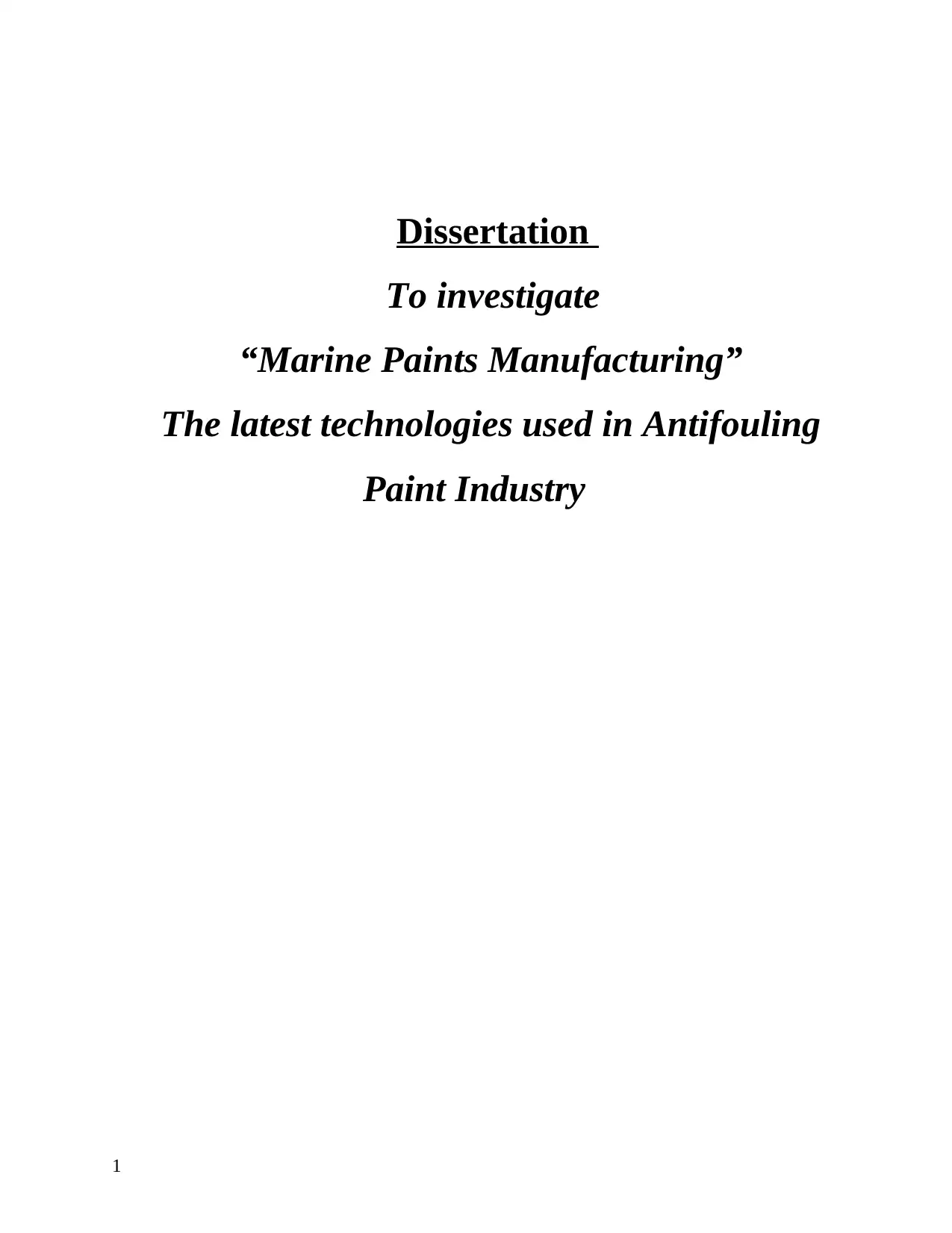
Dissertation
To investigate
“Marine Paints Manufacturing”
The latest technologies used in Antifouling
Paint Industry
1
To investigate
“Marine Paints Manufacturing”
The latest technologies used in Antifouling
Paint Industry
1
Secure Best Marks with AI Grader
Need help grading? Try our AI Grader for instant feedback on your assignments.
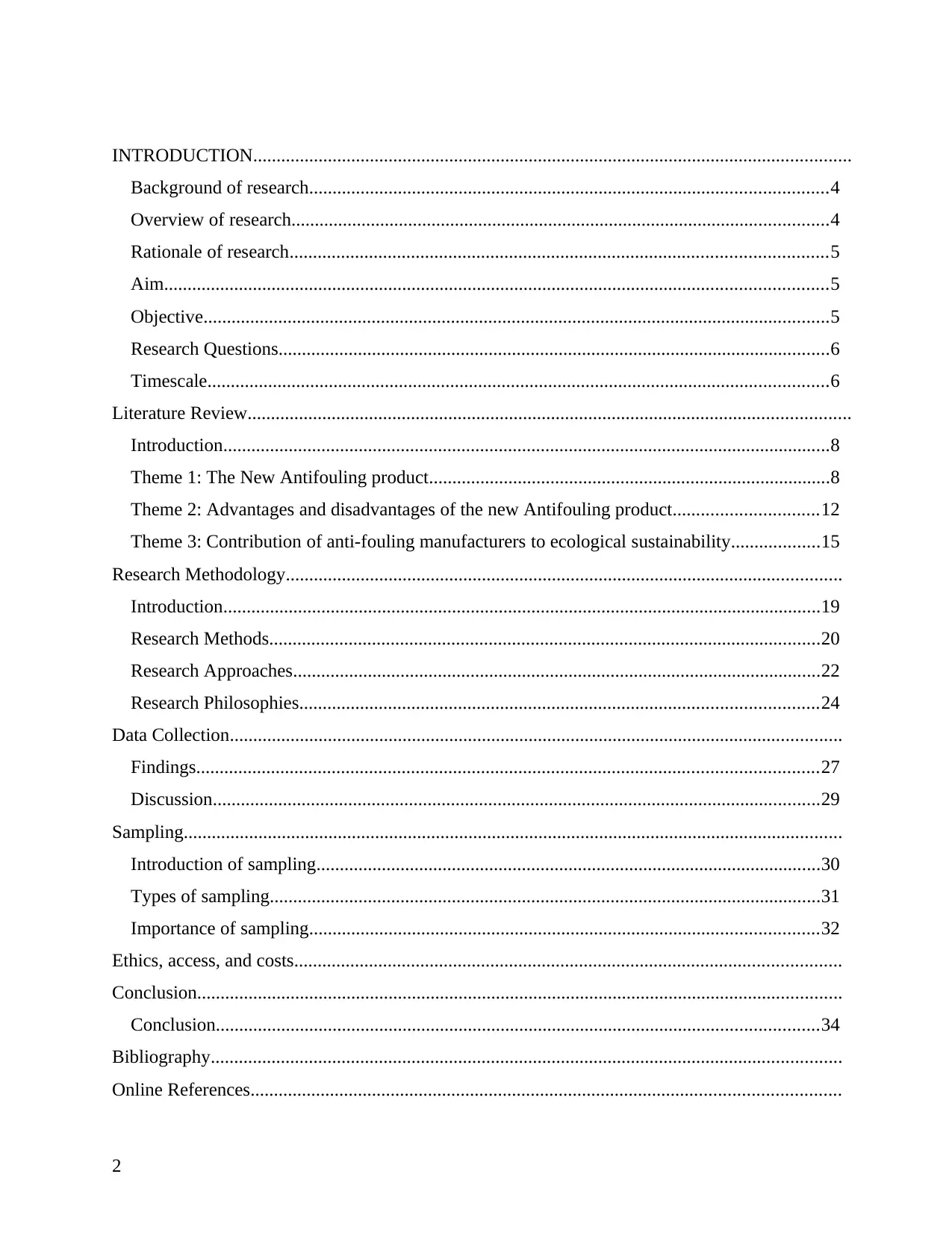
INTRODUCTION................................................................................................................................
Background of research...............................................................................................................4
Overview of research...................................................................................................................4
Rationale of research...................................................................................................................5
Aim..............................................................................................................................................5
Objective......................................................................................................................................5
Research Questions......................................................................................................................6
Timescale.....................................................................................................................................6
Literature Review.................................................................................................................................
Introduction..................................................................................................................................8
Theme 1: The New Antifouling product......................................................................................8
Theme 2: Advantages and disadvantages of the new Antifouling product...............................12
Theme 3: Contribution of anti-fouling manufacturers to ecological sustainability...................15
Research Methodology.......................................................................................................................
Introduction................................................................................................................................19
Research Methods......................................................................................................................20
Research Approaches.................................................................................................................22
Research Philosophies...............................................................................................................24
Data Collection...................................................................................................................................
Findings.....................................................................................................................................27
Discussion..................................................................................................................................29
Sampling.............................................................................................................................................
Introduction of sampling............................................................................................................30
Types of sampling......................................................................................................................31
Importance of sampling.............................................................................................................32
Ethics, access, and costs.....................................................................................................................
Conclusion..........................................................................................................................................
Conclusion.................................................................................................................................34
Bibliography.......................................................................................................................................
Online References..............................................................................................................................
2
Background of research...............................................................................................................4
Overview of research...................................................................................................................4
Rationale of research...................................................................................................................5
Aim..............................................................................................................................................5
Objective......................................................................................................................................5
Research Questions......................................................................................................................6
Timescale.....................................................................................................................................6
Literature Review.................................................................................................................................
Introduction..................................................................................................................................8
Theme 1: The New Antifouling product......................................................................................8
Theme 2: Advantages and disadvantages of the new Antifouling product...............................12
Theme 3: Contribution of anti-fouling manufacturers to ecological sustainability...................15
Research Methodology.......................................................................................................................
Introduction................................................................................................................................19
Research Methods......................................................................................................................20
Research Approaches.................................................................................................................22
Research Philosophies...............................................................................................................24
Data Collection...................................................................................................................................
Findings.....................................................................................................................................27
Discussion..................................................................................................................................29
Sampling.............................................................................................................................................
Introduction of sampling............................................................................................................30
Types of sampling......................................................................................................................31
Importance of sampling.............................................................................................................32
Ethics, access, and costs.....................................................................................................................
Conclusion..........................................................................................................................................
Conclusion.................................................................................................................................34
Bibliography.......................................................................................................................................
Online References..............................................................................................................................
2

3
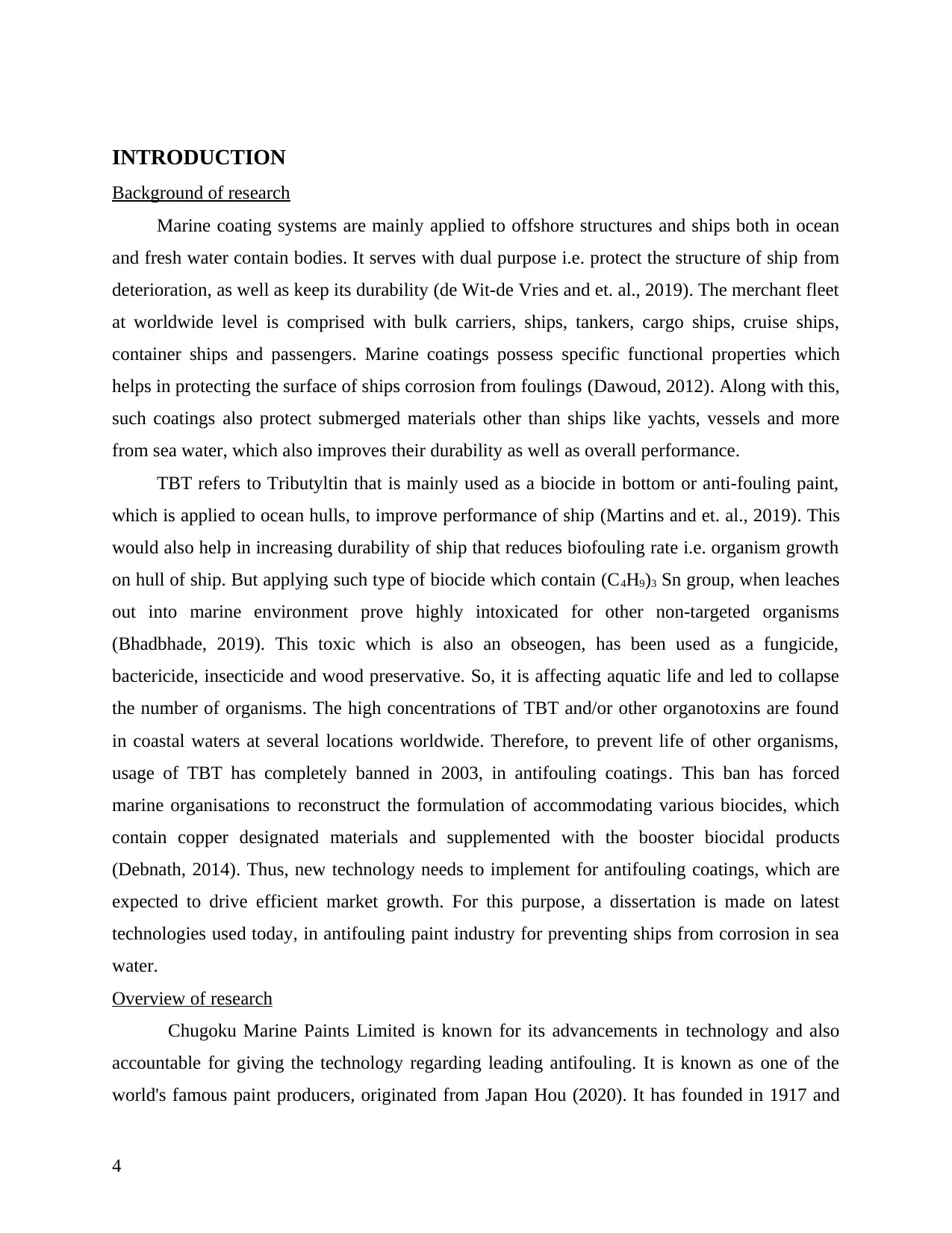
INTRODUCTION
Background of research
Marine coating systems are mainly applied to offshore structures and ships both in ocean
and fresh water contain bodies. It serves with dual purpose i.e. protect the structure of ship from
deterioration, as well as keep its durability (de Wit-de Vries and et. al., 2019). The merchant fleet
at worldwide level is comprised with bulk carriers, ships, tankers, cargo ships, cruise ships,
container ships and passengers. Marine coatings possess specific functional properties which
helps in protecting the surface of ships corrosion from foulings (Dawoud, 2012). Along with this,
such coatings also protect submerged materials other than ships like yachts, vessels and more
from sea water, which also improves their durability as well as overall performance.
TBT refers to Tributyltin that is mainly used as a biocide in bottom or anti-fouling paint,
which is applied to ocean hulls, to improve performance of ship (Martins and et. al., 2019). This
would also help in increasing durability of ship that reduces biofouling rate i.e. organism growth
on hull of ship. But applying such type of biocide which contain (C4H9)3 Sn group, when leaches
out into marine environment prove highly intoxicated for other non-targeted organisms
(Bhadbhade, 2019). This toxic which is also an obseogen, has been used as a fungicide,
bactericide, insecticide and wood preservative. So, it is affecting aquatic life and led to collapse
the number of organisms. The high concentrations of TBT and/or other organotoxins are found
in coastal waters at several locations worldwide. Therefore, to prevent life of other organisms,
usage of TBT has completely banned in 2003, in antifouling coatings. This ban has forced
marine organisations to reconstruct the formulation of accommodating various biocides, which
contain copper designated materials and supplemented with the booster biocidal products
(Debnath, 2014). Thus, new technology needs to implement for antifouling coatings, which are
expected to drive efficient market growth. For this purpose, a dissertation is made on latest
technologies used today, in antifouling paint industry for preventing ships from corrosion in sea
water.
Overview of research
Chugoku Marine Paints Limited is known for its advancements in technology and also
accountable for giving the technology regarding leading antifouling. It is known as one of the
world's famous paint producers, originated from Japan Hou (2020). It has founded in 1917 and
4
Background of research
Marine coating systems are mainly applied to offshore structures and ships both in ocean
and fresh water contain bodies. It serves with dual purpose i.e. protect the structure of ship from
deterioration, as well as keep its durability (de Wit-de Vries and et. al., 2019). The merchant fleet
at worldwide level is comprised with bulk carriers, ships, tankers, cargo ships, cruise ships,
container ships and passengers. Marine coatings possess specific functional properties which
helps in protecting the surface of ships corrosion from foulings (Dawoud, 2012). Along with this,
such coatings also protect submerged materials other than ships like yachts, vessels and more
from sea water, which also improves their durability as well as overall performance.
TBT refers to Tributyltin that is mainly used as a biocide in bottom or anti-fouling paint,
which is applied to ocean hulls, to improve performance of ship (Martins and et. al., 2019). This
would also help in increasing durability of ship that reduces biofouling rate i.e. organism growth
on hull of ship. But applying such type of biocide which contain (C4H9)3 Sn group, when leaches
out into marine environment prove highly intoxicated for other non-targeted organisms
(Bhadbhade, 2019). This toxic which is also an obseogen, has been used as a fungicide,
bactericide, insecticide and wood preservative. So, it is affecting aquatic life and led to collapse
the number of organisms. The high concentrations of TBT and/or other organotoxins are found
in coastal waters at several locations worldwide. Therefore, to prevent life of other organisms,
usage of TBT has completely banned in 2003, in antifouling coatings. This ban has forced
marine organisations to reconstruct the formulation of accommodating various biocides, which
contain copper designated materials and supplemented with the booster biocidal products
(Debnath, 2014). Thus, new technology needs to implement for antifouling coatings, which are
expected to drive efficient market growth. For this purpose, a dissertation is made on latest
technologies used today, in antifouling paint industry for preventing ships from corrosion in sea
water.
Overview of research
Chugoku Marine Paints Limited is known for its advancements in technology and also
accountable for giving the technology regarding leading antifouling. It is known as one of the
world's famous paint producers, originated from Japan Hou (2020). It has founded in 1917 and
4
Secure Best Marks with AI Grader
Need help grading? Try our AI Grader for instant feedback on your assignments.
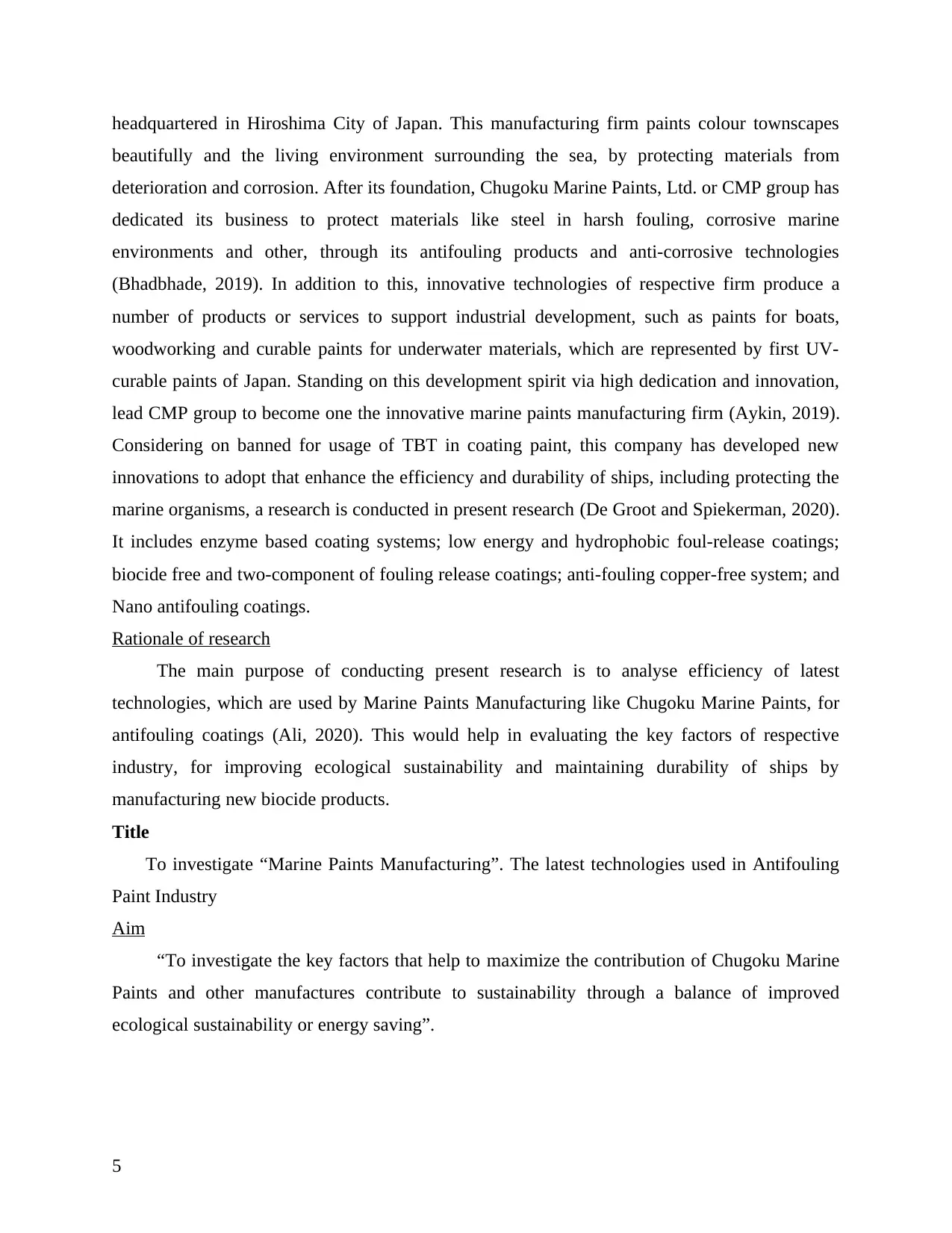
headquartered in Hiroshima City of Japan. This manufacturing firm paints colour townscapes
beautifully and the living environment surrounding the sea, by protecting materials from
deterioration and corrosion. After its foundation, Chugoku Marine Paints, Ltd. or CMP group has
dedicated its business to protect materials like steel in harsh fouling, corrosive marine
environments and other, through its antifouling products and anti-corrosive technologies
(Bhadbhade, 2019). In addition to this, innovative technologies of respective firm produce a
number of products or services to support industrial development, such as paints for boats,
woodworking and curable paints for underwater materials, which are represented by first UV-
curable paints of Japan. Standing on this development spirit via high dedication and innovation,
lead CMP group to become one the innovative marine paints manufacturing firm (Aykin, 2019).
Considering on banned for usage of TBT in coating paint, this company has developed new
innovations to adopt that enhance the efficiency and durability of ships, including protecting the
marine organisms, a research is conducted in present research (De Groot and Spiekerman, 2020).
It includes enzyme based coating systems; low energy and hydrophobic foul-release coatings;
biocide free and two-component of fouling release coatings; anti-fouling copper-free system; and
Nano antifouling coatings.
Rationale of research
The main purpose of conducting present research is to analyse efficiency of latest
technologies, which are used by Marine Paints Manufacturing like Chugoku Marine Paints, for
antifouling coatings (Ali, 2020). This would help in evaluating the key factors of respective
industry, for improving ecological sustainability and maintaining durability of ships by
manufacturing new biocide products.
Title
To investigate “Marine Paints Manufacturing”. The latest technologies used in Antifouling
Paint Industry
Aim
“To investigate the key factors that help to maximize the contribution of Chugoku Marine
Paints and other manufactures contribute to sustainability through a balance of improved
ecological sustainability or energy saving”.
5
beautifully and the living environment surrounding the sea, by protecting materials from
deterioration and corrosion. After its foundation, Chugoku Marine Paints, Ltd. or CMP group has
dedicated its business to protect materials like steel in harsh fouling, corrosive marine
environments and other, through its antifouling products and anti-corrosive technologies
(Bhadbhade, 2019). In addition to this, innovative technologies of respective firm produce a
number of products or services to support industrial development, such as paints for boats,
woodworking and curable paints for underwater materials, which are represented by first UV-
curable paints of Japan. Standing on this development spirit via high dedication and innovation,
lead CMP group to become one the innovative marine paints manufacturing firm (Aykin, 2019).
Considering on banned for usage of TBT in coating paint, this company has developed new
innovations to adopt that enhance the efficiency and durability of ships, including protecting the
marine organisms, a research is conducted in present research (De Groot and Spiekerman, 2020).
It includes enzyme based coating systems; low energy and hydrophobic foul-release coatings;
biocide free and two-component of fouling release coatings; anti-fouling copper-free system; and
Nano antifouling coatings.
Rationale of research
The main purpose of conducting present research is to analyse efficiency of latest
technologies, which are used by Marine Paints Manufacturing like Chugoku Marine Paints, for
antifouling coatings (Ali, 2020). This would help in evaluating the key factors of respective
industry, for improving ecological sustainability and maintaining durability of ships by
manufacturing new biocide products.
Title
To investigate “Marine Paints Manufacturing”. The latest technologies used in Antifouling
Paint Industry
Aim
“To investigate the key factors that help to maximize the contribution of Chugoku Marine
Paints and other manufactures contribute to sustainability through a balance of improved
ecological sustainability or energy saving”.
5
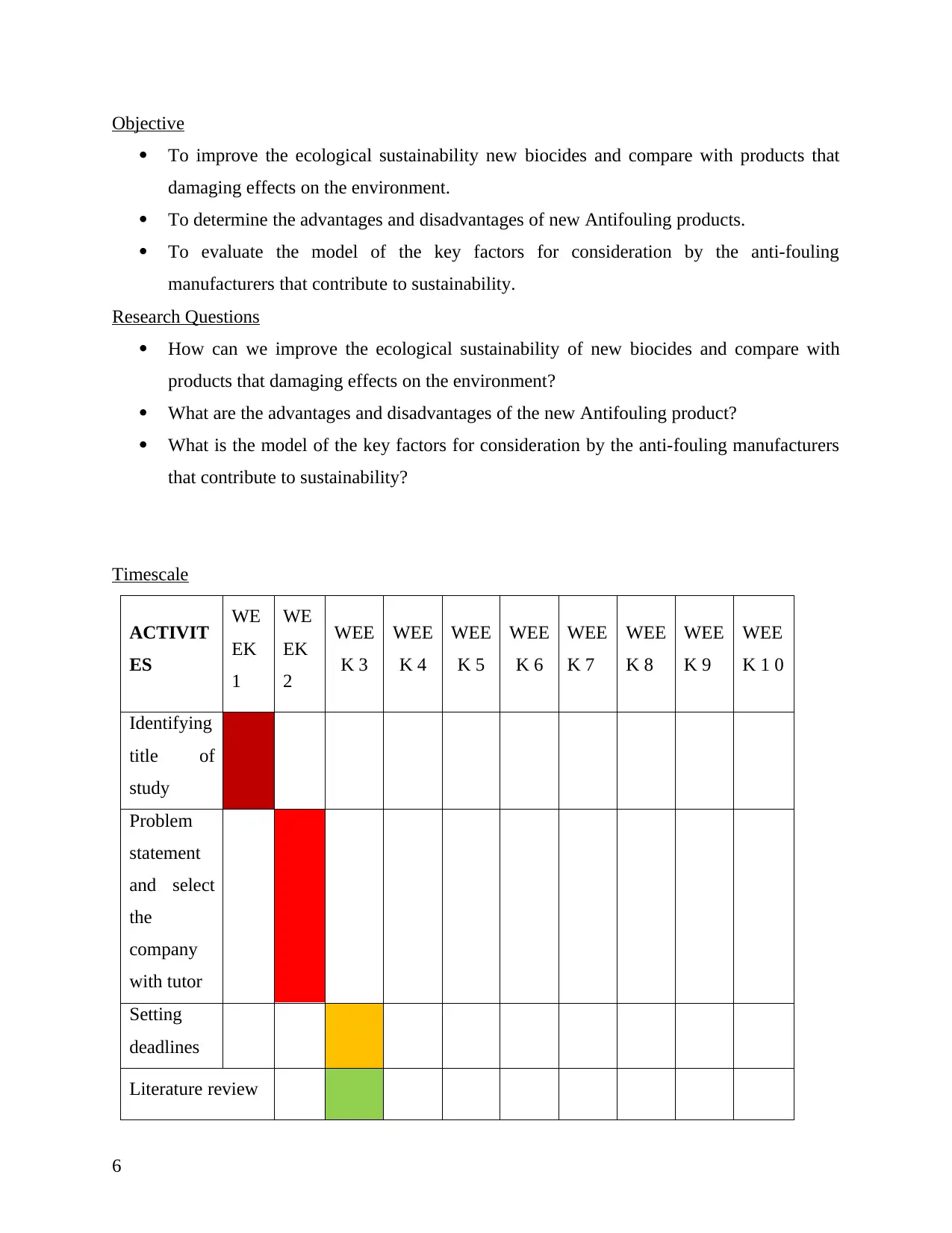
Objective
To improve the ecological sustainability new biocides and compare with products that
damaging effects on the environment.
To determine the advantages and disadvantages of new Antifouling products.
To evaluate the model of the key factors for consideration by the anti-fouling
manufacturers that contribute to sustainability.
Research Questions
How can we improve the ecological sustainability of new biocides and compare with
products that damaging effects on the environment?
What are the advantages and disadvantages of the new Antifouling product?
What is the model of the key factors for consideration by the anti-fouling manufacturers
that contribute to sustainability?
Timescale
ACTIVIT
ES
WE
EK
1
WE
EK
2
WEE
K 3
WEE
K 4
WEE
K 5
WEE
K 6
WEE
K 7
WEE
K 8
WEE
K 9
WEE
K 1 0
Identifying
title of
study
Problem
statement
and select
the
company
with tutor
Setting
deadlines
Literature review
6
To improve the ecological sustainability new biocides and compare with products that
damaging effects on the environment.
To determine the advantages and disadvantages of new Antifouling products.
To evaluate the model of the key factors for consideration by the anti-fouling
manufacturers that contribute to sustainability.
Research Questions
How can we improve the ecological sustainability of new biocides and compare with
products that damaging effects on the environment?
What are the advantages and disadvantages of the new Antifouling product?
What is the model of the key factors for consideration by the anti-fouling manufacturers
that contribute to sustainability?
Timescale
ACTIVIT
ES
WE
EK
1
WE
EK
2
WEE
K 3
WEE
K 4
WEE
K 5
WEE
K 6
WEE
K 7
WEE
K 8
WEE
K 9
WEE
K 1 0
Identifying
title of
study
Problem
statement
and select
the
company
with tutor
Setting
deadlines
Literature review
6
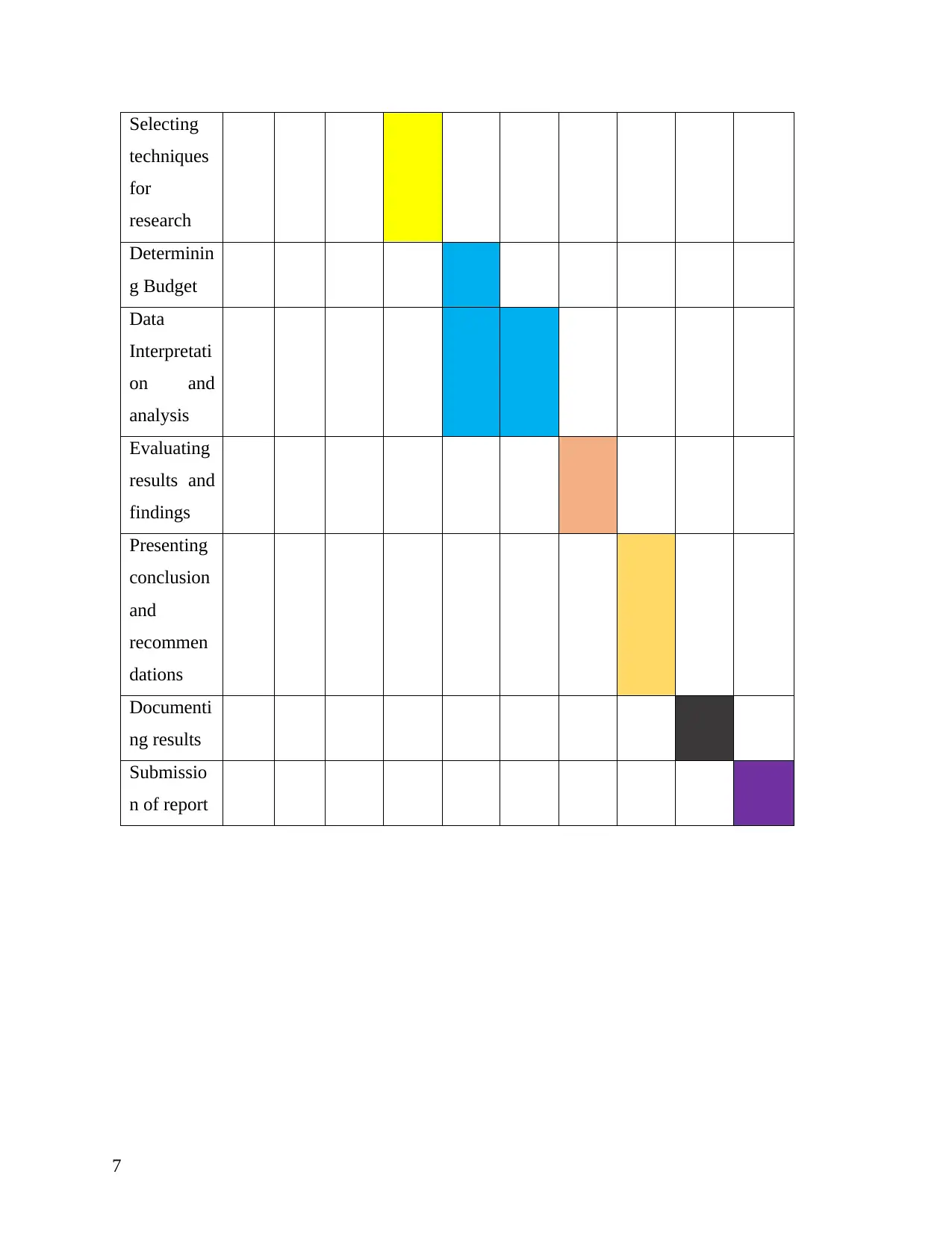
Selecting
techniques
for
research
Determinin
g Budget
Data
Interpretati
on and
analysis
Evaluating
results and
findings
Presenting
conclusion
and
recommen
dations
Documenti
ng results
Submissio
n of report
7
techniques
for
research
Determinin
g Budget
Data
Interpretati
on and
analysis
Evaluating
results and
findings
Presenting
conclusion
and
recommen
dations
Documenti
ng results
Submissio
n of report
7
Paraphrase This Document
Need a fresh take? Get an instant paraphrase of this document with our AI Paraphraser
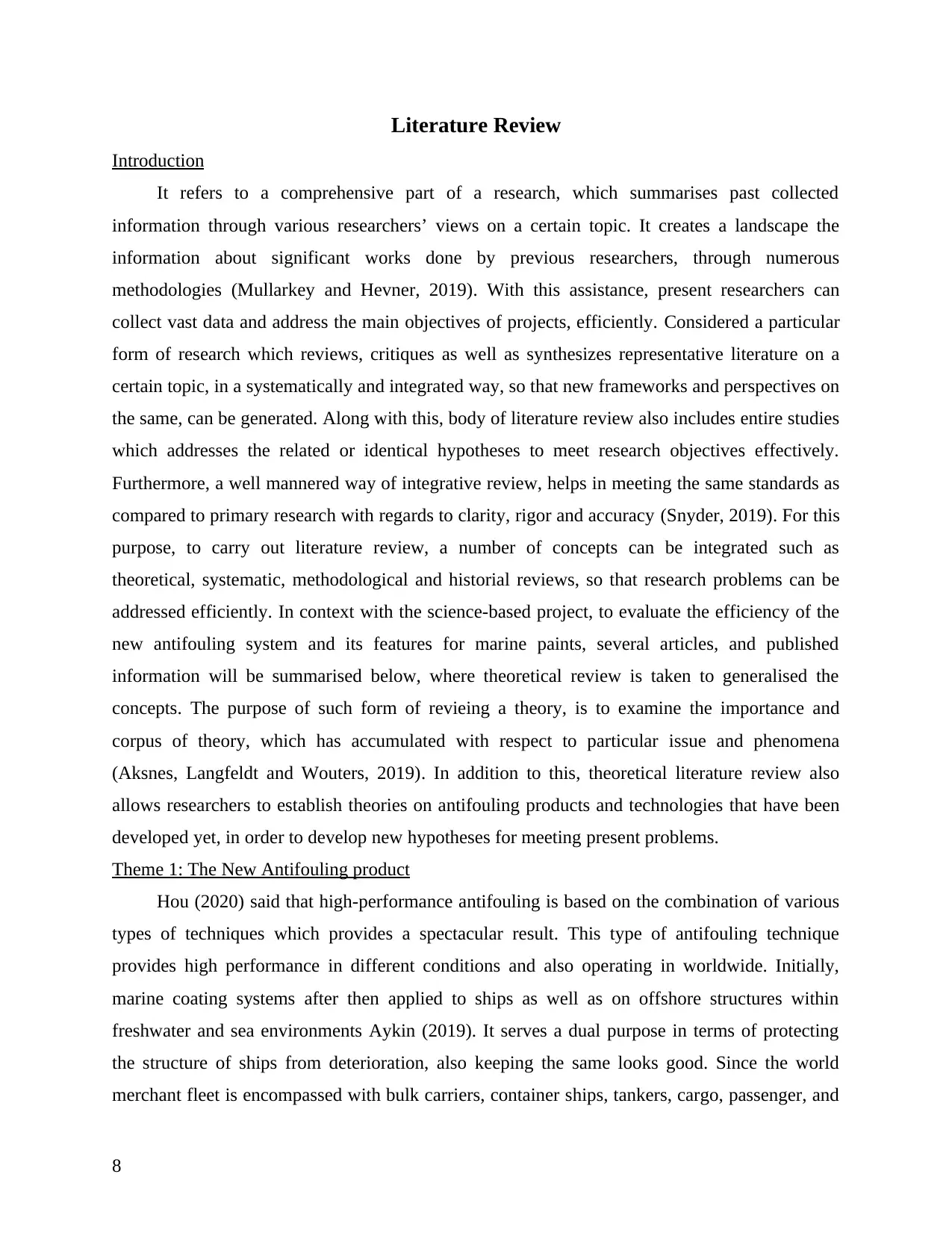
Literature Review
Introduction
It refers to a comprehensive part of a research, which summarises past collected
information through various researchers’ views on a certain topic. It creates a landscape the
information about significant works done by previous researchers, through numerous
methodologies (Mullarkey and Hevner, 2019). With this assistance, present researchers can
collect vast data and address the main objectives of projects, efficiently. Considered a particular
form of research which reviews, critiques as well as synthesizes representative literature on a
certain topic, in a systematically and integrated way, so that new frameworks and perspectives on
the same, can be generated. Along with this, body of literature review also includes entire studies
which addresses the related or identical hypotheses to meet research objectives effectively.
Furthermore, a well mannered way of integrative review, helps in meeting the same standards as
compared to primary research with regards to clarity, rigor and accuracy (Snyder, 2019). For this
purpose, to carry out literature review, a number of concepts can be integrated such as
theoretical, systematic, methodological and historial reviews, so that research problems can be
addressed efficiently. In context with the science-based project, to evaluate the efficiency of the
new antifouling system and its features for marine paints, several articles, and published
information will be summarised below, where theoretical review is taken to generalised the
concepts. The purpose of such form of revieing a theory, is to examine the importance and
corpus of theory, which has accumulated with respect to particular issue and phenomena
(Aksnes, Langfeldt and Wouters, 2019). In addition to this, theoretical literature review also
allows researchers to establish theories on antifouling products and technologies that have been
developed yet, in order to develop new hypotheses for meeting present problems.
Theme 1: The New Antifouling product
Hou (2020) said that high-performance antifouling is based on the combination of various
types of techniques which provides a spectacular result. This type of antifouling technique
provides high performance in different conditions and also operating in worldwide. Initially,
marine coating systems after then applied to ships as well as on offshore structures within
freshwater and sea environments Aykin (2019). It serves a dual purpose in terms of protecting
the structure of ships from deterioration, also keeping the same looks good. Since the world
merchant fleet is encompassed with bulk carriers, container ships, tankers, cargo, passenger, and
8
Introduction
It refers to a comprehensive part of a research, which summarises past collected
information through various researchers’ views on a certain topic. It creates a landscape the
information about significant works done by previous researchers, through numerous
methodologies (Mullarkey and Hevner, 2019). With this assistance, present researchers can
collect vast data and address the main objectives of projects, efficiently. Considered a particular
form of research which reviews, critiques as well as synthesizes representative literature on a
certain topic, in a systematically and integrated way, so that new frameworks and perspectives on
the same, can be generated. Along with this, body of literature review also includes entire studies
which addresses the related or identical hypotheses to meet research objectives effectively.
Furthermore, a well mannered way of integrative review, helps in meeting the same standards as
compared to primary research with regards to clarity, rigor and accuracy (Snyder, 2019). For this
purpose, to carry out literature review, a number of concepts can be integrated such as
theoretical, systematic, methodological and historial reviews, so that research problems can be
addressed efficiently. In context with the science-based project, to evaluate the efficiency of the
new antifouling system and its features for marine paints, several articles, and published
information will be summarised below, where theoretical review is taken to generalised the
concepts. The purpose of such form of revieing a theory, is to examine the importance and
corpus of theory, which has accumulated with respect to particular issue and phenomena
(Aksnes, Langfeldt and Wouters, 2019). In addition to this, theoretical literature review also
allows researchers to establish theories on antifouling products and technologies that have been
developed yet, in order to develop new hypotheses for meeting present problems.
Theme 1: The New Antifouling product
Hou (2020) said that high-performance antifouling is based on the combination of various
types of techniques which provides a spectacular result. This type of antifouling technique
provides high performance in different conditions and also operating in worldwide. Initially,
marine coating systems after then applied to ships as well as on offshore structures within
freshwater and sea environments Aykin (2019). It serves a dual purpose in terms of protecting
the structure of ships from deterioration, also keeping the same looks good. Since the world
merchant fleet is encompassed with bulk carriers, container ships, tankers, cargo, passenger, and
8
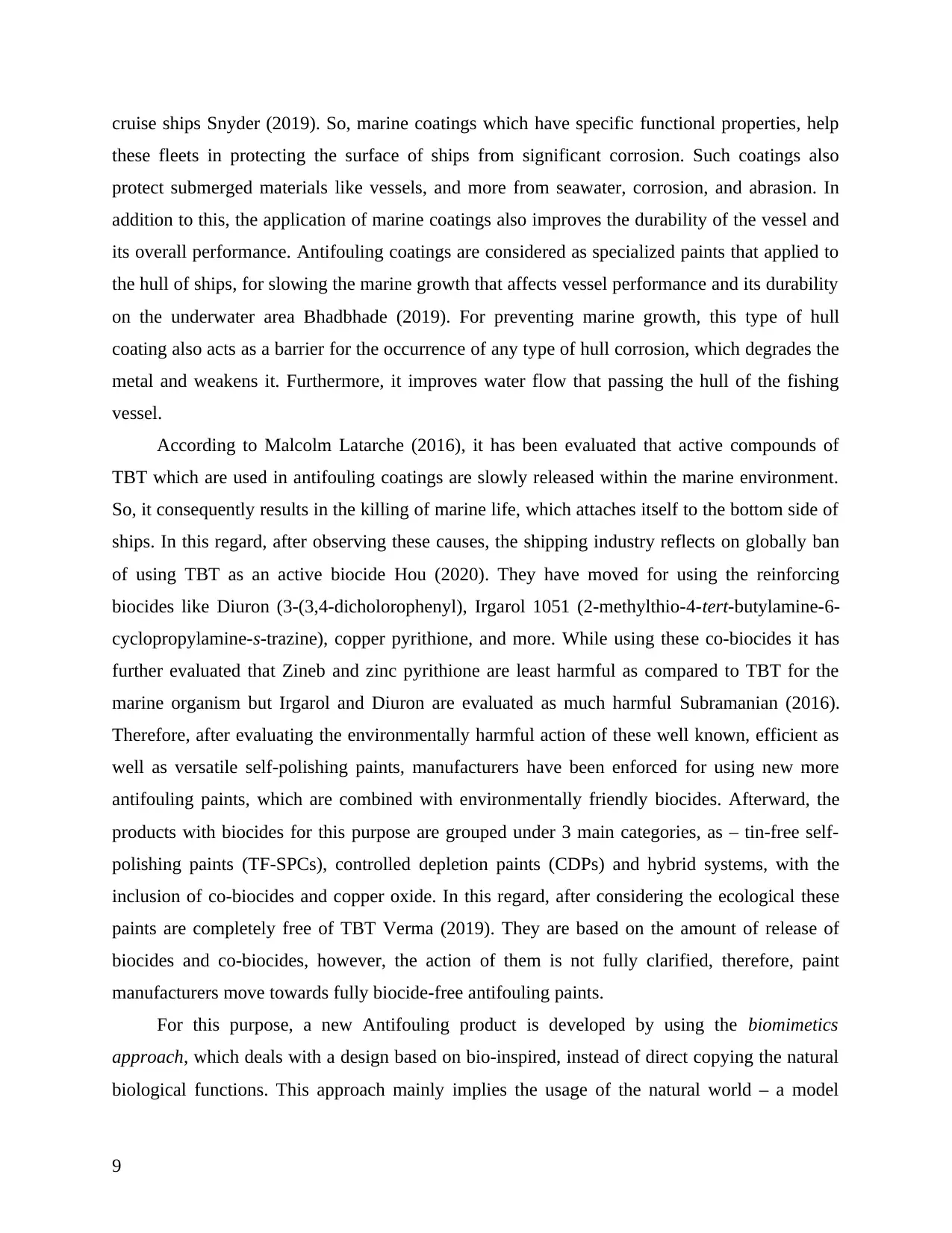
cruise ships Snyder (2019). So, marine coatings which have specific functional properties, help
these fleets in protecting the surface of ships from significant corrosion. Such coatings also
protect submerged materials like vessels, and more from seawater, corrosion, and abrasion. In
addition to this, the application of marine coatings also improves the durability of the vessel and
its overall performance. Antifouling coatings are considered as specialized paints that applied to
the hull of ships, for slowing the marine growth that affects vessel performance and its durability
on the underwater area Bhadbhade (2019). For preventing marine growth, this type of hull
coating also acts as a barrier for the occurrence of any type of hull corrosion, which degrades the
metal and weakens it. Furthermore, it improves water flow that passing the hull of the fishing
vessel.
According to Malcolm Latarche (2016), it has been evaluated that active compounds of
TBT which are used in antifouling coatings are slowly released within the marine environment.
So, it consequently results in the killing of marine life, which attaches itself to the bottom side of
ships. In this regard, after observing these causes, the shipping industry reflects on globally ban
of using TBT as an active biocide Hou (2020). They have moved for using the reinforcing
biocides like Diuron (3-(3,4-dicholorophenyl), Irgarol 1051 (2-methylthio-4-tert-butylamine-6-
cyclopropylamine-s-trazine), copper pyrithione, and more. While using these co-biocides it has
further evaluated that Zineb and zinc pyrithione are least harmful as compared to TBT for the
marine organism but Irgarol and Diuron are evaluated as much harmful Subramanian (2016).
Therefore, after evaluating the environmentally harmful action of these well known, efficient as
well as versatile self-polishing paints, manufacturers have been enforced for using new more
antifouling paints, which are combined with environmentally friendly biocides. Afterward, the
products with biocides for this purpose are grouped under 3 main categories, as – tin-free self-
polishing paints (TF-SPCs), controlled depletion paints (CDPs) and hybrid systems, with the
inclusion of co-biocides and copper oxide. In this regard, after considering the ecological these
paints are completely free of TBT Verma (2019). They are based on the amount of release of
biocides and co-biocides, however, the action of them is not fully clarified, therefore, paint
manufacturers move towards fully biocide-free antifouling paints.
For this purpose, a new Antifouling product is developed by using the biomimetics
approach, which deals with a design based on bio-inspired, instead of direct copying the natural
biological functions. This approach mainly implies the usage of the natural world – a model
9
these fleets in protecting the surface of ships from significant corrosion. Such coatings also
protect submerged materials like vessels, and more from seawater, corrosion, and abrasion. In
addition to this, the application of marine coatings also improves the durability of the vessel and
its overall performance. Antifouling coatings are considered as specialized paints that applied to
the hull of ships, for slowing the marine growth that affects vessel performance and its durability
on the underwater area Bhadbhade (2019). For preventing marine growth, this type of hull
coating also acts as a barrier for the occurrence of any type of hull corrosion, which degrades the
metal and weakens it. Furthermore, it improves water flow that passing the hull of the fishing
vessel.
According to Malcolm Latarche (2016), it has been evaluated that active compounds of
TBT which are used in antifouling coatings are slowly released within the marine environment.
So, it consequently results in the killing of marine life, which attaches itself to the bottom side of
ships. In this regard, after observing these causes, the shipping industry reflects on globally ban
of using TBT as an active biocide Hou (2020). They have moved for using the reinforcing
biocides like Diuron (3-(3,4-dicholorophenyl), Irgarol 1051 (2-methylthio-4-tert-butylamine-6-
cyclopropylamine-s-trazine), copper pyrithione, and more. While using these co-biocides it has
further evaluated that Zineb and zinc pyrithione are least harmful as compared to TBT for the
marine organism but Irgarol and Diuron are evaluated as much harmful Subramanian (2016).
Therefore, after evaluating the environmentally harmful action of these well known, efficient as
well as versatile self-polishing paints, manufacturers have been enforced for using new more
antifouling paints, which are combined with environmentally friendly biocides. Afterward, the
products with biocides for this purpose are grouped under 3 main categories, as – tin-free self-
polishing paints (TF-SPCs), controlled depletion paints (CDPs) and hybrid systems, with the
inclusion of co-biocides and copper oxide. In this regard, after considering the ecological these
paints are completely free of TBT Verma (2019). They are based on the amount of release of
biocides and co-biocides, however, the action of them is not fully clarified, therefore, paint
manufacturers move towards fully biocide-free antifouling paints.
For this purpose, a new Antifouling product is developed by using the biomimetics
approach, which deals with a design based on bio-inspired, instead of direct copying the natural
biological functions. This approach mainly implies the usage of the natural world – a model
9
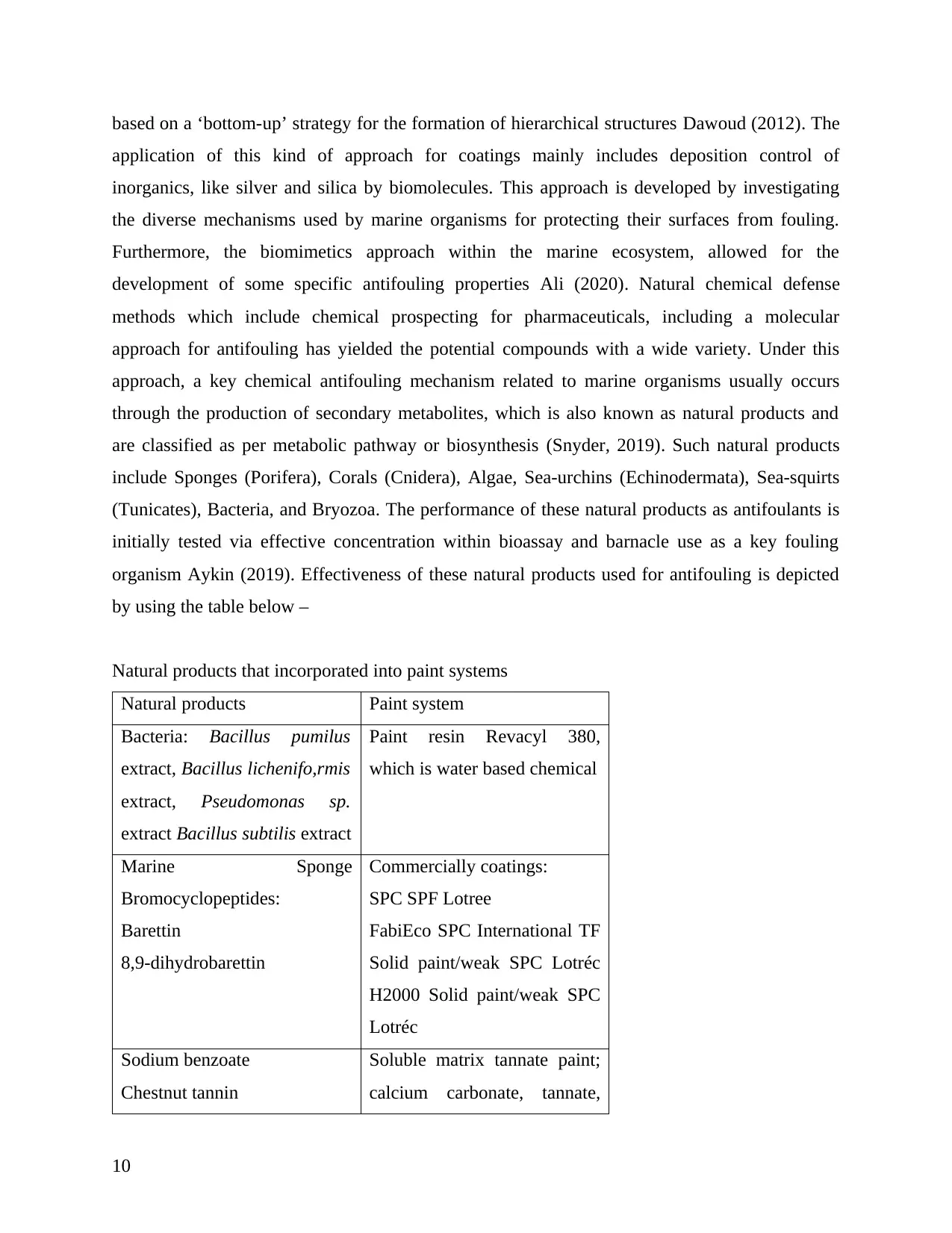
based on a ‘bottom-up’ strategy for the formation of hierarchical structures Dawoud (2012). The
application of this kind of approach for coatings mainly includes deposition control of
inorganics, like silver and silica by biomolecules. This approach is developed by investigating
the diverse mechanisms used by marine organisms for protecting their surfaces from fouling.
Furthermore, the biomimetics approach within the marine ecosystem, allowed for the
development of some specific antifouling properties Ali (2020). Natural chemical defense
methods which include chemical prospecting for pharmaceuticals, including a molecular
approach for antifouling has yielded the potential compounds with a wide variety. Under this
approach, a key chemical antifouling mechanism related to marine organisms usually occurs
through the production of secondary metabolites, which is also known as natural products and
are classified as per metabolic pathway or biosynthesis (Snyder, 2019). Such natural products
include Sponges (Porifera), Corals (Cnidera), Algae, Sea-urchins (Echinodermata), Sea-squirts
(Tunicates), Bacteria, and Bryozoa. The performance of these natural products as antifoulants is
initially tested via effective concentration within bioassay and barnacle use as a key fouling
organism Aykin (2019). Effectiveness of these natural products used for antifouling is depicted
by using the table below –
Natural products that incorporated into paint systems
Natural products Paint system
Bacteria: Bacillus pumilus
extract, Bacillus lichenifo,rmis
extract, Pseudomonas sp.
extract Bacillus subtilis extract
Paint resin Revacyl 380,
which is water based chemical
Marine Sponge
Bromocyclopeptides:
Barettin
8,9-dihydrobarettin
Commercially coatings:
SPC SPF Lotree
FabiEco SPC International TF
Solid paint/weak SPC Lotréc
H2000 Solid paint/weak SPC
Lotréc
Sodium benzoate
Chestnut tannin
Soluble matrix tannate paint;
calcium carbonate, tannate,
10
application of this kind of approach for coatings mainly includes deposition control of
inorganics, like silver and silica by biomolecules. This approach is developed by investigating
the diverse mechanisms used by marine organisms for protecting their surfaces from fouling.
Furthermore, the biomimetics approach within the marine ecosystem, allowed for the
development of some specific antifouling properties Ali (2020). Natural chemical defense
methods which include chemical prospecting for pharmaceuticals, including a molecular
approach for antifouling has yielded the potential compounds with a wide variety. Under this
approach, a key chemical antifouling mechanism related to marine organisms usually occurs
through the production of secondary metabolites, which is also known as natural products and
are classified as per metabolic pathway or biosynthesis (Snyder, 2019). Such natural products
include Sponges (Porifera), Corals (Cnidera), Algae, Sea-urchins (Echinodermata), Sea-squirts
(Tunicates), Bacteria, and Bryozoa. The performance of these natural products as antifoulants is
initially tested via effective concentration within bioassay and barnacle use as a key fouling
organism Aykin (2019). Effectiveness of these natural products used for antifouling is depicted
by using the table below –
Natural products that incorporated into paint systems
Natural products Paint system
Bacteria: Bacillus pumilus
extract, Bacillus lichenifo,rmis
extract, Pseudomonas sp.
extract Bacillus subtilis extract
Paint resin Revacyl 380,
which is water based chemical
Marine Sponge
Bromocyclopeptides:
Barettin
8,9-dihydrobarettin
Commercially coatings:
SPC SPF Lotree
FabiEco SPC International TF
Solid paint/weak SPC Lotréc
H2000 Solid paint/weak SPC
Lotréc
Sodium benzoate
Chestnut tannin
Soluble matrix tannate paint;
calcium carbonate, tannate,
10
Secure Best Marks with AI Grader
Need help grading? Try our AI Grader for instant feedback on your assignments.
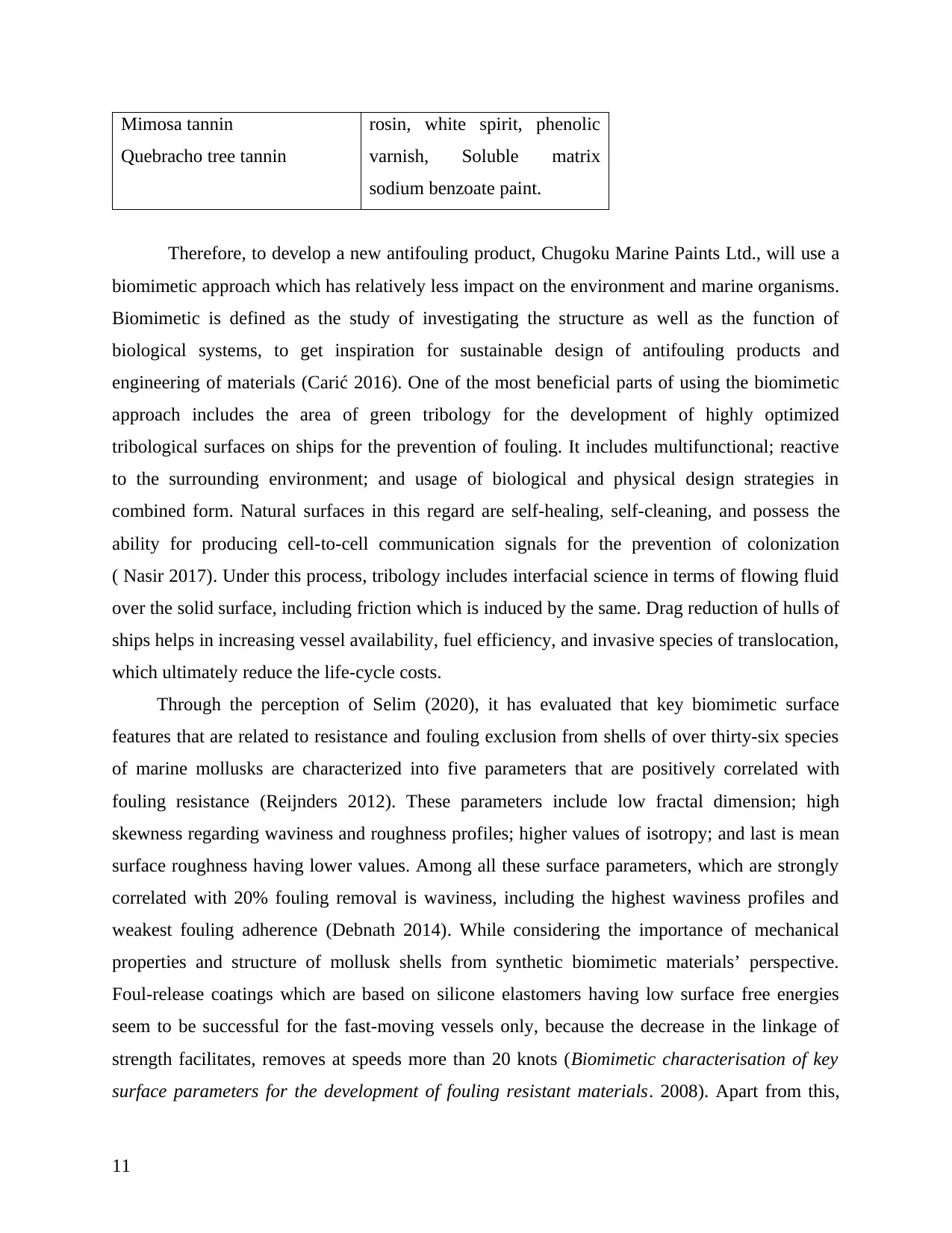
Mimosa tannin
Quebracho tree tannin
rosin, white spirit, phenolic
varnish, Soluble matrix
sodium benzoate paint.
Therefore, to develop a new antifouling product, Chugoku Marine Paints Ltd., will use a
biomimetic approach which has relatively less impact on the environment and marine organisms.
Biomimetic is defined as the study of investigating the structure as well as the function of
biological systems, to get inspiration for sustainable design of antifouling products and
engineering of materials (Carić 2016). One of the most beneficial parts of using the biomimetic
approach includes the area of green tribology for the development of highly optimized
tribological surfaces on ships for the prevention of fouling. It includes multifunctional; reactive
to the surrounding environment; and usage of biological and physical design strategies in
combined form. Natural surfaces in this regard are self-healing, self-cleaning, and possess the
ability for producing cell-to-cell communication signals for the prevention of colonization
( Nasir 2017). Under this process, tribology includes interfacial science in terms of flowing fluid
over the solid surface, including friction which is induced by the same. Drag reduction of hulls of
ships helps in increasing vessel availability, fuel efficiency, and invasive species of translocation,
which ultimately reduce the life-cycle costs.
Through the perception of Selim (2020), it has evaluated that key biomimetic surface
features that are related to resistance and fouling exclusion from shells of over thirty-six species
of marine mollusks are characterized into five parameters that are positively correlated with
fouling resistance (Reijnders 2012). These parameters include low fractal dimension; high
skewness regarding waviness and roughness profiles; higher values of isotropy; and last is mean
surface roughness having lower values. Among all these surface parameters, which are strongly
correlated with 20% fouling removal is waviness, including the highest waviness profiles and
weakest fouling adherence (Debnath 2014). While considering the importance of mechanical
properties and structure of mollusk shells from synthetic biomimetic materials’ perspective.
Foul-release coatings which are based on silicone elastomers having low surface free energies
seem to be successful for the fast-moving vessels only, because the decrease in the linkage of
strength facilitates, removes at speeds more than 20 knots (Biomimetic characterisation of key
surface parameters for the development of fouling resistant materials. 2008). Apart from this,
11
Quebracho tree tannin
rosin, white spirit, phenolic
varnish, Soluble matrix
sodium benzoate paint.
Therefore, to develop a new antifouling product, Chugoku Marine Paints Ltd., will use a
biomimetic approach which has relatively less impact on the environment and marine organisms.
Biomimetic is defined as the study of investigating the structure as well as the function of
biological systems, to get inspiration for sustainable design of antifouling products and
engineering of materials (Carić 2016). One of the most beneficial parts of using the biomimetic
approach includes the area of green tribology for the development of highly optimized
tribological surfaces on ships for the prevention of fouling. It includes multifunctional; reactive
to the surrounding environment; and usage of biological and physical design strategies in
combined form. Natural surfaces in this regard are self-healing, self-cleaning, and possess the
ability for producing cell-to-cell communication signals for the prevention of colonization
( Nasir 2017). Under this process, tribology includes interfacial science in terms of flowing fluid
over the solid surface, including friction which is induced by the same. Drag reduction of hulls of
ships helps in increasing vessel availability, fuel efficiency, and invasive species of translocation,
which ultimately reduce the life-cycle costs.
Through the perception of Selim (2020), it has evaluated that key biomimetic surface
features that are related to resistance and fouling exclusion from shells of over thirty-six species
of marine mollusks are characterized into five parameters that are positively correlated with
fouling resistance (Reijnders 2012). These parameters include low fractal dimension; high
skewness regarding waviness and roughness profiles; higher values of isotropy; and last is mean
surface roughness having lower values. Among all these surface parameters, which are strongly
correlated with 20% fouling removal is waviness, including the highest waviness profiles and
weakest fouling adherence (Debnath 2014). While considering the importance of mechanical
properties and structure of mollusk shells from synthetic biomimetic materials’ perspective.
Foul-release coatings which are based on silicone elastomers having low surface free energies
seem to be successful for the fast-moving vessels only, because the decrease in the linkage of
strength facilitates, removes at speeds more than 20 knots (Biomimetic characterisation of key
surface parameters for the development of fouling resistant materials. 2008). Apart from this,
11
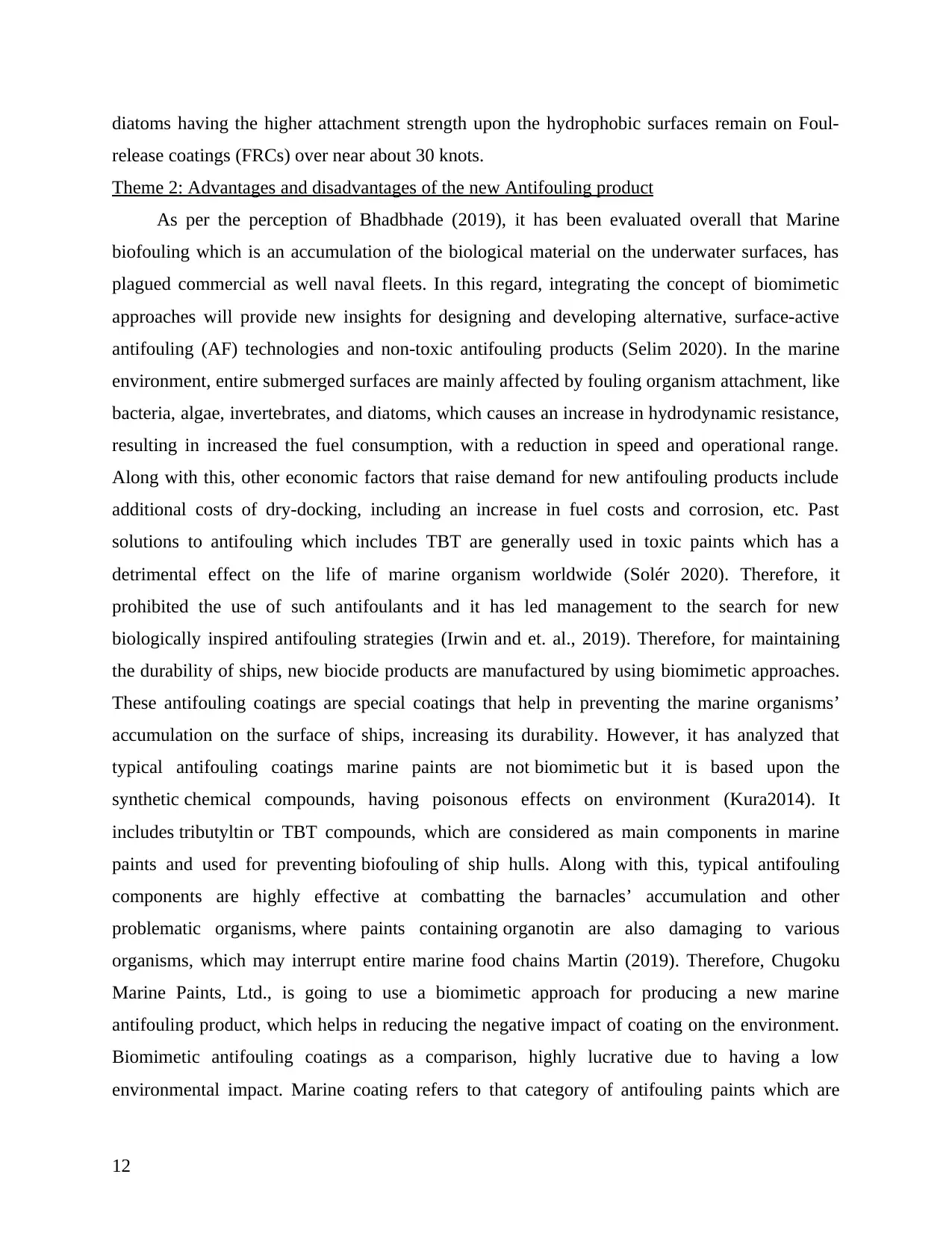
diatoms having the higher attachment strength upon the hydrophobic surfaces remain on Foul-
release coatings (FRCs) over near about 30 knots.
Theme 2: Advantages and disadvantages of the new Antifouling product
As per the perception of Bhadbhade (2019), it has been evaluated overall that Marine
biofouling which is an accumulation of the biological material on the underwater surfaces, has
plagued commercial as well naval fleets. In this regard, integrating the concept of biomimetic
approaches will provide new insights for designing and developing alternative, surface-active
antifouling (AF) technologies and non-toxic antifouling products (Selim 2020). In the marine
environment, entire submerged surfaces are mainly affected by fouling organism attachment, like
bacteria, algae, invertebrates, and diatoms, which causes an increase in hydrodynamic resistance,
resulting in increased the fuel consumption, with a reduction in speed and operational range.
Along with this, other economic factors that raise demand for new antifouling products include
additional costs of dry-docking, including an increase in fuel costs and corrosion, etc. Past
solutions to antifouling which includes TBT are generally used in toxic paints which has a
detrimental effect on the life of marine organism worldwide (Solér 2020). Therefore, it
prohibited the use of such antifoulants and it has led management to the search for new
biologically inspired antifouling strategies (Irwin and et. al., 2019). Therefore, for maintaining
the durability of ships, new biocide products are manufactured by using biomimetic approaches.
These antifouling coatings are special coatings that help in preventing the marine organisms’
accumulation on the surface of ships, increasing its durability. However, it has analyzed that
typical antifouling coatings marine paints are not biomimetic but it is based upon the
synthetic chemical compounds, having poisonous effects on environment (Kura2014). It
includes tributyltin or TBT compounds, which are considered as main components in marine
paints and used for preventing biofouling of ship hulls. Along with this, typical antifouling
components are highly effective at combatting the barnacles’ accumulation and other
problematic organisms, where paints containing organotin are also damaging to various
organisms, which may interrupt entire marine food chains Martin (2019). Therefore, Chugoku
Marine Paints, Ltd., is going to use a biomimetic approach for producing a new marine
antifouling product, which helps in reducing the negative impact of coating on the environment.
Biomimetic antifouling coatings as a comparison, highly lucrative due to having a low
environmental impact. Marine coating refers to that category of antifouling paints which are
12
release coatings (FRCs) over near about 30 knots.
Theme 2: Advantages and disadvantages of the new Antifouling product
As per the perception of Bhadbhade (2019), it has been evaluated overall that Marine
biofouling which is an accumulation of the biological material on the underwater surfaces, has
plagued commercial as well naval fleets. In this regard, integrating the concept of biomimetic
approaches will provide new insights for designing and developing alternative, surface-active
antifouling (AF) technologies and non-toxic antifouling products (Selim 2020). In the marine
environment, entire submerged surfaces are mainly affected by fouling organism attachment, like
bacteria, algae, invertebrates, and diatoms, which causes an increase in hydrodynamic resistance,
resulting in increased the fuel consumption, with a reduction in speed and operational range.
Along with this, other economic factors that raise demand for new antifouling products include
additional costs of dry-docking, including an increase in fuel costs and corrosion, etc. Past
solutions to antifouling which includes TBT are generally used in toxic paints which has a
detrimental effect on the life of marine organism worldwide (Solér 2020). Therefore, it
prohibited the use of such antifoulants and it has led management to the search for new
biologically inspired antifouling strategies (Irwin and et. al., 2019). Therefore, for maintaining
the durability of ships, new biocide products are manufactured by using biomimetic approaches.
These antifouling coatings are special coatings that help in preventing the marine organisms’
accumulation on the surface of ships, increasing its durability. However, it has analyzed that
typical antifouling coatings marine paints are not biomimetic but it is based upon the
synthetic chemical compounds, having poisonous effects on environment (Kura2014). It
includes tributyltin or TBT compounds, which are considered as main components in marine
paints and used for preventing biofouling of ship hulls. Along with this, typical antifouling
components are highly effective at combatting the barnacles’ accumulation and other
problematic organisms, where paints containing organotin are also damaging to various
organisms, which may interrupt entire marine food chains Martin (2019). Therefore, Chugoku
Marine Paints, Ltd., is going to use a biomimetic approach for producing a new marine
antifouling product, which helps in reducing the negative impact of coating on the environment.
Biomimetic antifouling coatings as a comparison, highly lucrative due to having a low
environmental impact. Marine coating refers to that category of antifouling paints which are
12
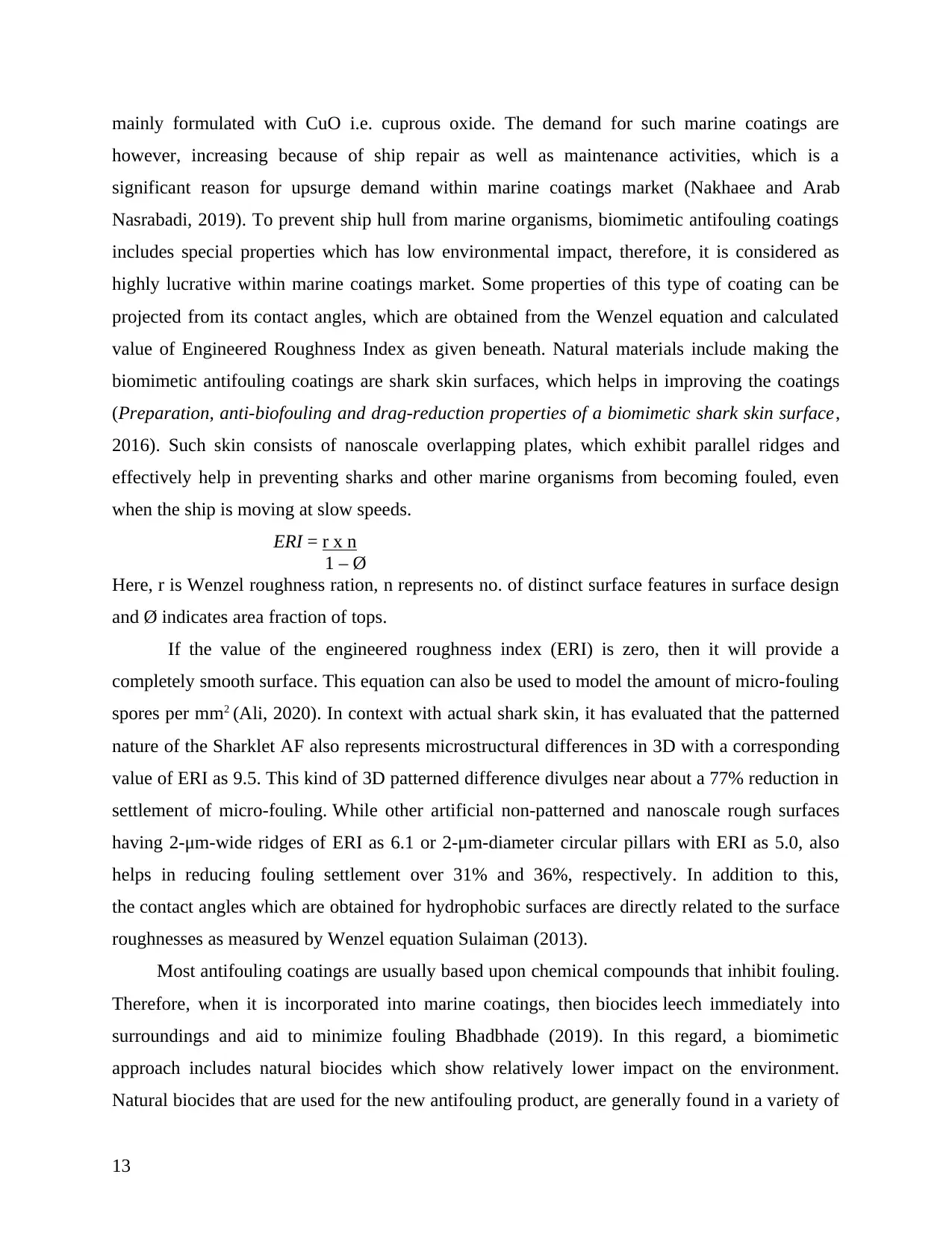
mainly formulated with CuO i.e. cuprous oxide. The demand for such marine coatings are
however, increasing because of ship repair as well as maintenance activities, which is a
significant reason for upsurge demand within marine coatings market (Nakhaee and Arab
Nasrabadi, 2019). To prevent ship hull from marine organisms, biomimetic antifouling coatings
includes special properties which has low environmental impact, therefore, it is considered as
highly lucrative within marine coatings market. Some properties of this type of coating can be
projected from its contact angles, which are obtained from the Wenzel equation and calculated
value of Engineered Roughness Index as given beneath. Natural materials include making the
biomimetic antifouling coatings are shark skin surfaces, which helps in improving the coatings
(Preparation, anti-biofouling and drag-reduction properties of a biomimetic shark skin surface,
2016). Such skin consists of nanoscale overlapping plates, which exhibit parallel ridges and
effectively help in preventing sharks and other marine organisms from becoming fouled, even
when the ship is moving at slow speeds.
ERI = r x n
1 – Ø
Here, r is Wenzel roughness ration, n represents no. of distinct surface features in surface design
and Ø indicates area fraction of tops.
If the value of the engineered roughness index (ERI) is zero, then it will provide a
completely smooth surface. This equation can also be used to model the amount of micro-fouling
spores per mm2 (Ali, 2020). In context with actual shark skin, it has evaluated that the patterned
nature of the Sharklet AF also represents microstructural differences in 3D with a corresponding
value of ERI as 9.5. This kind of 3D patterned difference divulges near about a 77% reduction in
settlement of micro-fouling. While other artificial non-patterned and nanoscale rough surfaces
having 2-μm-wide ridges of ERI as 6.1 or 2-μm-diameter circular pillars with ERI as 5.0, also
helps in reducing fouling settlement over 31% and 36%, respectively. In addition to this,
the contact angles which are obtained for hydrophobic surfaces are directly related to the surface
roughnesses as measured by Wenzel equation Sulaiman (2013).
Most antifouling coatings are usually based upon chemical compounds that inhibit fouling.
Therefore, when it is incorporated into marine coatings, then biocides leech immediately into
surroundings and aid to minimize fouling Bhadbhade (2019). In this regard, a biomimetic
approach includes natural biocides which show relatively lower impact on the environment.
Natural biocides that are used for the new antifouling product, are generally found in a variety of
13
however, increasing because of ship repair as well as maintenance activities, which is a
significant reason for upsurge demand within marine coatings market (Nakhaee and Arab
Nasrabadi, 2019). To prevent ship hull from marine organisms, biomimetic antifouling coatings
includes special properties which has low environmental impact, therefore, it is considered as
highly lucrative within marine coatings market. Some properties of this type of coating can be
projected from its contact angles, which are obtained from the Wenzel equation and calculated
value of Engineered Roughness Index as given beneath. Natural materials include making the
biomimetic antifouling coatings are shark skin surfaces, which helps in improving the coatings
(Preparation, anti-biofouling and drag-reduction properties of a biomimetic shark skin surface,
2016). Such skin consists of nanoscale overlapping plates, which exhibit parallel ridges and
effectively help in preventing sharks and other marine organisms from becoming fouled, even
when the ship is moving at slow speeds.
ERI = r x n
1 – Ø
Here, r is Wenzel roughness ration, n represents no. of distinct surface features in surface design
and Ø indicates area fraction of tops.
If the value of the engineered roughness index (ERI) is zero, then it will provide a
completely smooth surface. This equation can also be used to model the amount of micro-fouling
spores per mm2 (Ali, 2020). In context with actual shark skin, it has evaluated that the patterned
nature of the Sharklet AF also represents microstructural differences in 3D with a corresponding
value of ERI as 9.5. This kind of 3D patterned difference divulges near about a 77% reduction in
settlement of micro-fouling. While other artificial non-patterned and nanoscale rough surfaces
having 2-μm-wide ridges of ERI as 6.1 or 2-μm-diameter circular pillars with ERI as 5.0, also
helps in reducing fouling settlement over 31% and 36%, respectively. In addition to this,
the contact angles which are obtained for hydrophobic surfaces are directly related to the surface
roughnesses as measured by Wenzel equation Sulaiman (2013).
Most antifouling coatings are usually based upon chemical compounds that inhibit fouling.
Therefore, when it is incorporated into marine coatings, then biocides leech immediately into
surroundings and aid to minimize fouling Bhadbhade (2019). In this regard, a biomimetic
approach includes natural biocides which show relatively lower impact on the environment.
Natural biocides that are used for the new antifouling product, are generally found in a variety of
13
Paraphrase This Document
Need a fresh take? Get an instant paraphrase of this document with our AI Paraphraser
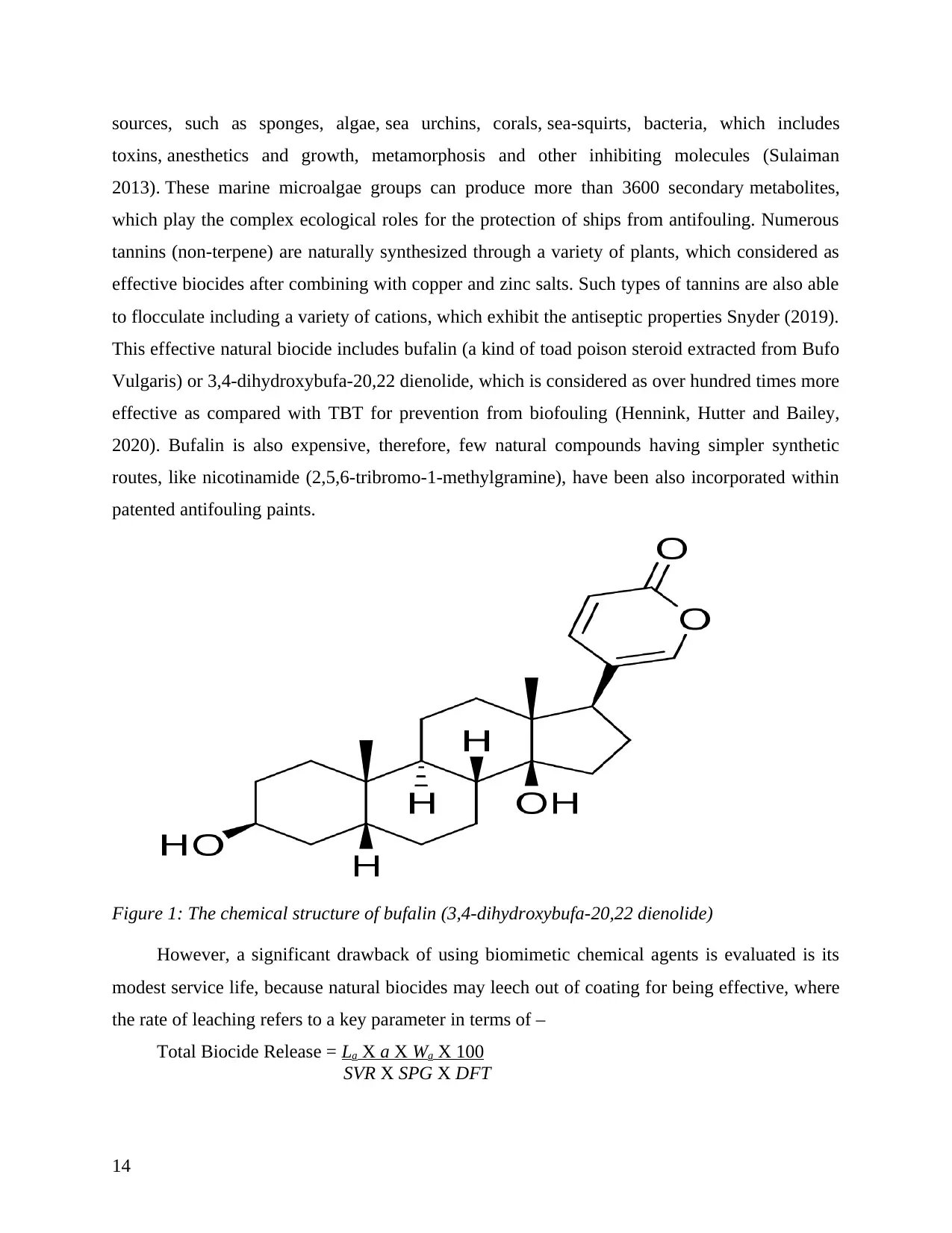
sources, such as sponges, algae, sea urchins, corals, sea-squirts, bacteria, which includes
toxins, anesthetics and growth, metamorphosis and other inhibiting molecules (Sulaiman
2013). These marine microalgae groups can produce more than 3600 secondary metabolites,
which play the complex ecological roles for the protection of ships from antifouling. Numerous
tannins (non-terpene) are naturally synthesized through a variety of plants, which considered as
effective biocides after combining with copper and zinc salts. Such types of tannins are also able
to flocculate including a variety of cations, which exhibit the antiseptic properties Snyder (2019).
This effective natural biocide includes bufalin (a kind of toad poison steroid extracted from Bufo
Vulgaris) or 3,4-dihydroxybufa-20,22 dienolide, which is considered as over hundred times more
effective as compared with TBT for prevention from biofouling (Hennink, Hutter and Bailey,
2020). Bufalin is also expensive, therefore, few natural compounds having simpler synthetic
routes, like nicotinamide (2,5,6-tribromo-1-methylgramine), have been also incorporated within
patented antifouling paints.
Figure 1: The chemical structure of bufalin (3,4-dihydroxybufa-20,22 dienolide)
However, a significant drawback of using biomimetic chemical agents is evaluated is its
modest service life, because natural biocides may leech out of coating for being effective, where
the rate of leaching refers to a key parameter in terms of –
Total Biocide Release = La X a X Wa X 100
SVR X SPG X DFT
14
toxins, anesthetics and growth, metamorphosis and other inhibiting molecules (Sulaiman
2013). These marine microalgae groups can produce more than 3600 secondary metabolites,
which play the complex ecological roles for the protection of ships from antifouling. Numerous
tannins (non-terpene) are naturally synthesized through a variety of plants, which considered as
effective biocides after combining with copper and zinc salts. Such types of tannins are also able
to flocculate including a variety of cations, which exhibit the antiseptic properties Snyder (2019).
This effective natural biocide includes bufalin (a kind of toad poison steroid extracted from Bufo
Vulgaris) or 3,4-dihydroxybufa-20,22 dienolide, which is considered as over hundred times more
effective as compared with TBT for prevention from biofouling (Hennink, Hutter and Bailey,
2020). Bufalin is also expensive, therefore, few natural compounds having simpler synthetic
routes, like nicotinamide (2,5,6-tribromo-1-methylgramine), have been also incorporated within
patented antifouling paints.
Figure 1: The chemical structure of bufalin (3,4-dihydroxybufa-20,22 dienolide)
However, a significant drawback of using biomimetic chemical agents is evaluated is its
modest service life, because natural biocides may leech out of coating for being effective, where
the rate of leaching refers to a key parameter in terms of –
Total Biocide Release = La X a X Wa X 100
SVR X SPG X DFT
14
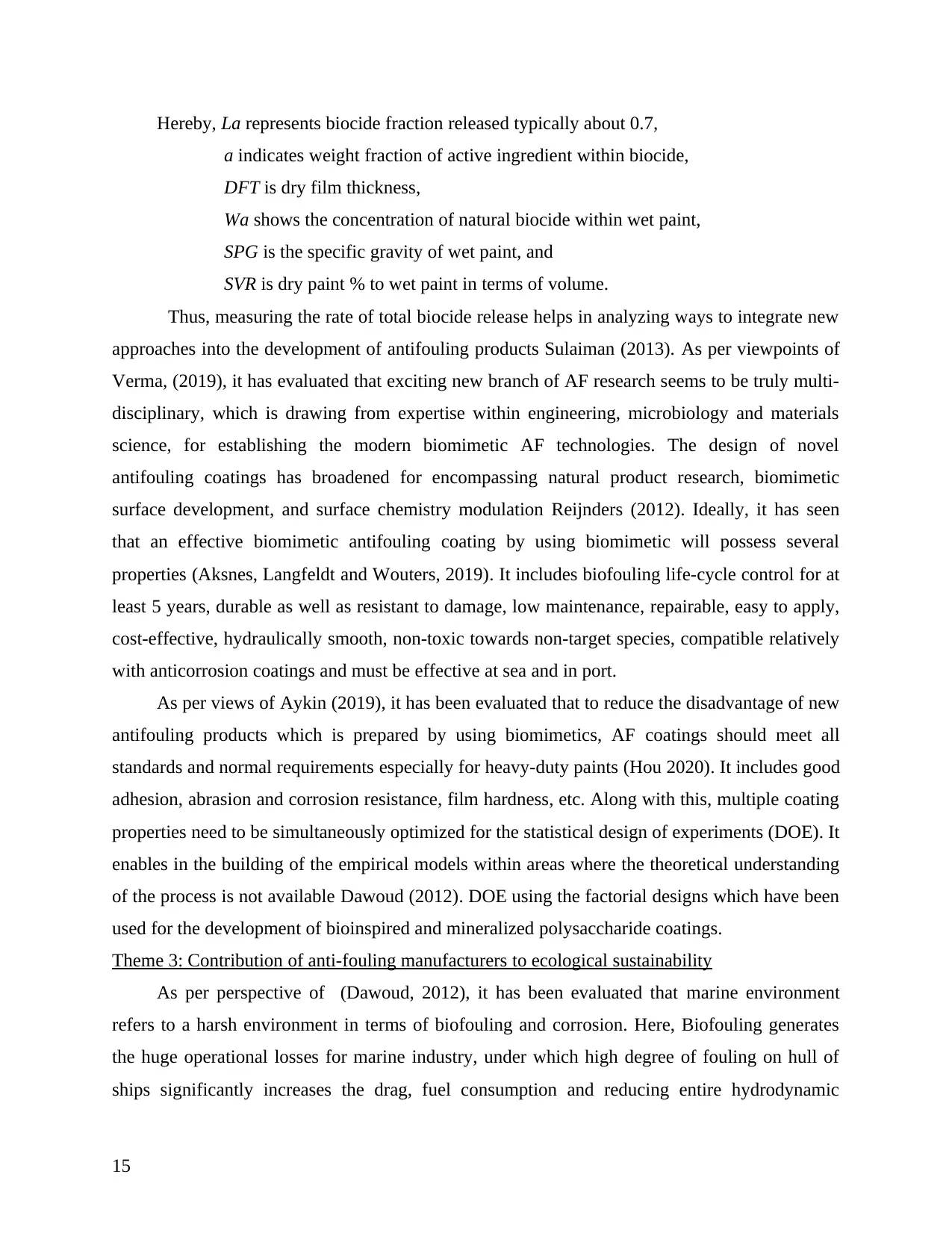
Hereby, La represents biocide fraction released typically about 0.7,
a indicates weight fraction of active ingredient within biocide,
DFT is dry film thickness,
Wa shows the concentration of natural biocide within wet paint,
SPG is the specific gravity of wet paint, and
SVR is dry paint % to wet paint in terms of volume.
Thus, measuring the rate of total biocide release helps in analyzing ways to integrate new
approaches into the development of antifouling products Sulaiman (2013). As per viewpoints of
Verma, (2019), it has evaluated that exciting new branch of AF research seems to be truly multi-
disciplinary, which is drawing from expertise within engineering, microbiology and materials
science, for establishing the modern biomimetic AF technologies. The design of novel
antifouling coatings has broadened for encompassing natural product research, biomimetic
surface development, and surface chemistry modulation Reijnders (2012). Ideally, it has seen
that an effective biomimetic antifouling coating by using biomimetic will possess several
properties (Aksnes, Langfeldt and Wouters, 2019). It includes biofouling life-cycle control for at
least 5 years, durable as well as resistant to damage, low maintenance, repairable, easy to apply,
cost-effective, hydraulically smooth, non-toxic towards non-target species, compatible relatively
with anticorrosion coatings and must be effective at sea and in port.
As per views of Aykin (2019), it has been evaluated that to reduce the disadvantage of new
antifouling products which is prepared by using biomimetics, AF coatings should meet all
standards and normal requirements especially for heavy-duty paints (Hou 2020). It includes good
adhesion, abrasion and corrosion resistance, film hardness, etc. Along with this, multiple coating
properties need to be simultaneously optimized for the statistical design of experiments (DOE). It
enables in the building of the empirical models within areas where the theoretical understanding
of the process is not available Dawoud (2012). DOE using the factorial designs which have been
used for the development of bioinspired and mineralized polysaccharide coatings.
Theme 3: Contribution of anti-fouling manufacturers to ecological sustainability
As per perspective of (Dawoud, 2012), it has been evaluated that marine environment
refers to a harsh environment in terms of biofouling and corrosion. Here, Biofouling generates
the huge operational losses for marine industry, under which high degree of fouling on hull of
ships significantly increases the drag, fuel consumption and reducing entire hydrodynamic
15
a indicates weight fraction of active ingredient within biocide,
DFT is dry film thickness,
Wa shows the concentration of natural biocide within wet paint,
SPG is the specific gravity of wet paint, and
SVR is dry paint % to wet paint in terms of volume.
Thus, measuring the rate of total biocide release helps in analyzing ways to integrate new
approaches into the development of antifouling products Sulaiman (2013). As per viewpoints of
Verma, (2019), it has evaluated that exciting new branch of AF research seems to be truly multi-
disciplinary, which is drawing from expertise within engineering, microbiology and materials
science, for establishing the modern biomimetic AF technologies. The design of novel
antifouling coatings has broadened for encompassing natural product research, biomimetic
surface development, and surface chemistry modulation Reijnders (2012). Ideally, it has seen
that an effective biomimetic antifouling coating by using biomimetic will possess several
properties (Aksnes, Langfeldt and Wouters, 2019). It includes biofouling life-cycle control for at
least 5 years, durable as well as resistant to damage, low maintenance, repairable, easy to apply,
cost-effective, hydraulically smooth, non-toxic towards non-target species, compatible relatively
with anticorrosion coatings and must be effective at sea and in port.
As per views of Aykin (2019), it has been evaluated that to reduce the disadvantage of new
antifouling products which is prepared by using biomimetics, AF coatings should meet all
standards and normal requirements especially for heavy-duty paints (Hou 2020). It includes good
adhesion, abrasion and corrosion resistance, film hardness, etc. Along with this, multiple coating
properties need to be simultaneously optimized for the statistical design of experiments (DOE). It
enables in the building of the empirical models within areas where the theoretical understanding
of the process is not available Dawoud (2012). DOE using the factorial designs which have been
used for the development of bioinspired and mineralized polysaccharide coatings.
Theme 3: Contribution of anti-fouling manufacturers to ecological sustainability
As per perspective of (Dawoud, 2012), it has been evaluated that marine environment
refers to a harsh environment in terms of biofouling and corrosion. Here, Biofouling generates
the huge operational losses for marine industry, under which high degree of fouling on hull of
ships significantly increases the drag, fuel consumption and reducing entire hydrodynamic
15
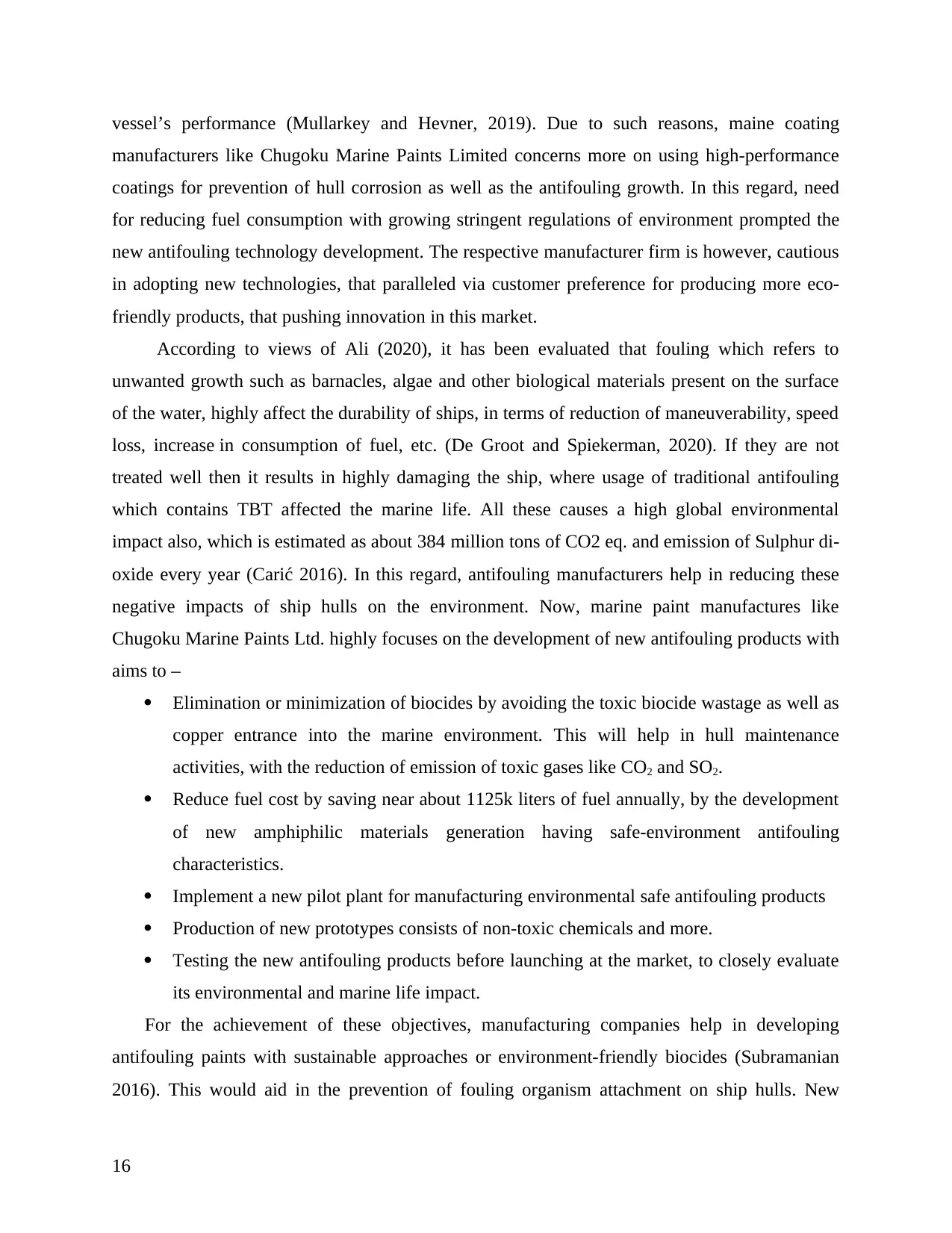
vessel’s performance (Mullarkey and Hevner, 2019). Due to such reasons, maine coating
manufacturers like Chugoku Marine Paints Limited concerns more on using high-performance
coatings for prevention of hull corrosion as well as the antifouling growth. In this regard, need
for reducing fuel consumption with growing stringent regulations of environment prompted the
new antifouling technology development. The respective manufacturer firm is however, cautious
in adopting new technologies, that paralleled via customer preference for producing more eco-
friendly products, that pushing innovation in this market.
According to views of Ali (2020), it has been evaluated that fouling which refers to
unwanted growth such as barnacles, algae and other biological materials present on the surface
of the water, highly affect the durability of ships, in terms of reduction of maneuverability, speed
loss, increase in consumption of fuel, etc. (De Groot and Spiekerman, 2020). If they are not
treated well then it results in highly damaging the ship, where usage of traditional antifouling
which contains TBT affected the marine life. All these causes a high global environmental
impact also, which is estimated as about 384 million tons of CO2 eq. and emission of Sulphur di-
oxide every year (Carić 2016). In this regard, antifouling manufacturers help in reducing these
negative impacts of ship hulls on the environment. Now, marine paint manufactures like
Chugoku Marine Paints Ltd. highly focuses on the development of new antifouling products with
aims to –
Elimination or minimization of biocides by avoiding the toxic biocide wastage as well as
copper entrance into the marine environment. This will help in hull maintenance
activities, with the reduction of emission of toxic gases like CO2 and SO2.
Reduce fuel cost by saving near about 1125k liters of fuel annually, by the development
of new amphiphilic materials generation having safe-environment antifouling
characteristics.
Implement a new pilot plant for manufacturing environmental safe antifouling products
Production of new prototypes consists of non-toxic chemicals and more.
Testing the new antifouling products before launching at the market, to closely evaluate
its environmental and marine life impact.
For the achievement of these objectives, manufacturing companies help in developing
antifouling paints with sustainable approaches or environment-friendly biocides (Subramanian
2016). This would aid in the prevention of fouling organism attachment on ship hulls. New
16
manufacturers like Chugoku Marine Paints Limited concerns more on using high-performance
coatings for prevention of hull corrosion as well as the antifouling growth. In this regard, need
for reducing fuel consumption with growing stringent regulations of environment prompted the
new antifouling technology development. The respective manufacturer firm is however, cautious
in adopting new technologies, that paralleled via customer preference for producing more eco-
friendly products, that pushing innovation in this market.
According to views of Ali (2020), it has been evaluated that fouling which refers to
unwanted growth such as barnacles, algae and other biological materials present on the surface
of the water, highly affect the durability of ships, in terms of reduction of maneuverability, speed
loss, increase in consumption of fuel, etc. (De Groot and Spiekerman, 2020). If they are not
treated well then it results in highly damaging the ship, where usage of traditional antifouling
which contains TBT affected the marine life. All these causes a high global environmental
impact also, which is estimated as about 384 million tons of CO2 eq. and emission of Sulphur di-
oxide every year (Carić 2016). In this regard, antifouling manufacturers help in reducing these
negative impacts of ship hulls on the environment. Now, marine paint manufactures like
Chugoku Marine Paints Ltd. highly focuses on the development of new antifouling products with
aims to –
Elimination or minimization of biocides by avoiding the toxic biocide wastage as well as
copper entrance into the marine environment. This will help in hull maintenance
activities, with the reduction of emission of toxic gases like CO2 and SO2.
Reduce fuel cost by saving near about 1125k liters of fuel annually, by the development
of new amphiphilic materials generation having safe-environment antifouling
characteristics.
Implement a new pilot plant for manufacturing environmental safe antifouling products
Production of new prototypes consists of non-toxic chemicals and more.
Testing the new antifouling products before launching at the market, to closely evaluate
its environmental and marine life impact.
For the achievement of these objectives, manufacturing companies help in developing
antifouling paints with sustainable approaches or environment-friendly biocides (Subramanian
2016). This would aid in the prevention of fouling organism attachment on ship hulls. New
16
Secure Best Marks with AI Grader
Need help grading? Try our AI Grader for instant feedback on your assignments.
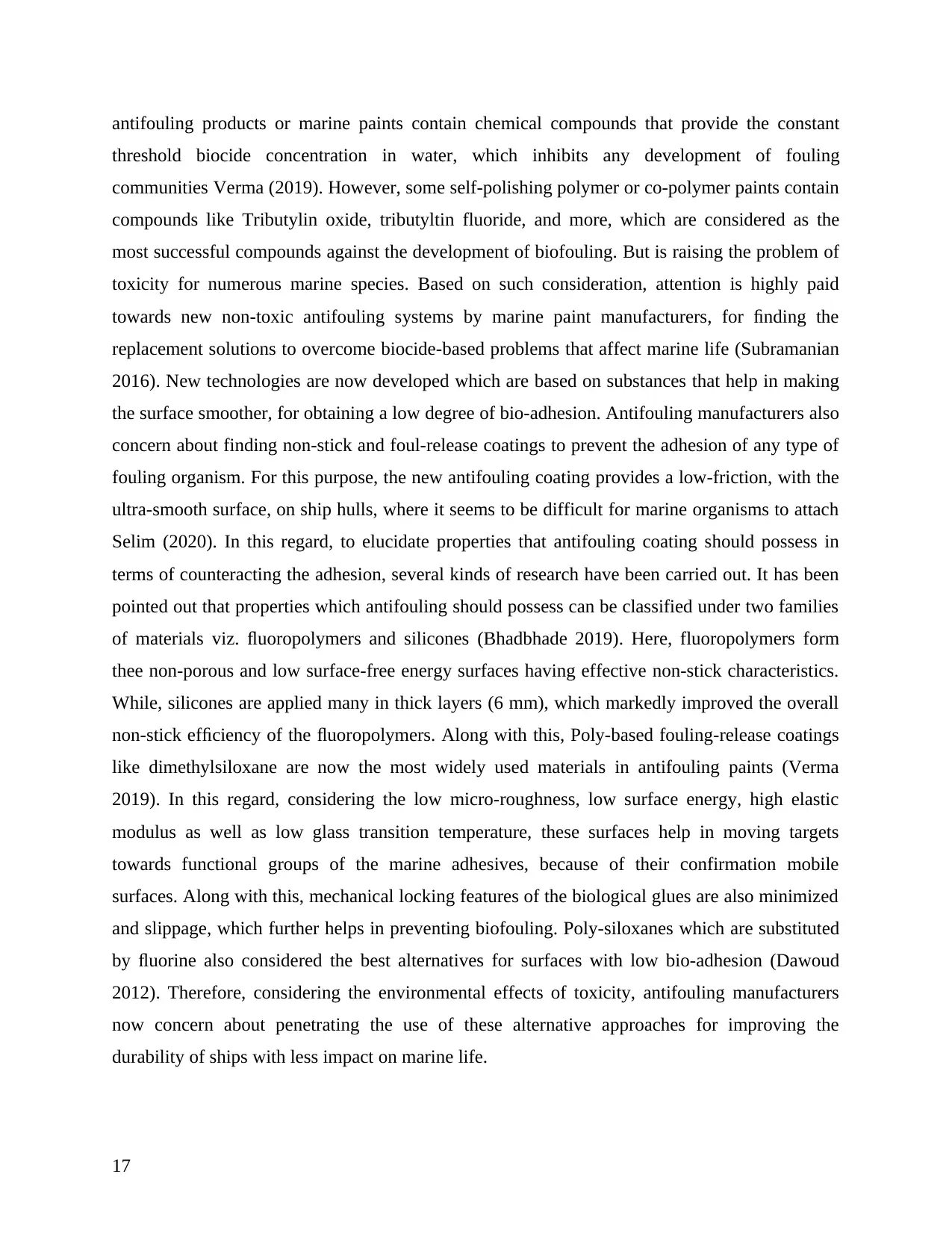
antifouling products or marine paints contain chemical compounds that provide the constant
threshold biocide concentration in water, which inhibits any development of fouling
communities Verma (2019). However, some self-polishing polymer or co-polymer paints contain
compounds like Tributylin oxide, tributyltin fluoride, and more, which are considered as the
most successful compounds against the development of biofouling. But is raising the problem of
toxicity for numerous marine species. Based on such consideration, attention is highly paid
towards new non-toxic antifouling systems by marine paint manufacturers, for finding the
replacement solutions to overcome biocide-based problems that affect marine life (Subramanian
2016). New technologies are now developed which are based on substances that help in making
the surface smoother, for obtaining a low degree of bio-adhesion. Antifouling manufacturers also
concern about finding non-stick and foul-release coatings to prevent the adhesion of any type of
fouling organism. For this purpose, the new antifouling coating provides a low-friction, with the
ultra-smooth surface, on ship hulls, where it seems to be difficult for marine organisms to attach
Selim (2020). In this regard, to elucidate properties that antifouling coating should possess in
terms of counteracting the adhesion, several kinds of research have been carried out. It has been
pointed out that properties which antifouling should possess can be classified under two families
of materials viz. fluoropolymers and silicones (Bhadbhade 2019). Here, fluoropolymers form
thee non-porous and low surface-free energy surfaces having effective non-stick characteristics.
While, silicones are applied many in thick layers (6 mm), which markedly improved the overall
non-stick efficiency of the fluoropolymers. Along with this, Poly-based fouling-release coatings
like dimethylsiloxane are now the most widely used materials in antifouling paints (Verma
2019). In this regard, considering the low micro-roughness, low surface energy, high elastic
modulus as well as low glass transition temperature, these surfaces help in moving targets
towards functional groups of the marine adhesives, because of their confirmation mobile
surfaces. Along with this, mechanical locking features of the biological glues are also minimized
and slippage, which further helps in preventing biofouling. Poly-siloxanes which are substituted
by fluorine also considered the best alternatives for surfaces with low bio-adhesion (Dawoud
2012). Therefore, considering the environmental effects of toxicity, antifouling manufacturers
now concern about penetrating the use of these alternative approaches for improving the
durability of ships with less impact on marine life.
17
threshold biocide concentration in water, which inhibits any development of fouling
communities Verma (2019). However, some self-polishing polymer or co-polymer paints contain
compounds like Tributylin oxide, tributyltin fluoride, and more, which are considered as the
most successful compounds against the development of biofouling. But is raising the problem of
toxicity for numerous marine species. Based on such consideration, attention is highly paid
towards new non-toxic antifouling systems by marine paint manufacturers, for finding the
replacement solutions to overcome biocide-based problems that affect marine life (Subramanian
2016). New technologies are now developed which are based on substances that help in making
the surface smoother, for obtaining a low degree of bio-adhesion. Antifouling manufacturers also
concern about finding non-stick and foul-release coatings to prevent the adhesion of any type of
fouling organism. For this purpose, the new antifouling coating provides a low-friction, with the
ultra-smooth surface, on ship hulls, where it seems to be difficult for marine organisms to attach
Selim (2020). In this regard, to elucidate properties that antifouling coating should possess in
terms of counteracting the adhesion, several kinds of research have been carried out. It has been
pointed out that properties which antifouling should possess can be classified under two families
of materials viz. fluoropolymers and silicones (Bhadbhade 2019). Here, fluoropolymers form
thee non-porous and low surface-free energy surfaces having effective non-stick characteristics.
While, silicones are applied many in thick layers (6 mm), which markedly improved the overall
non-stick efficiency of the fluoropolymers. Along with this, Poly-based fouling-release coatings
like dimethylsiloxane are now the most widely used materials in antifouling paints (Verma
2019). In this regard, considering the low micro-roughness, low surface energy, high elastic
modulus as well as low glass transition temperature, these surfaces help in moving targets
towards functional groups of the marine adhesives, because of their confirmation mobile
surfaces. Along with this, mechanical locking features of the biological glues are also minimized
and slippage, which further helps in preventing biofouling. Poly-siloxanes which are substituted
by fluorine also considered the best alternatives for surfaces with low bio-adhesion (Dawoud
2012). Therefore, considering the environmental effects of toxicity, antifouling manufacturers
now concern about penetrating the use of these alternative approaches for improving the
durability of ships with less impact on marine life.
17
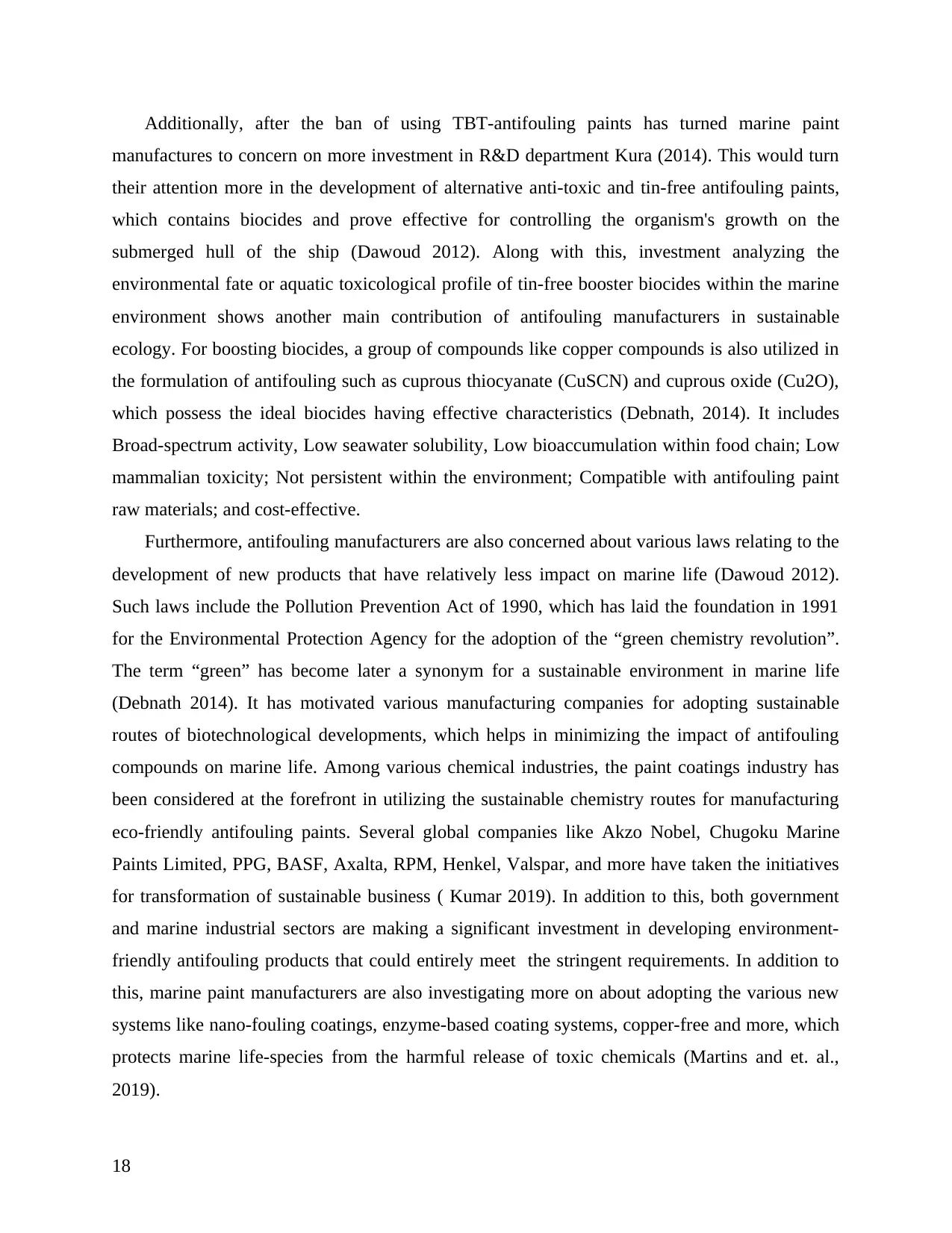
Additionally, after the ban of using TBT-antifouling paints has turned marine paint
manufactures to concern on more investment in R&D department Kura (2014). This would turn
their attention more in the development of alternative anti-toxic and tin-free antifouling paints,
which contains biocides and prove effective for controlling the organism's growth on the
submerged hull of the ship (Dawoud 2012). Along with this, investment analyzing the
environmental fate or aquatic toxicological profile of tin-free booster biocides within the marine
environment shows another main contribution of antifouling manufacturers in sustainable
ecology. For boosting biocides, a group of compounds like copper compounds is also utilized in
the formulation of antifouling such as cuprous thiocyanate (CuSCN) and cuprous oxide (Cu2O),
which possess the ideal biocides having effective characteristics (Debnath, 2014). It includes
Broad-spectrum activity, Low seawater solubility, Low bioaccumulation within food chain; Low
mammalian toxicity; Not persistent within the environment; Compatible with antifouling paint
raw materials; and cost-effective.
Furthermore, antifouling manufacturers are also concerned about various laws relating to the
development of new products that have relatively less impact on marine life (Dawoud 2012).
Such laws include the Pollution Prevention Act of 1990, which has laid the foundation in 1991
for the Environmental Protection Agency for the adoption of the “green chemistry revolution”.
The term “green” has become later a synonym for a sustainable environment in marine life
(Debnath 2014). It has motivated various manufacturing companies for adopting sustainable
routes of biotechnological developments, which helps in minimizing the impact of antifouling
compounds on marine life. Among various chemical industries, the paint coatings industry has
been considered at the forefront in utilizing the sustainable chemistry routes for manufacturing
eco-friendly antifouling paints. Several global companies like Akzo Nobel, Chugoku Marine
Paints Limited, PPG, BASF, Axalta, RPM, Henkel, Valspar, and more have taken the initiatives
for transformation of sustainable business ( Kumar 2019). In addition to this, both government
and marine industrial sectors are making a significant investment in developing environment-
friendly antifouling products that could entirely meet the stringent requirements. In addition to
this, marine paint manufacturers are also investigating more on about adopting the various new
systems like nano-fouling coatings, enzyme-based coating systems, copper-free and more, which
protects marine life-species from the harmful release of toxic chemicals (Martins and et. al.,
2019).
18
manufactures to concern on more investment in R&D department Kura (2014). This would turn
their attention more in the development of alternative anti-toxic and tin-free antifouling paints,
which contains biocides and prove effective for controlling the organism's growth on the
submerged hull of the ship (Dawoud 2012). Along with this, investment analyzing the
environmental fate or aquatic toxicological profile of tin-free booster biocides within the marine
environment shows another main contribution of antifouling manufacturers in sustainable
ecology. For boosting biocides, a group of compounds like copper compounds is also utilized in
the formulation of antifouling such as cuprous thiocyanate (CuSCN) and cuprous oxide (Cu2O),
which possess the ideal biocides having effective characteristics (Debnath, 2014). It includes
Broad-spectrum activity, Low seawater solubility, Low bioaccumulation within food chain; Low
mammalian toxicity; Not persistent within the environment; Compatible with antifouling paint
raw materials; and cost-effective.
Furthermore, antifouling manufacturers are also concerned about various laws relating to the
development of new products that have relatively less impact on marine life (Dawoud 2012).
Such laws include the Pollution Prevention Act of 1990, which has laid the foundation in 1991
for the Environmental Protection Agency for the adoption of the “green chemistry revolution”.
The term “green” has become later a synonym for a sustainable environment in marine life
(Debnath 2014). It has motivated various manufacturing companies for adopting sustainable
routes of biotechnological developments, which helps in minimizing the impact of antifouling
compounds on marine life. Among various chemical industries, the paint coatings industry has
been considered at the forefront in utilizing the sustainable chemistry routes for manufacturing
eco-friendly antifouling paints. Several global companies like Akzo Nobel, Chugoku Marine
Paints Limited, PPG, BASF, Axalta, RPM, Henkel, Valspar, and more have taken the initiatives
for transformation of sustainable business ( Kumar 2019). In addition to this, both government
and marine industrial sectors are making a significant investment in developing environment-
friendly antifouling products that could entirely meet the stringent requirements. In addition to
this, marine paint manufacturers are also investigating more on about adopting the various new
systems like nano-fouling coatings, enzyme-based coating systems, copper-free and more, which
protects marine life-species from the harmful release of toxic chemicals (Martins and et. al.,
2019).
18

19
Paraphrase This Document
Need a fresh take? Get an instant paraphrase of this document with our AI Paraphraser
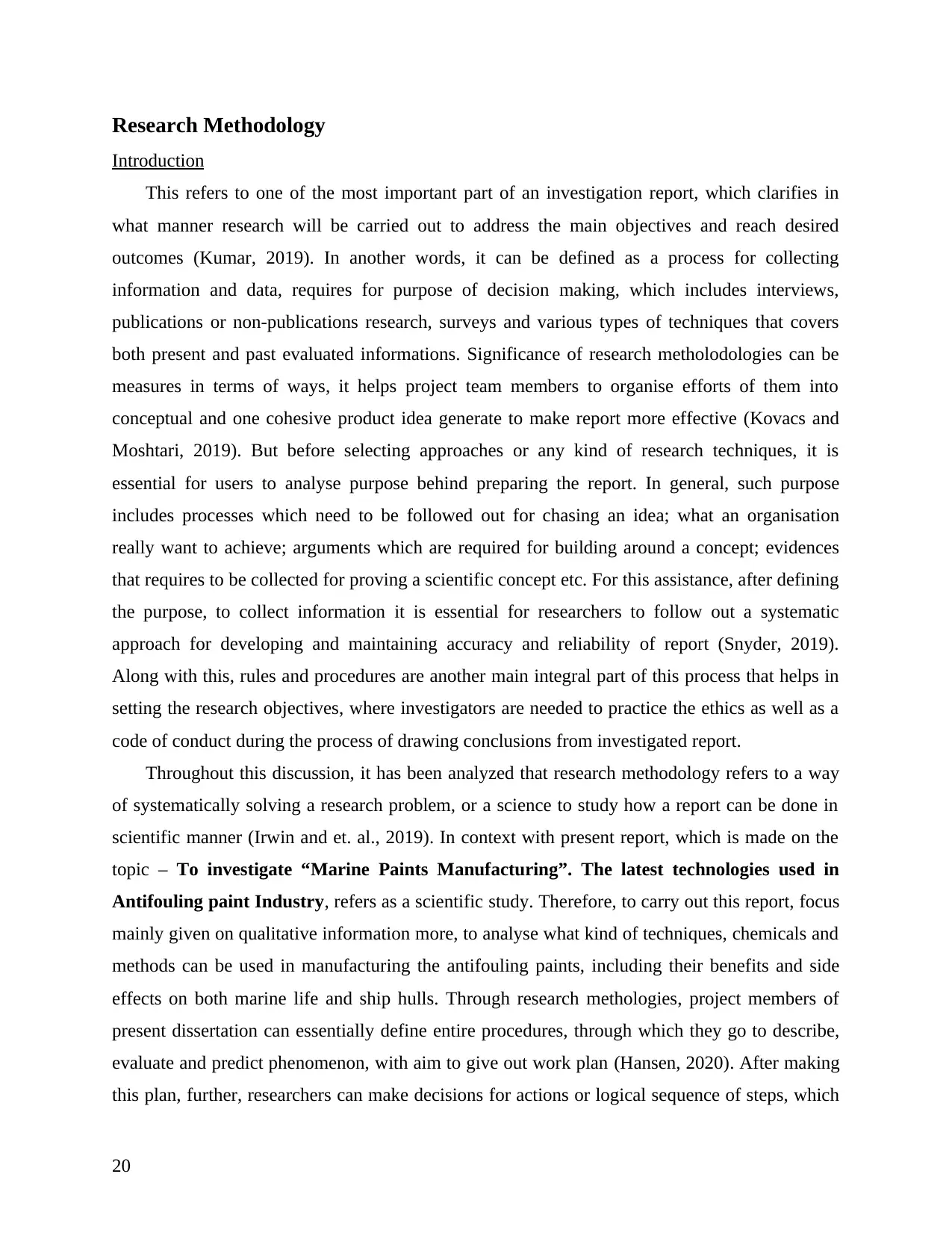
Research Methodology
Introduction
This refers to one of the most important part of an investigation report, which clarifies in
what manner research will be carried out to address the main objectives and reach desired
outcomes (Kumar, 2019). In another words, it can be defined as a process for collecting
information and data, requires for purpose of decision making, which includes interviews,
publications or non-publications research, surveys and various types of techniques that covers
both present and past evaluated informations. Significance of research metholodologies can be
measures in terms of ways, it helps project team members to organise efforts of them into
conceptual and one cohesive product idea generate to make report more effective (Kovacs and
Moshtari, 2019). But before selecting approaches or any kind of research techniques, it is
essential for users to analyse purpose behind preparing the report. In general, such purpose
includes processes which need to be followed out for chasing an idea; what an organisation
really want to achieve; arguments which are required for building around a concept; evidences
that requires to be collected for proving a scientific concept etc. For this assistance, after defining
the purpose, to collect information it is essential for researchers to follow out a systematic
approach for developing and maintaining accuracy and reliability of report (Snyder, 2019).
Along with this, rules and procedures are another main integral part of this process that helps in
setting the research objectives, where investigators are needed to practice the ethics as well as a
code of conduct during the process of drawing conclusions from investigated report.
Throughout this discussion, it has been analyzed that research methodology refers to a way
of systematically solving a research problem, or a science to study how a report can be done in
scientific manner (Irwin and et. al., 2019). In context with present report, which is made on the
topic – To investigate “Marine Paints Manufacturing”. The latest technologies used in
Antifouling paint Industry, refers as a scientific study. Therefore, to carry out this report, focus
mainly given on qualitative information more, to analyse what kind of techniques, chemicals and
methods can be used in manufacturing the antifouling paints, including their benefits and side
effects on both marine life and ship hulls. Through research methologies, project members of
present dissertation can essentially define entire procedures, through which they go to describe,
evaluate and predict phenomenon, with aim to give out work plan (Hansen, 2020). After making
this plan, further, researchers can make decisions for actions or logical sequence of steps, which
20
Introduction
This refers to one of the most important part of an investigation report, which clarifies in
what manner research will be carried out to address the main objectives and reach desired
outcomes (Kumar, 2019). In another words, it can be defined as a process for collecting
information and data, requires for purpose of decision making, which includes interviews,
publications or non-publications research, surveys and various types of techniques that covers
both present and past evaluated informations. Significance of research metholodologies can be
measures in terms of ways, it helps project team members to organise efforts of them into
conceptual and one cohesive product idea generate to make report more effective (Kovacs and
Moshtari, 2019). But before selecting approaches or any kind of research techniques, it is
essential for users to analyse purpose behind preparing the report. In general, such purpose
includes processes which need to be followed out for chasing an idea; what an organisation
really want to achieve; arguments which are required for building around a concept; evidences
that requires to be collected for proving a scientific concept etc. For this assistance, after defining
the purpose, to collect information it is essential for researchers to follow out a systematic
approach for developing and maintaining accuracy and reliability of report (Snyder, 2019).
Along with this, rules and procedures are another main integral part of this process that helps in
setting the research objectives, where investigators are needed to practice the ethics as well as a
code of conduct during the process of drawing conclusions from investigated report.
Throughout this discussion, it has been analyzed that research methodology refers to a way
of systematically solving a research problem, or a science to study how a report can be done in
scientific manner (Irwin and et. al., 2019). In context with present report, which is made on the
topic – To investigate “Marine Paints Manufacturing”. The latest technologies used in
Antifouling paint Industry, refers as a scientific study. Therefore, to carry out this report, focus
mainly given on qualitative information more, to analyse what kind of techniques, chemicals and
methods can be used in manufacturing the antifouling paints, including their benefits and side
effects on both marine life and ship hulls. Through research methologies, project members of
present dissertation can essentially define entire procedures, through which they go to describe,
evaluate and predict phenomenon, with aim to give out work plan (Hansen, 2020). After making
this plan, further, researchers can make decisions for actions or logical sequence of steps, which
20
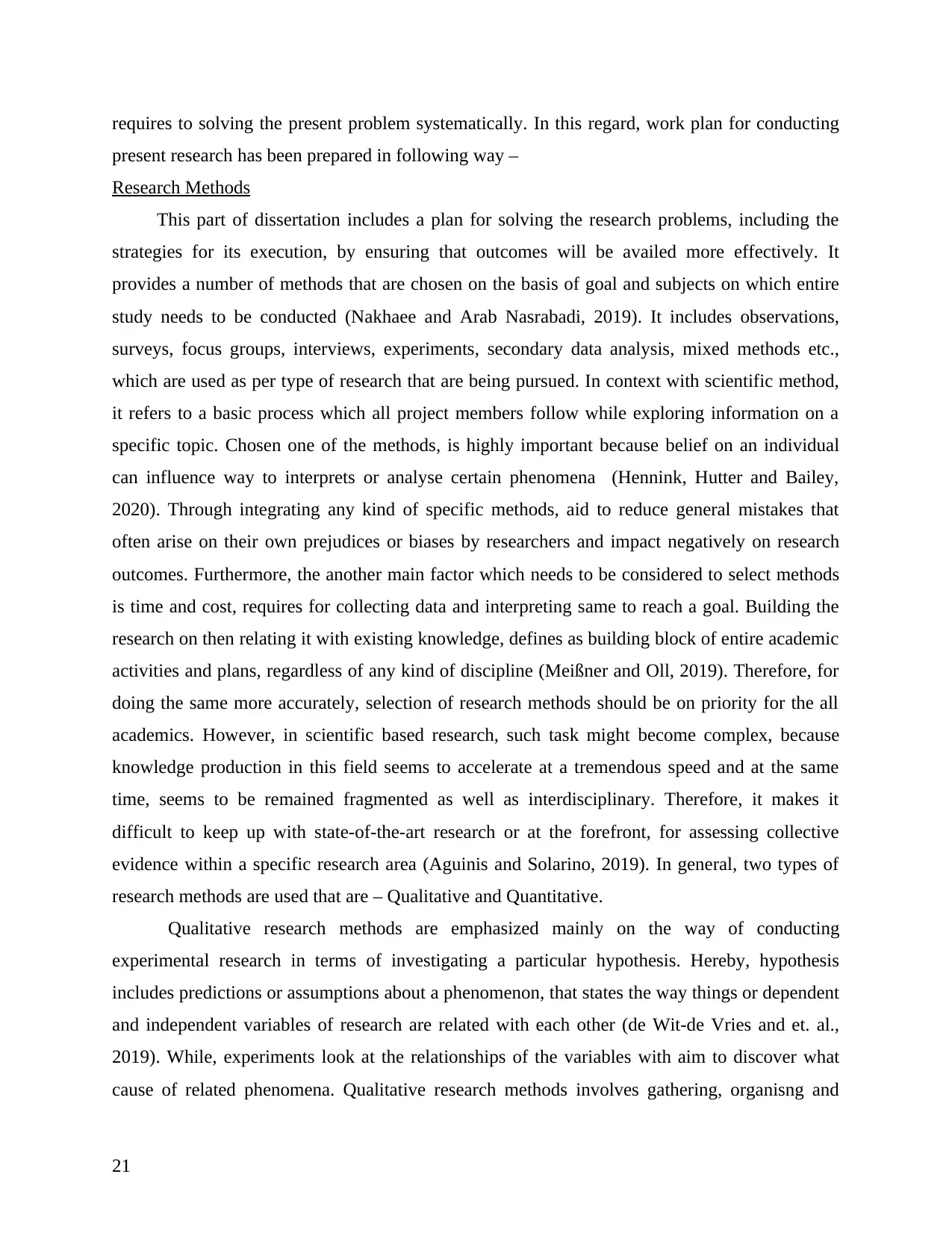
requires to solving the present problem systematically. In this regard, work plan for conducting
present research has been prepared in following way –
Research Methods
This part of dissertation includes a plan for solving the research problems, including the
strategies for its execution, by ensuring that outcomes will be availed more effectively. It
provides a number of methods that are chosen on the basis of goal and subjects on which entire
study needs to be conducted (Nakhaee and Arab Nasrabadi, 2019). It includes observations,
surveys, focus groups, interviews, experiments, secondary data analysis, mixed methods etc.,
which are used as per type of research that are being pursued. In context with scientific method,
it refers to a basic process which all project members follow while exploring information on a
specific topic. Chosen one of the methods, is highly important because belief on an individual
can influence way to interprets or analyse certain phenomena (Hennink, Hutter and Bailey,
2020). Through integrating any kind of specific methods, aid to reduce general mistakes that
often arise on their own prejudices or biases by researchers and impact negatively on research
outcomes. Furthermore, the another main factor which needs to be considered to select methods
is time and cost, requires for collecting data and interpreting same to reach a goal. Building the
research on then relating it with existing knowledge, defines as building block of entire academic
activities and plans, regardless of any kind of discipline (Meißner and Oll, 2019). Therefore, for
doing the same more accurately, selection of research methods should be on priority for the all
academics. However, in scientific based research, such task might become complex, because
knowledge production in this field seems to accelerate at a tremendous speed and at the same
time, seems to be remained fragmented as well as interdisciplinary. Therefore, it makes it
difficult to keep up with state-of-the-art research or at the forefront, for assessing collective
evidence within a specific research area (Aguinis and Solarino, 2019). In general, two types of
research methods are used that are – Qualitative and Quantitative.
Qualitative research methods are emphasized mainly on the way of conducting
experimental research in terms of investigating a particular hypothesis. Hereby, hypothesis
includes predictions or assumptions about a phenomenon, that states the way things or dependent
and independent variables of research are related with each other (de Wit-de Vries and et. al.,
2019). While, experiments look at the relationships of the variables with aim to discover what
cause of related phenomena. Qualitative research methods involves gathering, organisng and
21
present research has been prepared in following way –
Research Methods
This part of dissertation includes a plan for solving the research problems, including the
strategies for its execution, by ensuring that outcomes will be availed more effectively. It
provides a number of methods that are chosen on the basis of goal and subjects on which entire
study needs to be conducted (Nakhaee and Arab Nasrabadi, 2019). It includes observations,
surveys, focus groups, interviews, experiments, secondary data analysis, mixed methods etc.,
which are used as per type of research that are being pursued. In context with scientific method,
it refers to a basic process which all project members follow while exploring information on a
specific topic. Chosen one of the methods, is highly important because belief on an individual
can influence way to interprets or analyse certain phenomena (Hennink, Hutter and Bailey,
2020). Through integrating any kind of specific methods, aid to reduce general mistakes that
often arise on their own prejudices or biases by researchers and impact negatively on research
outcomes. Furthermore, the another main factor which needs to be considered to select methods
is time and cost, requires for collecting data and interpreting same to reach a goal. Building the
research on then relating it with existing knowledge, defines as building block of entire academic
activities and plans, regardless of any kind of discipline (Meißner and Oll, 2019). Therefore, for
doing the same more accurately, selection of research methods should be on priority for the all
academics. However, in scientific based research, such task might become complex, because
knowledge production in this field seems to accelerate at a tremendous speed and at the same
time, seems to be remained fragmented as well as interdisciplinary. Therefore, it makes it
difficult to keep up with state-of-the-art research or at the forefront, for assessing collective
evidence within a specific research area (Aguinis and Solarino, 2019). In general, two types of
research methods are used that are – Qualitative and Quantitative.
Qualitative research methods are emphasized mainly on the way of conducting
experimental research in terms of investigating a particular hypothesis. Hereby, hypothesis
includes predictions or assumptions about a phenomenon, that states the way things or dependent
and independent variables of research are related with each other (de Wit-de Vries and et. al.,
2019). While, experiments look at the relationships of the variables with aim to discover what
cause of related phenomena. Qualitative research methods involves gathering, organisng and
21
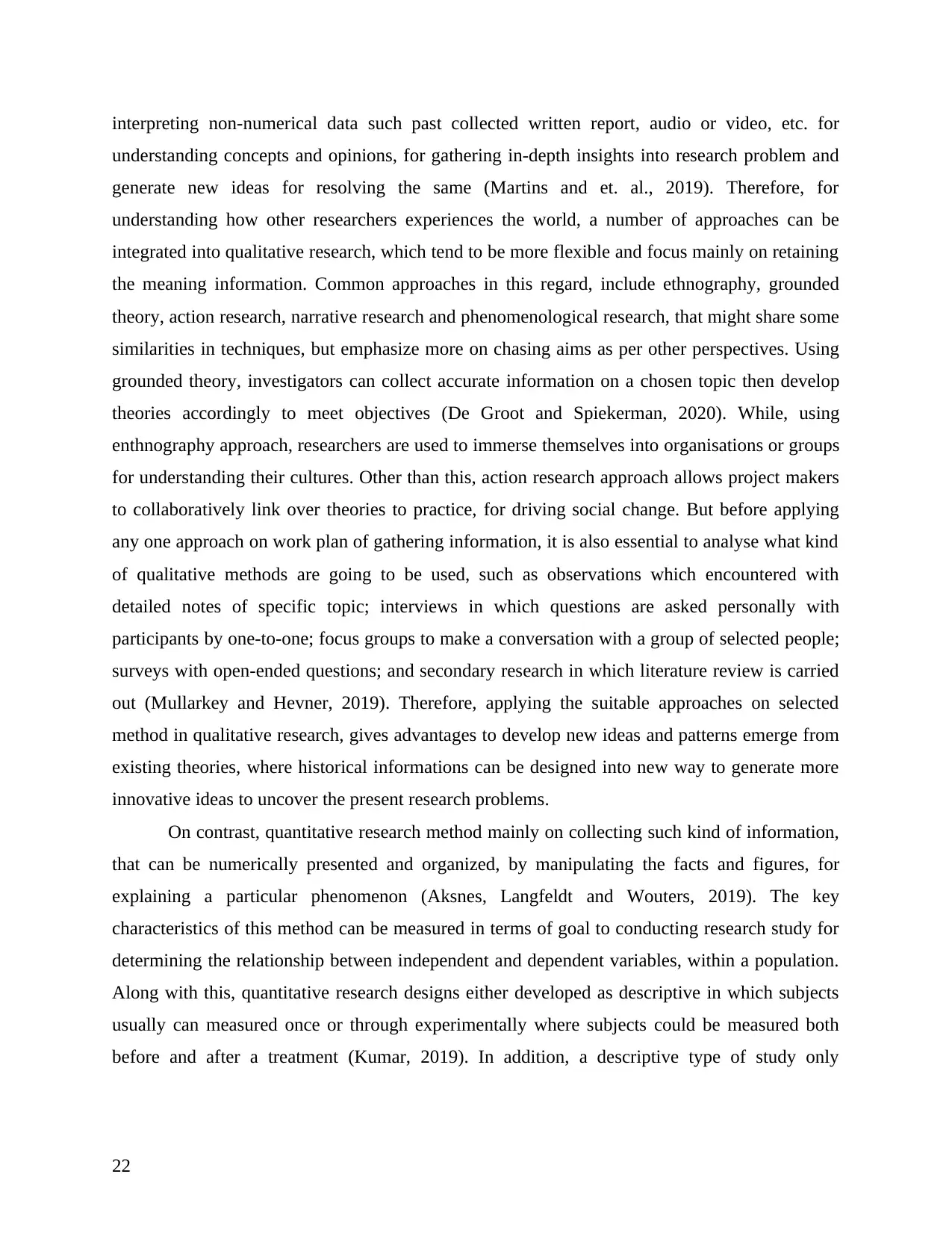
interpreting non-numerical data such past collected written report, audio or video, etc. for
understanding concepts and opinions, for gathering in-depth insights into research problem and
generate new ideas for resolving the same (Martins and et. al., 2019). Therefore, for
understanding how other researchers experiences the world, a number of approaches can be
integrated into qualitative research, which tend to be more flexible and focus mainly on retaining
the meaning information. Common approaches in this regard, include ethnography, grounded
theory, action research, narrative research and phenomenological research, that might share some
similarities in techniques, but emphasize more on chasing aims as per other perspectives. Using
grounded theory, investigators can collect accurate information on a chosen topic then develop
theories accordingly to meet objectives (De Groot and Spiekerman, 2020). While, using
enthnography approach, researchers are used to immerse themselves into organisations or groups
for understanding their cultures. Other than this, action research approach allows project makers
to collaboratively link over theories to practice, for driving social change. But before applying
any one approach on work plan of gathering information, it is also essential to analyse what kind
of qualitative methods are going to be used, such as observations which encountered with
detailed notes of specific topic; interviews in which questions are asked personally with
participants by one-to-one; focus groups to make a conversation with a group of selected people;
surveys with open-ended questions; and secondary research in which literature review is carried
out (Mullarkey and Hevner, 2019). Therefore, applying the suitable approaches on selected
method in qualitative research, gives advantages to develop new ideas and patterns emerge from
existing theories, where historical informations can be designed into new way to generate more
innovative ideas to uncover the present research problems.
On contrast, quantitative research method mainly on collecting such kind of information,
that can be numerically presented and organized, by manipulating the facts and figures, for
explaining a particular phenomenon (Aksnes, Langfeldt and Wouters, 2019). The key
characteristics of this method can be measured in terms of goal to conducting research study for
determining the relationship between independent and dependent variables, within a population.
Along with this, quantitative research designs either developed as descriptive in which subjects
usually can measured once or through experimentally where subjects could be measured both
before and after a treatment (Kumar, 2019). In addition, a descriptive type of study only
22
understanding concepts and opinions, for gathering in-depth insights into research problem and
generate new ideas for resolving the same (Martins and et. al., 2019). Therefore, for
understanding how other researchers experiences the world, a number of approaches can be
integrated into qualitative research, which tend to be more flexible and focus mainly on retaining
the meaning information. Common approaches in this regard, include ethnography, grounded
theory, action research, narrative research and phenomenological research, that might share some
similarities in techniques, but emphasize more on chasing aims as per other perspectives. Using
grounded theory, investigators can collect accurate information on a chosen topic then develop
theories accordingly to meet objectives (De Groot and Spiekerman, 2020). While, using
enthnography approach, researchers are used to immerse themselves into organisations or groups
for understanding their cultures. Other than this, action research approach allows project makers
to collaboratively link over theories to practice, for driving social change. But before applying
any one approach on work plan of gathering information, it is also essential to analyse what kind
of qualitative methods are going to be used, such as observations which encountered with
detailed notes of specific topic; interviews in which questions are asked personally with
participants by one-to-one; focus groups to make a conversation with a group of selected people;
surveys with open-ended questions; and secondary research in which literature review is carried
out (Mullarkey and Hevner, 2019). Therefore, applying the suitable approaches on selected
method in qualitative research, gives advantages to develop new ideas and patterns emerge from
existing theories, where historical informations can be designed into new way to generate more
innovative ideas to uncover the present research problems.
On contrast, quantitative research method mainly on collecting such kind of information,
that can be numerically presented and organized, by manipulating the facts and figures, for
explaining a particular phenomenon (Aksnes, Langfeldt and Wouters, 2019). The key
characteristics of this method can be measured in terms of goal to conducting research study for
determining the relationship between independent and dependent variables, within a population.
Along with this, quantitative research designs either developed as descriptive in which subjects
usually can measured once or through experimentally where subjects could be measured both
before and after a treatment (Kumar, 2019). In addition, a descriptive type of study only
22
Secure Best Marks with AI Grader
Need help grading? Try our AI Grader for instant feedback on your assignments.
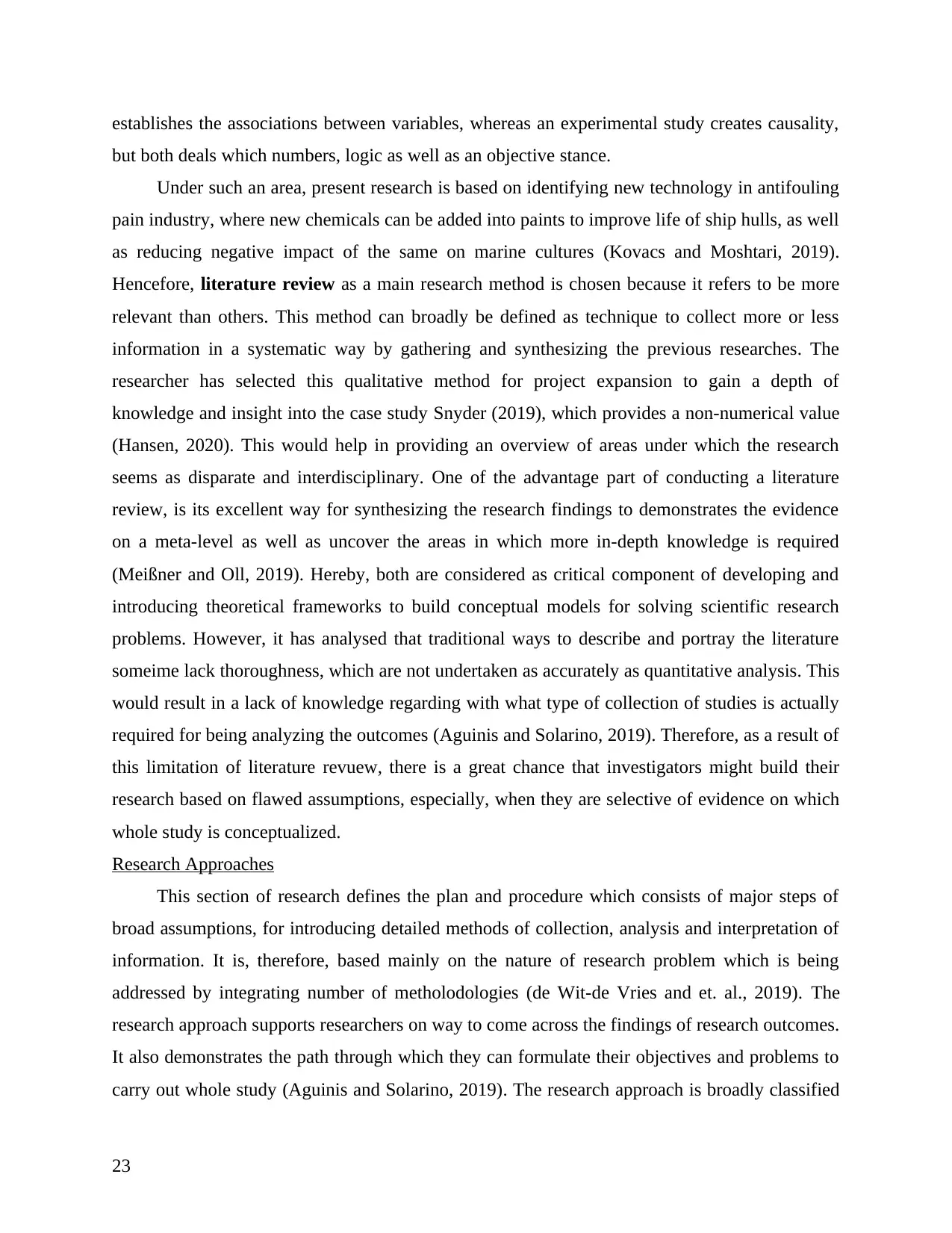
establishes the associations between variables, whereas an experimental study creates causality,
but both deals which numbers, logic as well as an objective stance.
Under such an area, present research is based on identifying new technology in antifouling
pain industry, where new chemicals can be added into paints to improve life of ship hulls, as well
as reducing negative impact of the same on marine cultures (Kovacs and Moshtari, 2019).
Hencefore, literature review as a main research method is chosen because it refers to be more
relevant than others. This method can broadly be defined as technique to collect more or less
information in a systematic way by gathering and synthesizing the previous researches. The
researcher has selected this qualitative method for project expansion to gain a depth of
knowledge and insight into the case study Snyder (2019), which provides a non-numerical value
(Hansen, 2020). This would help in providing an overview of areas under which the research
seems as disparate and interdisciplinary. One of the advantage part of conducting a literature
review, is its excellent way for synthesizing the research findings to demonstrates the evidence
on a meta-level as well as uncover the areas in which more in-depth knowledge is required
(Meißner and Oll, 2019). Hereby, both are considered as critical component of developing and
introducing theoretical frameworks to build conceptual models for solving scientific research
problems. However, it has analysed that traditional ways to describe and portray the literature
someime lack thoroughness, which are not undertaken as accurately as quantitative analysis. This
would result in a lack of knowledge regarding with what type of collection of studies is actually
required for being analyzing the outcomes (Aguinis and Solarino, 2019). Therefore, as a result of
this limitation of literature revuew, there is a great chance that investigators might build their
research based on flawed assumptions, especially, when they are selective of evidence on which
whole study is conceptualized.
Research Approaches
This section of research defines the plan and procedure which consists of major steps of
broad assumptions, for introducing detailed methods of collection, analysis and interpretation of
information. It is, therefore, based mainly on the nature of research problem which is being
addressed by integrating number of metholodologies (de Wit-de Vries and et. al., 2019). The
research approach supports researchers on way to come across the findings of research outcomes.
It also demonstrates the path through which they can formulate their objectives and problems to
carry out whole study (Aguinis and Solarino, 2019). The research approach is broadly classified
23
but both deals which numbers, logic as well as an objective stance.
Under such an area, present research is based on identifying new technology in antifouling
pain industry, where new chemicals can be added into paints to improve life of ship hulls, as well
as reducing negative impact of the same on marine cultures (Kovacs and Moshtari, 2019).
Hencefore, literature review as a main research method is chosen because it refers to be more
relevant than others. This method can broadly be defined as technique to collect more or less
information in a systematic way by gathering and synthesizing the previous researches. The
researcher has selected this qualitative method for project expansion to gain a depth of
knowledge and insight into the case study Snyder (2019), which provides a non-numerical value
(Hansen, 2020). This would help in providing an overview of areas under which the research
seems as disparate and interdisciplinary. One of the advantage part of conducting a literature
review, is its excellent way for synthesizing the research findings to demonstrates the evidence
on a meta-level as well as uncover the areas in which more in-depth knowledge is required
(Meißner and Oll, 2019). Hereby, both are considered as critical component of developing and
introducing theoretical frameworks to build conceptual models for solving scientific research
problems. However, it has analysed that traditional ways to describe and portray the literature
someime lack thoroughness, which are not undertaken as accurately as quantitative analysis. This
would result in a lack of knowledge regarding with what type of collection of studies is actually
required for being analyzing the outcomes (Aguinis and Solarino, 2019). Therefore, as a result of
this limitation of literature revuew, there is a great chance that investigators might build their
research based on flawed assumptions, especially, when they are selective of evidence on which
whole study is conceptualized.
Research Approaches
This section of research defines the plan and procedure which consists of major steps of
broad assumptions, for introducing detailed methods of collection, analysis and interpretation of
information. It is, therefore, based mainly on the nature of research problem which is being
addressed by integrating number of metholodologies (de Wit-de Vries and et. al., 2019). The
research approach supports researchers on way to come across the findings of research outcomes.
It also demonstrates the path through which they can formulate their objectives and problems to
carry out whole study (Aguinis and Solarino, 2019). The research approach is broadly classified
23
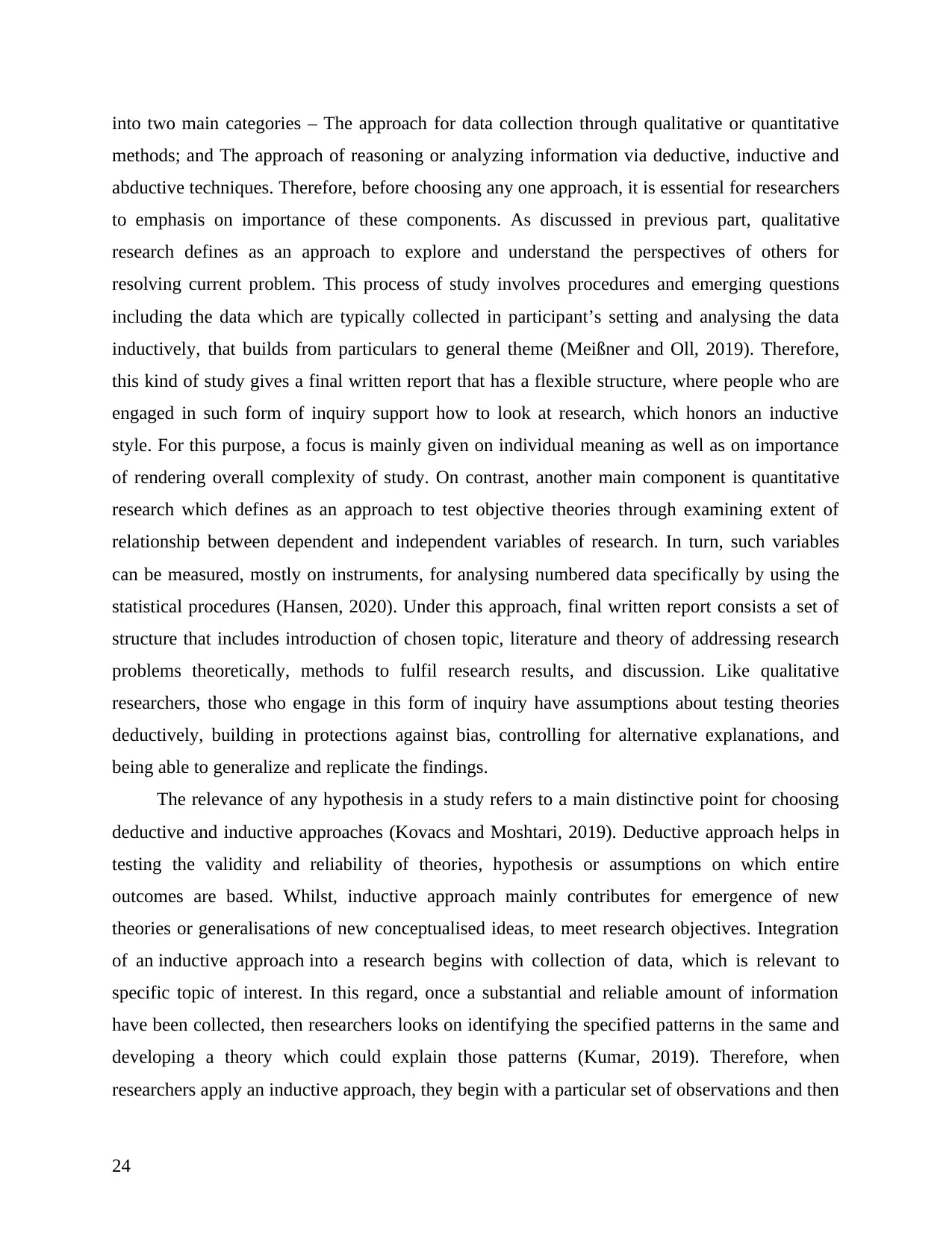
into two main categories – The approach for data collection through qualitative or quantitative
methods; and The approach of reasoning or analyzing information via deductive, inductive and
abductive techniques. Therefore, before choosing any one approach, it is essential for researchers
to emphasis on importance of these components. As discussed in previous part, qualitative
research defines as an approach to explore and understand the perspectives of others for
resolving current problem. This process of study involves procedures and emerging questions
including the data which are typically collected in participant’s setting and analysing the data
inductively, that builds from particulars to general theme (Meißner and Oll, 2019). Therefore,
this kind of study gives a final written report that has a flexible structure, where people who are
engaged in such form of inquiry support how to look at research, which honors an inductive
style. For this purpose, a focus is mainly given on individual meaning as well as on importance
of rendering overall complexity of study. On contrast, another main component is quantitative
research which defines as an approach to test objective theories through examining extent of
relationship between dependent and independent variables of research. In turn, such variables
can be measured, mostly on instruments, for analysing numbered data specifically by using the
statistical procedures (Hansen, 2020). Under this approach, final written report consists a set of
structure that includes introduction of chosen topic, literature and theory of addressing research
problems theoretically, methods to fulfil research results, and discussion. Like qualitative
researchers, those who engage in this form of inquiry have assumptions about testing theories
deductively, building in protections against bias, controlling for alternative explanations, and
being able to generalize and replicate the findings.
The relevance of any hypothesis in a study refers to a main distinctive point for choosing
deductive and inductive approaches (Kovacs and Moshtari, 2019). Deductive approach helps in
testing the validity and reliability of theories, hypothesis or assumptions on which entire
outcomes are based. Whilst, inductive approach mainly contributes for emergence of new
theories or generalisations of new conceptualised ideas, to meet research objectives. Integration
of an inductive approach into a research begins with collection of data, which is relevant to
specific topic of interest. In this regard, once a substantial and reliable amount of information
have been collected, then researchers looks on identifying the specified patterns in the same and
developing a theory which could explain those patterns (Kumar, 2019). Therefore, when
researchers apply an inductive approach, they begin with a particular set of observations and then
24
methods; and The approach of reasoning or analyzing information via deductive, inductive and
abductive techniques. Therefore, before choosing any one approach, it is essential for researchers
to emphasis on importance of these components. As discussed in previous part, qualitative
research defines as an approach to explore and understand the perspectives of others for
resolving current problem. This process of study involves procedures and emerging questions
including the data which are typically collected in participant’s setting and analysing the data
inductively, that builds from particulars to general theme (Meißner and Oll, 2019). Therefore,
this kind of study gives a final written report that has a flexible structure, where people who are
engaged in such form of inquiry support how to look at research, which honors an inductive
style. For this purpose, a focus is mainly given on individual meaning as well as on importance
of rendering overall complexity of study. On contrast, another main component is quantitative
research which defines as an approach to test objective theories through examining extent of
relationship between dependent and independent variables of research. In turn, such variables
can be measured, mostly on instruments, for analysing numbered data specifically by using the
statistical procedures (Hansen, 2020). Under this approach, final written report consists a set of
structure that includes introduction of chosen topic, literature and theory of addressing research
problems theoretically, methods to fulfil research results, and discussion. Like qualitative
researchers, those who engage in this form of inquiry have assumptions about testing theories
deductively, building in protections against bias, controlling for alternative explanations, and
being able to generalize and replicate the findings.
The relevance of any hypothesis in a study refers to a main distinctive point for choosing
deductive and inductive approaches (Kovacs and Moshtari, 2019). Deductive approach helps in
testing the validity and reliability of theories, hypothesis or assumptions on which entire
outcomes are based. Whilst, inductive approach mainly contributes for emergence of new
theories or generalisations of new conceptualised ideas, to meet research objectives. Integration
of an inductive approach into a research begins with collection of data, which is relevant to
specific topic of interest. In this regard, once a substantial and reliable amount of information
have been collected, then researchers looks on identifying the specified patterns in the same and
developing a theory which could explain those patterns (Kumar, 2019). Therefore, when
researchers apply an inductive approach, they begin with a particular set of observations and then
24
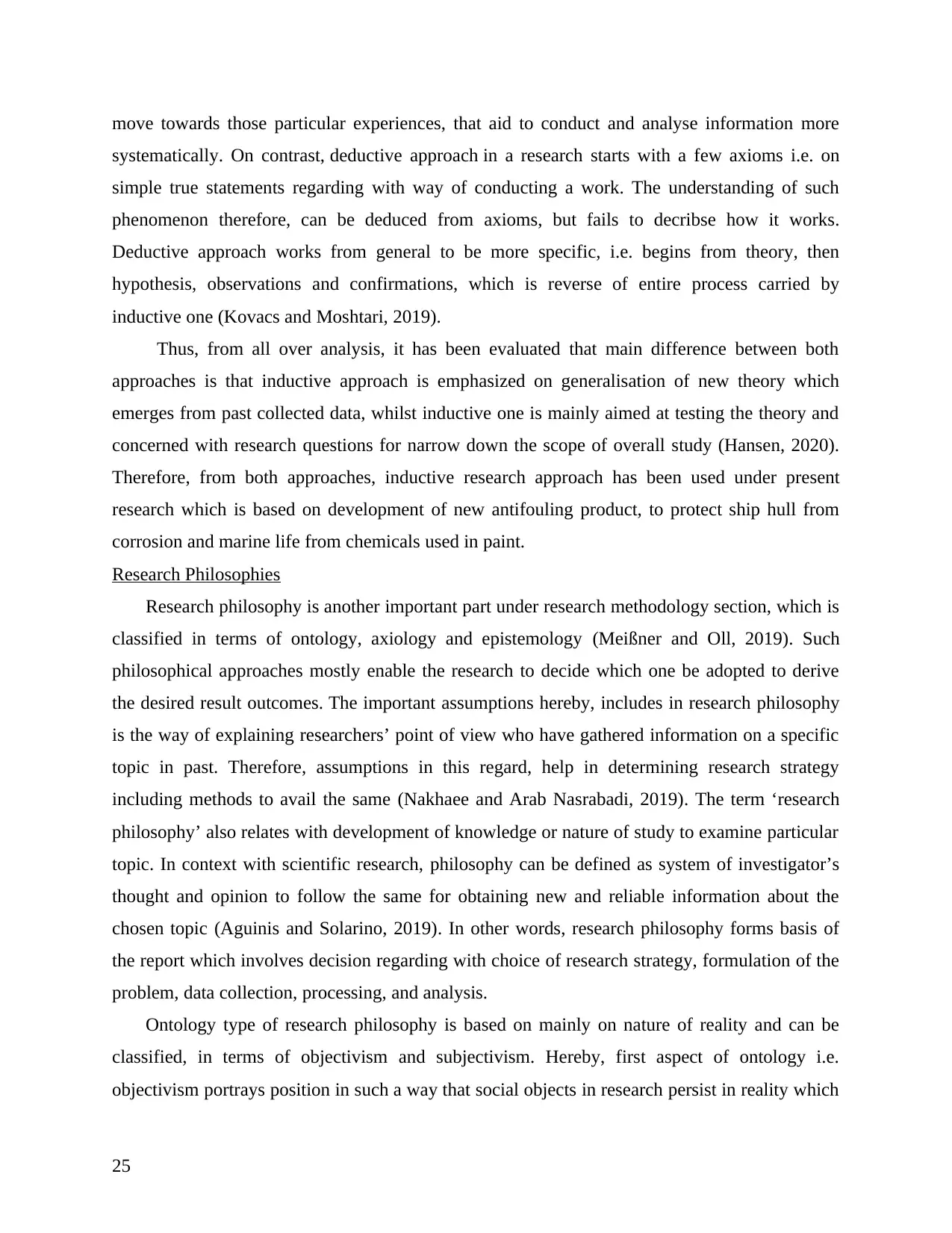
move towards those particular experiences, that aid to conduct and analyse information more
systematically. On contrast, deductive approach in a research starts with a few axioms i.e. on
simple true statements regarding with way of conducting a work. The understanding of such
phenomenon therefore, can be deduced from axioms, but fails to decribse how it works.
Deductive approach works from general to be more specific, i.e. begins from theory, then
hypothesis, observations and confirmations, which is reverse of entire process carried by
inductive one (Kovacs and Moshtari, 2019).
Thus, from all over analysis, it has been evaluated that main difference between both
approaches is that inductive approach is emphasized on generalisation of new theory which
emerges from past collected data, whilst inductive one is mainly aimed at testing the theory and
concerned with research questions for narrow down the scope of overall study (Hansen, 2020).
Therefore, from both approaches, inductive research approach has been used under present
research which is based on development of new antifouling product, to protect ship hull from
corrosion and marine life from chemicals used in paint.
Research Philosophies
Research philosophy is another important part under research methodology section, which is
classified in terms of ontology, axiology and epistemology (Meißner and Oll, 2019). Such
philosophical approaches mostly enable the research to decide which one be adopted to derive
the desired result outcomes. The important assumptions hereby, includes in research philosophy
is the way of explaining researchers’ point of view who have gathered information on a specific
topic in past. Therefore, assumptions in this regard, help in determining research strategy
including methods to avail the same (Nakhaee and Arab Nasrabadi, 2019). The term ‘research
philosophy’ also relates with development of knowledge or nature of study to examine particular
topic. In context with scientific research, philosophy can be defined as system of investigator’s
thought and opinion to follow the same for obtaining new and reliable information about the
chosen topic (Aguinis and Solarino, 2019). In other words, research philosophy forms basis of
the report which involves decision regarding with choice of research strategy, formulation of the
problem, data collection, processing, and analysis.
Ontology type of research philosophy is based on mainly on nature of reality and can be
classified, in terms of objectivism and subjectivism. Hereby, first aspect of ontology i.e.
objectivism portrays position in such a way that social objects in research persist in reality which
25
systematically. On contrast, deductive approach in a research starts with a few axioms i.e. on
simple true statements regarding with way of conducting a work. The understanding of such
phenomenon therefore, can be deduced from axioms, but fails to decribse how it works.
Deductive approach works from general to be more specific, i.e. begins from theory, then
hypothesis, observations and confirmations, which is reverse of entire process carried by
inductive one (Kovacs and Moshtari, 2019).
Thus, from all over analysis, it has been evaluated that main difference between both
approaches is that inductive approach is emphasized on generalisation of new theory which
emerges from past collected data, whilst inductive one is mainly aimed at testing the theory and
concerned with research questions for narrow down the scope of overall study (Hansen, 2020).
Therefore, from both approaches, inductive research approach has been used under present
research which is based on development of new antifouling product, to protect ship hull from
corrosion and marine life from chemicals used in paint.
Research Philosophies
Research philosophy is another important part under research methodology section, which is
classified in terms of ontology, axiology and epistemology (Meißner and Oll, 2019). Such
philosophical approaches mostly enable the research to decide which one be adopted to derive
the desired result outcomes. The important assumptions hereby, includes in research philosophy
is the way of explaining researchers’ point of view who have gathered information on a specific
topic in past. Therefore, assumptions in this regard, help in determining research strategy
including methods to avail the same (Nakhaee and Arab Nasrabadi, 2019). The term ‘research
philosophy’ also relates with development of knowledge or nature of study to examine particular
topic. In context with scientific research, philosophy can be defined as system of investigator’s
thought and opinion to follow the same for obtaining new and reliable information about the
chosen topic (Aguinis and Solarino, 2019). In other words, research philosophy forms basis of
the report which involves decision regarding with choice of research strategy, formulation of the
problem, data collection, processing, and analysis.
Ontology type of research philosophy is based on mainly on nature of reality and can be
classified, in terms of objectivism and subjectivism. Hereby, first aspect of ontology i.e.
objectivism portrays position in such a way that social objects in research persist in reality which
25
Paraphrase This Document
Need a fresh take? Get an instant paraphrase of this document with our AI Paraphraser
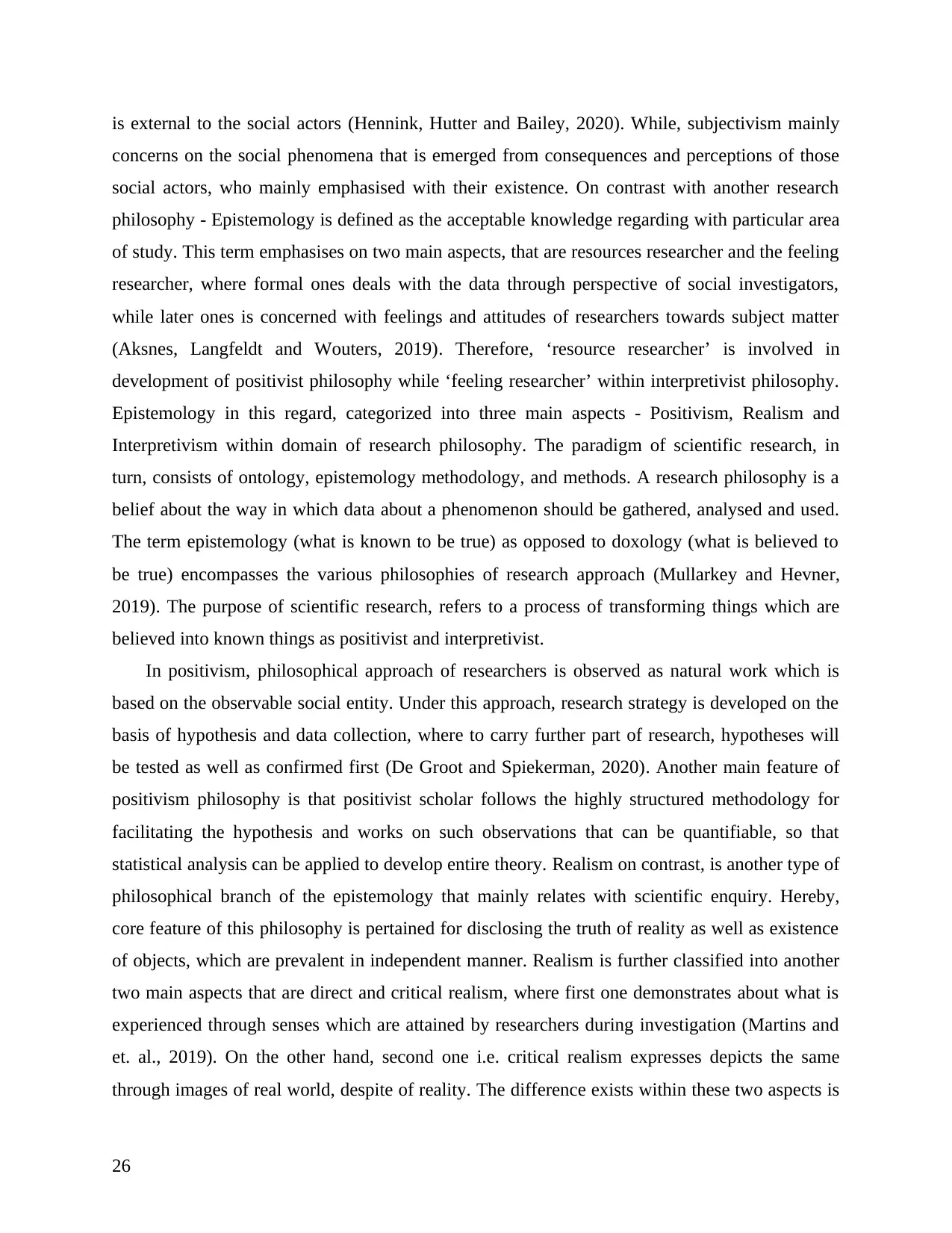
is external to the social actors (Hennink, Hutter and Bailey, 2020). While, subjectivism mainly
concerns on the social phenomena that is emerged from consequences and perceptions of those
social actors, who mainly emphasised with their existence. On contrast with another research
philosophy - Epistemology is defined as the acceptable knowledge regarding with particular area
of study. This term emphasises on two main aspects, that are resources researcher and the feeling
researcher, where formal ones deals with the data through perspective of social investigators,
while later ones is concerned with feelings and attitudes of researchers towards subject matter
(Aksnes, Langfeldt and Wouters, 2019). Therefore, ‘resource researcher’ is involved in
development of positivist philosophy while ‘feeling researcher’ within interpretivist philosophy.
Epistemology in this regard, categorized into three main aspects - Positivism, Realism and
Interpretivism within domain of research philosophy. The paradigm of scientific research, in
turn, consists of ontology, epistemology methodology, and methods. A research philosophy is a
belief about the way in which data about a phenomenon should be gathered, analysed and used.
The term epistemology (what is known to be true) as opposed to doxology (what is believed to
be true) encompasses the various philosophies of research approach (Mullarkey and Hevner,
2019). The purpose of scientific research, refers to a process of transforming things which are
believed into known things as positivist and interpretivist.
In positivism, philosophical approach of researchers is observed as natural work which is
based on the observable social entity. Under this approach, research strategy is developed on the
basis of hypothesis and data collection, where to carry further part of research, hypotheses will
be tested as well as confirmed first (De Groot and Spiekerman, 2020). Another main feature of
positivism philosophy is that positivist scholar follows the highly structured methodology for
facilitating the hypothesis and works on such observations that can be quantifiable, so that
statistical analysis can be applied to develop entire theory. Realism on contrast, is another type of
philosophical branch of the epistemology that mainly relates with scientific enquiry. Hereby,
core feature of this philosophy is pertained for disclosing the truth of reality as well as existence
of objects, which are prevalent in independent manner. Realism is further classified into another
two main aspects that are direct and critical realism, where first one demonstrates about what is
experienced through senses which are attained by researchers during investigation (Martins and
et. al., 2019). On the other hand, second one i.e. critical realism expresses depicts the same
through images of real world, despite of reality. The difference exists within these two aspects is
26
concerns on the social phenomena that is emerged from consequences and perceptions of those
social actors, who mainly emphasised with their existence. On contrast with another research
philosophy - Epistemology is defined as the acceptable knowledge regarding with particular area
of study. This term emphasises on two main aspects, that are resources researcher and the feeling
researcher, where formal ones deals with the data through perspective of social investigators,
while later ones is concerned with feelings and attitudes of researchers towards subject matter
(Aksnes, Langfeldt and Wouters, 2019). Therefore, ‘resource researcher’ is involved in
development of positivist philosophy while ‘feeling researcher’ within interpretivist philosophy.
Epistemology in this regard, categorized into three main aspects - Positivism, Realism and
Interpretivism within domain of research philosophy. The paradigm of scientific research, in
turn, consists of ontology, epistemology methodology, and methods. A research philosophy is a
belief about the way in which data about a phenomenon should be gathered, analysed and used.
The term epistemology (what is known to be true) as opposed to doxology (what is believed to
be true) encompasses the various philosophies of research approach (Mullarkey and Hevner,
2019). The purpose of scientific research, refers to a process of transforming things which are
believed into known things as positivist and interpretivist.
In positivism, philosophical approach of researchers is observed as natural work which is
based on the observable social entity. Under this approach, research strategy is developed on the
basis of hypothesis and data collection, where to carry further part of research, hypotheses will
be tested as well as confirmed first (De Groot and Spiekerman, 2020). Another main feature of
positivism philosophy is that positivist scholar follows the highly structured methodology for
facilitating the hypothesis and works on such observations that can be quantifiable, so that
statistical analysis can be applied to develop entire theory. Realism on contrast, is another type of
philosophical branch of the epistemology that mainly relates with scientific enquiry. Hereby,
core feature of this philosophy is pertained for disclosing the truth of reality as well as existence
of objects, which are prevalent in independent manner. Realism is further classified into another
two main aspects that are direct and critical realism, where first one demonstrates about what is
experienced through senses which are attained by researchers during investigation (Martins and
et. al., 2019). On the other hand, second one i.e. critical realism expresses depicts the same
through images of real world, despite of reality. The difference exists within these two aspects is
26
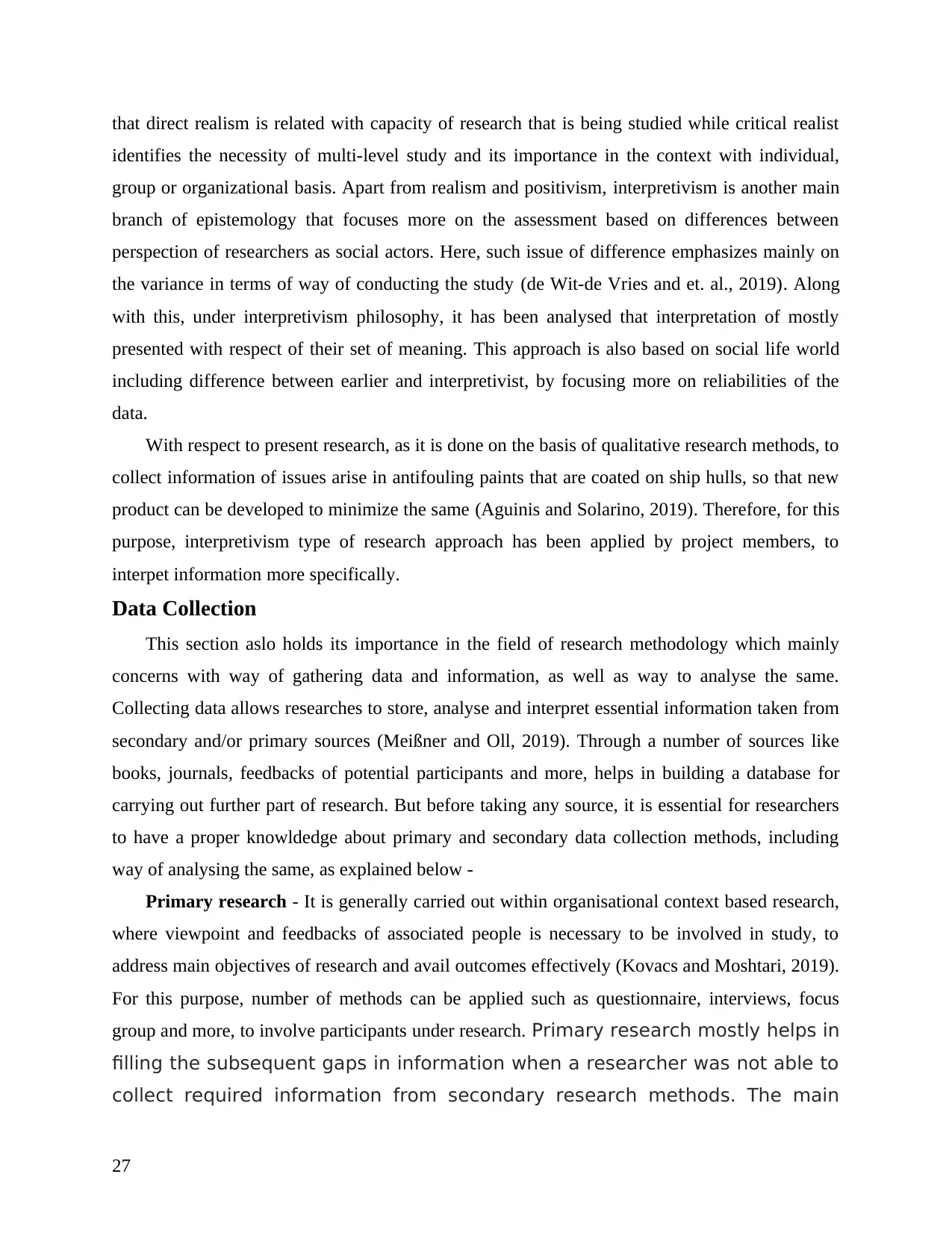
that direct realism is related with capacity of research that is being studied while critical realist
identifies the necessity of multi-level study and its importance in the context with individual,
group or organizational basis. Apart from realism and positivism, interpretivism is another main
branch of epistemology that focuses more on the assessment based on differences between
perspection of researchers as social actors. Here, such issue of difference emphasizes mainly on
the variance in terms of way of conducting the study (de Wit-de Vries and et. al., 2019). Along
with this, under interpretivism philosophy, it has been analysed that interpretation of mostly
presented with respect of their set of meaning. This approach is also based on social life world
including difference between earlier and interpretivist, by focusing more on reliabilities of the
data.
With respect to present research, as it is done on the basis of qualitative research methods, to
collect information of issues arise in antifouling paints that are coated on ship hulls, so that new
product can be developed to minimize the same (Aguinis and Solarino, 2019). Therefore, for this
purpose, interpretivism type of research approach has been applied by project members, to
interpet information more specifically.
Data Collection
This section aslo holds its importance in the field of research methodology which mainly
concerns with way of gathering data and information, as well as way to analyse the same.
Collecting data allows researches to store, analyse and interpret essential information taken from
secondary and/or primary sources (Meißner and Oll, 2019). Through a number of sources like
books, journals, feedbacks of potential participants and more, helps in building a database for
carrying out further part of research. But before taking any source, it is essential for researchers
to have a proper knowldedge about primary and secondary data collection methods, including
way of analysing the same, as explained below -
Primary research - It is generally carried out within organisational context based research,
where viewpoint and feedbacks of associated people is necessary to be involved in study, to
address main objectives of research and avail outcomes effectively (Kovacs and Moshtari, 2019).
For this purpose, number of methods can be applied such as questionnaire, interviews, focus
group and more, to involve participants under research. Primary research mostly helps in
filling the subsequent gaps in information when a researcher was not able to
collect required information from secondary research methods. The main
27
identifies the necessity of multi-level study and its importance in the context with individual,
group or organizational basis. Apart from realism and positivism, interpretivism is another main
branch of epistemology that focuses more on the assessment based on differences between
perspection of researchers as social actors. Here, such issue of difference emphasizes mainly on
the variance in terms of way of conducting the study (de Wit-de Vries and et. al., 2019). Along
with this, under interpretivism philosophy, it has been analysed that interpretation of mostly
presented with respect of their set of meaning. This approach is also based on social life world
including difference between earlier and interpretivist, by focusing more on reliabilities of the
data.
With respect to present research, as it is done on the basis of qualitative research methods, to
collect information of issues arise in antifouling paints that are coated on ship hulls, so that new
product can be developed to minimize the same (Aguinis and Solarino, 2019). Therefore, for this
purpose, interpretivism type of research approach has been applied by project members, to
interpet information more specifically.
Data Collection
This section aslo holds its importance in the field of research methodology which mainly
concerns with way of gathering data and information, as well as way to analyse the same.
Collecting data allows researches to store, analyse and interpret essential information taken from
secondary and/or primary sources (Meißner and Oll, 2019). Through a number of sources like
books, journals, feedbacks of potential participants and more, helps in building a database for
carrying out further part of research. But before taking any source, it is essential for researchers
to have a proper knowldedge about primary and secondary data collection methods, including
way of analysing the same, as explained below -
Primary research - It is generally carried out within organisational context based research,
where viewpoint and feedbacks of associated people is necessary to be involved in study, to
address main objectives of research and avail outcomes effectively (Kovacs and Moshtari, 2019).
For this purpose, number of methods can be applied such as questionnaire, interviews, focus
group and more, to involve participants under research. Primary research mostly helps in
filling the subsequent gaps in information when a researcher was not able to
collect required information from secondary research methods. The main
27
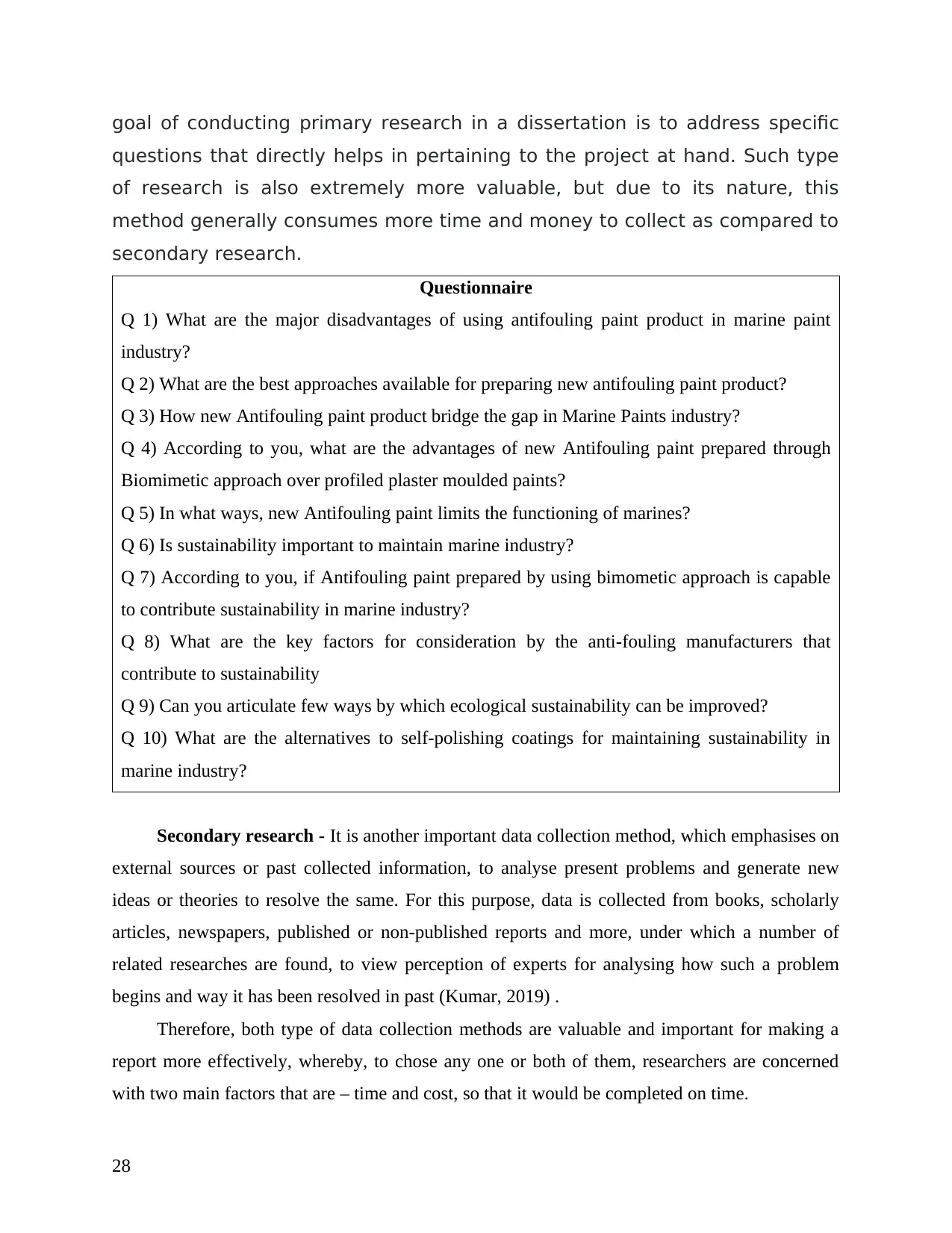
goal of conducting primary research in a dissertation is to address specific
questions that directly helps in pertaining to the project at hand. Such type
of research is also extremely more valuable, but due to its nature, this
method generally consumes more time and money to collect as compared to
secondary research.
Questionnaire
Q 1) What are the major disadvantages of using antifouling paint product in marine paint
industry?
Q 2) What are the best approaches available for preparing new antifouling paint product?
Q 3) How new Antifouling paint product bridge the gap in Marine Paints industry?
Q 4) According to you, what are the advantages of new Antifouling paint prepared through
Biomimetic approach over profiled plaster moulded paints?
Q 5) In what ways, new Antifouling paint limits the functioning of marines?
Q 6) Is sustainability important to maintain marine industry?
Q 7) According to you, if Antifouling paint prepared by using bimometic approach is capable
to contribute sustainability in marine industry?
Q 8) What are the key factors for consideration by the anti-fouling manufacturers that
contribute to sustainability
Q 9) Can you articulate few ways by which ecological sustainability can be improved?
Q 10) What are the alternatives to self-polishing coatings for maintaining sustainability in
marine industry?
Secondary research - It is another important data collection method, which emphasises on
external sources or past collected information, to analyse present problems and generate new
ideas or theories to resolve the same. For this purpose, data is collected from books, scholarly
articles, newspapers, published or non-published reports and more, under which a number of
related researches are found, to view perception of experts for analysing how such a problem
begins and way it has been resolved in past (Kumar, 2019) .
Therefore, both type of data collection methods are valuable and important for making a
report more effectively, whereby, to chose any one or both of them, researchers are concerned
with two main factors that are – time and cost, so that it would be completed on time.
28
questions that directly helps in pertaining to the project at hand. Such type
of research is also extremely more valuable, but due to its nature, this
method generally consumes more time and money to collect as compared to
secondary research.
Questionnaire
Q 1) What are the major disadvantages of using antifouling paint product in marine paint
industry?
Q 2) What are the best approaches available for preparing new antifouling paint product?
Q 3) How new Antifouling paint product bridge the gap in Marine Paints industry?
Q 4) According to you, what are the advantages of new Antifouling paint prepared through
Biomimetic approach over profiled plaster moulded paints?
Q 5) In what ways, new Antifouling paint limits the functioning of marines?
Q 6) Is sustainability important to maintain marine industry?
Q 7) According to you, if Antifouling paint prepared by using bimometic approach is capable
to contribute sustainability in marine industry?
Q 8) What are the key factors for consideration by the anti-fouling manufacturers that
contribute to sustainability
Q 9) Can you articulate few ways by which ecological sustainability can be improved?
Q 10) What are the alternatives to self-polishing coatings for maintaining sustainability in
marine industry?
Secondary research - It is another important data collection method, which emphasises on
external sources or past collected information, to analyse present problems and generate new
ideas or theories to resolve the same. For this purpose, data is collected from books, scholarly
articles, newspapers, published or non-published reports and more, under which a number of
related researches are found, to view perception of experts for analysing how such a problem
begins and way it has been resolved in past (Kumar, 2019) .
Therefore, both type of data collection methods are valuable and important for making a
report more effectively, whereby, to chose any one or both of them, researchers are concerned
with two main factors that are – time and cost, so that it would be completed on time.
28
Secure Best Marks with AI Grader
Need help grading? Try our AI Grader for instant feedback on your assignments.
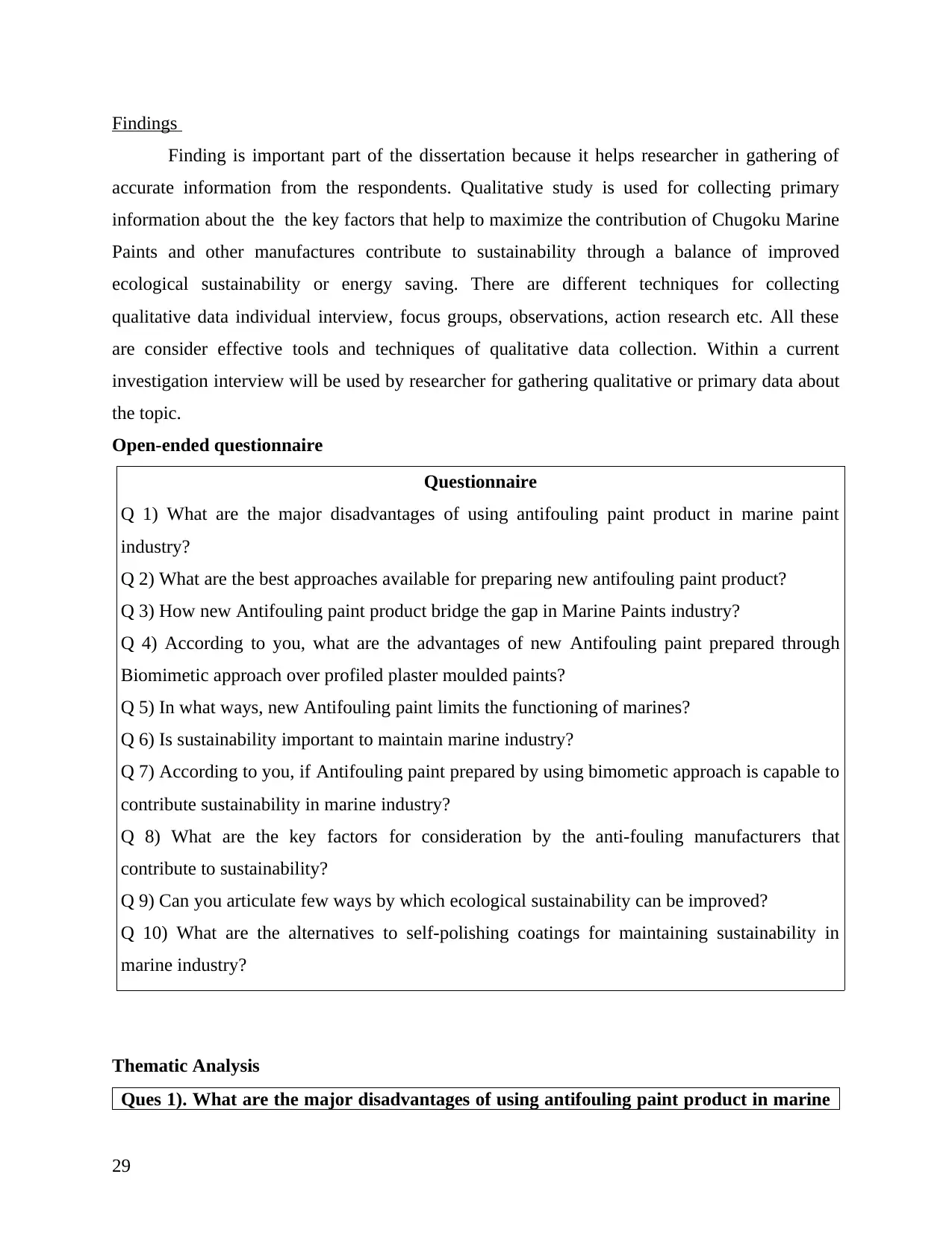
Findings
Finding is important part of the dissertation because it helps researcher in gathering of
accurate information from the respondents. Qualitative study is used for collecting primary
information about the the key factors that help to maximize the contribution of Chugoku Marine
Paints and other manufactures contribute to sustainability through a balance of improved
ecological sustainability or energy saving. There are different techniques for collecting
qualitative data individual interview, focus groups, observations, action research etc. All these
are consider effective tools and techniques of qualitative data collection. Within a current
investigation interview will be used by researcher for gathering qualitative or primary data about
the topic.
Open-ended questionnaire
Questionnaire
Q 1) What are the major disadvantages of using antifouling paint product in marine paint
industry?
Q 2) What are the best approaches available for preparing new antifouling paint product?
Q 3) How new Antifouling paint product bridge the gap in Marine Paints industry?
Q 4) According to you, what are the advantages of new Antifouling paint prepared through
Biomimetic approach over profiled plaster moulded paints?
Q 5) In what ways, new Antifouling paint limits the functioning of marines?
Q 6) Is sustainability important to maintain marine industry?
Q 7) According to you, if Antifouling paint prepared by using bimometic approach is capable to
contribute sustainability in marine industry?
Q 8) What are the key factors for consideration by the anti-fouling manufacturers that
contribute to sustainability?
Q 9) Can you articulate few ways by which ecological sustainability can be improved?
Q 10) What are the alternatives to self-polishing coatings for maintaining sustainability in
marine industry?
Thematic Analysis
Ques 1). What are the major disadvantages of using antifouling paint product in marine
29
Finding is important part of the dissertation because it helps researcher in gathering of
accurate information from the respondents. Qualitative study is used for collecting primary
information about the the key factors that help to maximize the contribution of Chugoku Marine
Paints and other manufactures contribute to sustainability through a balance of improved
ecological sustainability or energy saving. There are different techniques for collecting
qualitative data individual interview, focus groups, observations, action research etc. All these
are consider effective tools and techniques of qualitative data collection. Within a current
investigation interview will be used by researcher for gathering qualitative or primary data about
the topic.
Open-ended questionnaire
Questionnaire
Q 1) What are the major disadvantages of using antifouling paint product in marine paint
industry?
Q 2) What are the best approaches available for preparing new antifouling paint product?
Q 3) How new Antifouling paint product bridge the gap in Marine Paints industry?
Q 4) According to you, what are the advantages of new Antifouling paint prepared through
Biomimetic approach over profiled plaster moulded paints?
Q 5) In what ways, new Antifouling paint limits the functioning of marines?
Q 6) Is sustainability important to maintain marine industry?
Q 7) According to you, if Antifouling paint prepared by using bimometic approach is capable to
contribute sustainability in marine industry?
Q 8) What are the key factors for consideration by the anti-fouling manufacturers that
contribute to sustainability?
Q 9) Can you articulate few ways by which ecological sustainability can be improved?
Q 10) What are the alternatives to self-polishing coatings for maintaining sustainability in
marine industry?
Thematic Analysis
Ques 1). What are the major disadvantages of using antifouling paint product in marine
29
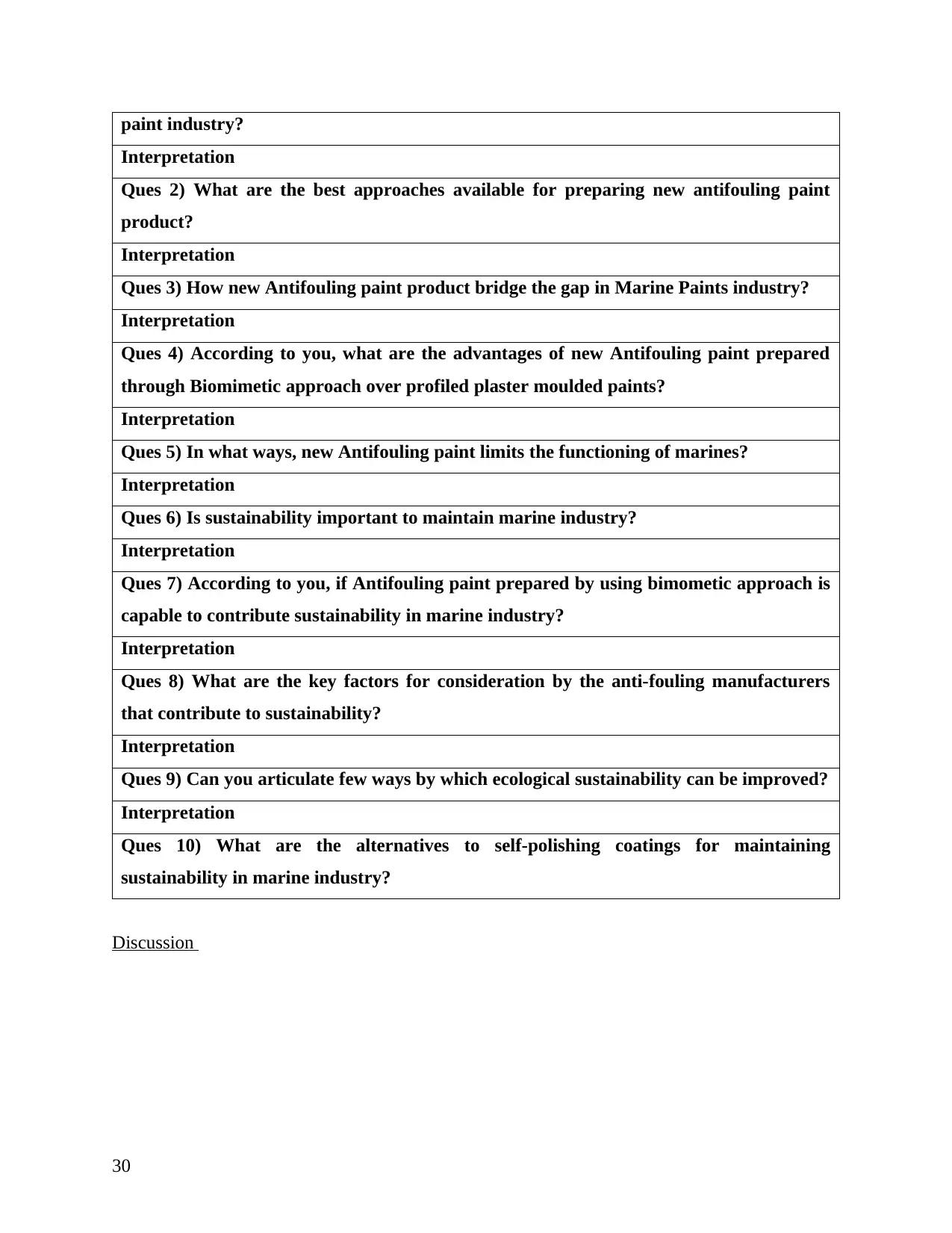
paint industry?
Interpretation
Ques 2) What are the best approaches available for preparing new antifouling paint
product?
Interpretation
Ques 3) How new Antifouling paint product bridge the gap in Marine Paints industry?
Interpretation
Ques 4) According to you, what are the advantages of new Antifouling paint prepared
through Biomimetic approach over profiled plaster moulded paints?
Interpretation
Ques 5) In what ways, new Antifouling paint limits the functioning of marines?
Interpretation
Ques 6) Is sustainability important to maintain marine industry?
Interpretation
Ques 7) According to you, if Antifouling paint prepared by using bimometic approach is
capable to contribute sustainability in marine industry?
Interpretation
Ques 8) What are the key factors for consideration by the anti-fouling manufacturers
that contribute to sustainability?
Interpretation
Ques 9) Can you articulate few ways by which ecological sustainability can be improved?
Interpretation
Ques 10) What are the alternatives to self-polishing coatings for maintaining
sustainability in marine industry?
Discussion
30
Interpretation
Ques 2) What are the best approaches available for preparing new antifouling paint
product?
Interpretation
Ques 3) How new Antifouling paint product bridge the gap in Marine Paints industry?
Interpretation
Ques 4) According to you, what are the advantages of new Antifouling paint prepared
through Biomimetic approach over profiled plaster moulded paints?
Interpretation
Ques 5) In what ways, new Antifouling paint limits the functioning of marines?
Interpretation
Ques 6) Is sustainability important to maintain marine industry?
Interpretation
Ques 7) According to you, if Antifouling paint prepared by using bimometic approach is
capable to contribute sustainability in marine industry?
Interpretation
Ques 8) What are the key factors for consideration by the anti-fouling manufacturers
that contribute to sustainability?
Interpretation
Ques 9) Can you articulate few ways by which ecological sustainability can be improved?
Interpretation
Ques 10) What are the alternatives to self-polishing coatings for maintaining
sustainability in marine industry?
Discussion
30
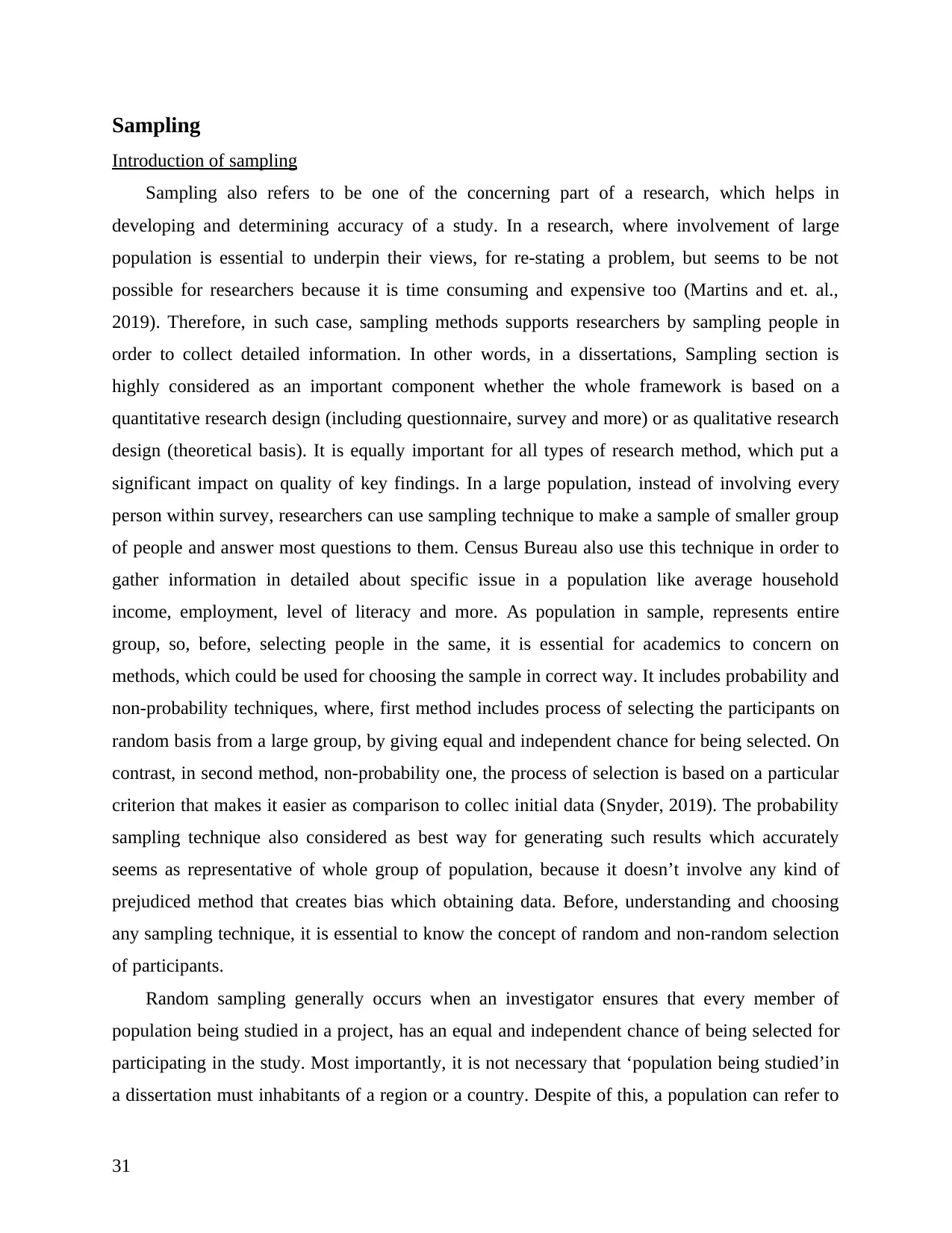
Sampling
Introduction of sampling
Sampling also refers to be one of the concerning part of a research, which helps in
developing and determining accuracy of a study. In a research, where involvement of large
population is essential to underpin their views, for re-stating a problem, but seems to be not
possible for researchers because it is time consuming and expensive too (Martins and et. al.,
2019). Therefore, in such case, sampling methods supports researchers by sampling people in
order to collect detailed information. In other words, in a dissertations, Sampling section is
highly considered as an important component whether the whole framework is based on a
quantitative research design (including questionnaire, survey and more) or as qualitative research
design (theoretical basis). It is equally important for all types of research method, which put a
significant impact on quality of key findings. In a large population, instead of involving every
person within survey, researchers can use sampling technique to make a sample of smaller group
of people and answer most questions to them. Census Bureau also use this technique in order to
gather information in detailed about specific issue in a population like average household
income, employment, level of literacy and more. As population in sample, represents entire
group, so, before, selecting people in the same, it is essential for academics to concern on
methods, which could be used for choosing the sample in correct way. It includes probability and
non-probability techniques, where, first method includes process of selecting the participants on
random basis from a large group, by giving equal and independent chance for being selected. On
contrast, in second method, non-probability one, the process of selection is based on a particular
criterion that makes it easier as comparison to collec initial data (Snyder, 2019). The probability
sampling technique also considered as best way for generating such results which accurately
seems as representative of whole group of population, because it doesn’t involve any kind of
prejudiced method that creates bias which obtaining data. Before, understanding and choosing
any sampling technique, it is essential to know the concept of random and non-random selection
of participants.
Random sampling generally occurs when an investigator ensures that every member of
population being studied in a project, has an equal and independent chance of being selected for
participating in the study. Most importantly, it is not necessary that ‘population being studied’in
a dissertation must inhabitants of a region or a country. Despite of this, a population can refer to
31
Introduction of sampling
Sampling also refers to be one of the concerning part of a research, which helps in
developing and determining accuracy of a study. In a research, where involvement of large
population is essential to underpin their views, for re-stating a problem, but seems to be not
possible for researchers because it is time consuming and expensive too (Martins and et. al.,
2019). Therefore, in such case, sampling methods supports researchers by sampling people in
order to collect detailed information. In other words, in a dissertations, Sampling section is
highly considered as an important component whether the whole framework is based on a
quantitative research design (including questionnaire, survey and more) or as qualitative research
design (theoretical basis). It is equally important for all types of research method, which put a
significant impact on quality of key findings. In a large population, instead of involving every
person within survey, researchers can use sampling technique to make a sample of smaller group
of people and answer most questions to them. Census Bureau also use this technique in order to
gather information in detailed about specific issue in a population like average household
income, employment, level of literacy and more. As population in sample, represents entire
group, so, before, selecting people in the same, it is essential for academics to concern on
methods, which could be used for choosing the sample in correct way. It includes probability and
non-probability techniques, where, first method includes process of selecting the participants on
random basis from a large group, by giving equal and independent chance for being selected. On
contrast, in second method, non-probability one, the process of selection is based on a particular
criterion that makes it easier as comparison to collec initial data (Snyder, 2019). The probability
sampling technique also considered as best way for generating such results which accurately
seems as representative of whole group of population, because it doesn’t involve any kind of
prejudiced method that creates bias which obtaining data. Before, understanding and choosing
any sampling technique, it is essential to know the concept of random and non-random selection
of participants.
Random sampling generally occurs when an investigator ensures that every member of
population being studied in a project, has an equal and independent chance of being selected for
participating in the study. Most importantly, it is not necessary that ‘population being studied’in
a dissertation must inhabitants of a region or a country. Despite of this, a population can refer to
31
Paraphrase This Document
Need a fresh take? Get an instant paraphrase of this document with our AI Paraphraser
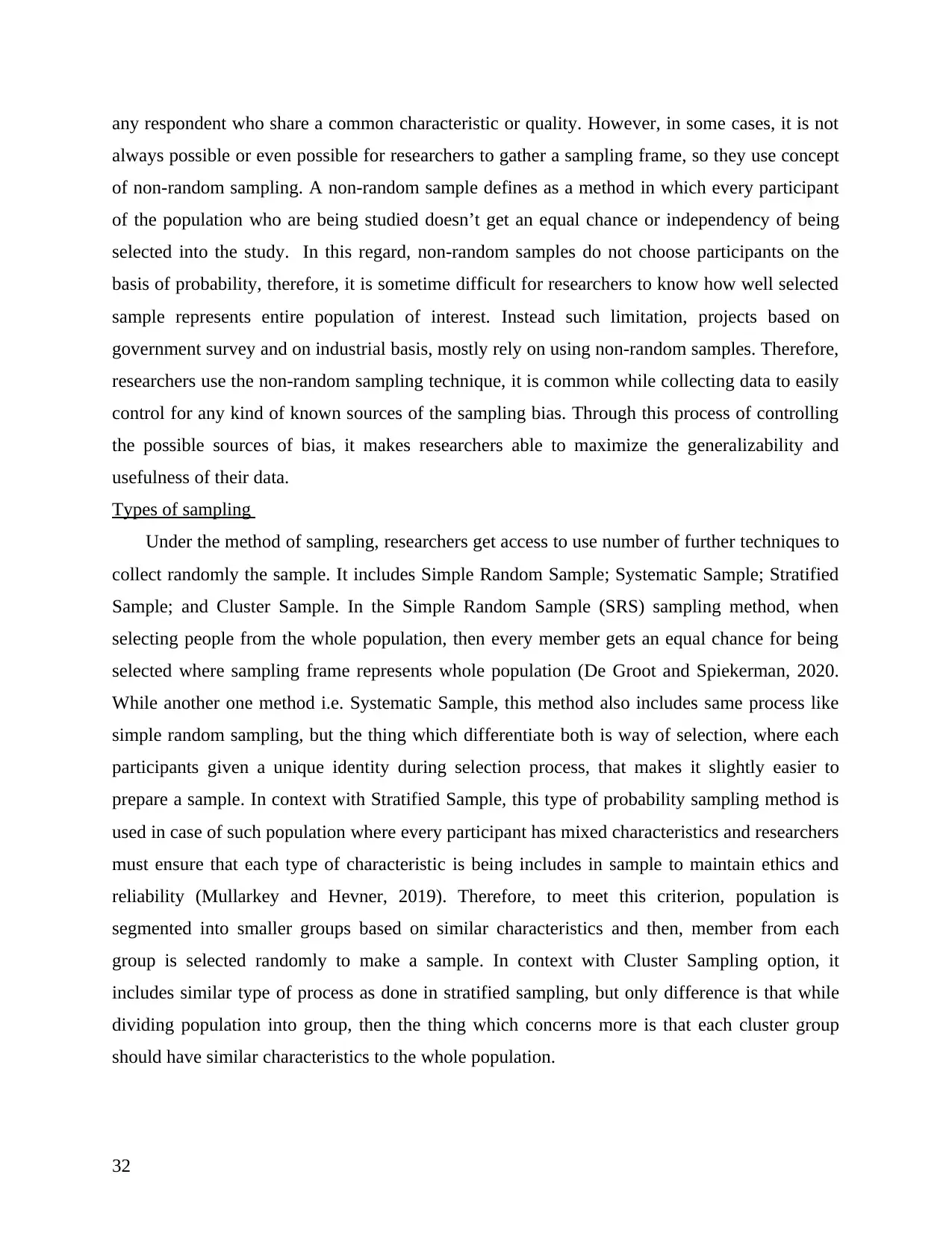
any respondent who share a common characteristic or quality. However, in some cases, it is not
always possible or even possible for researchers to gather a sampling frame, so they use concept
of non-random sampling. A non-random sample defines as a method in which every participant
of the population who are being studied doesn’t get an equal chance or independency of being
selected into the study. In this regard, non-random samples do not choose participants on the
basis of probability, therefore, it is sometime difficult for researchers to know how well selected
sample represents entire population of interest. Instead such limitation, projects based on
government survey and on industrial basis, mostly rely on using non-random samples. Therefore,
researchers use the non-random sampling technique, it is common while collecting data to easily
control for any kind of known sources of the sampling bias. Through this process of controlling
the possible sources of bias, it makes researchers able to maximize the generalizability and
usefulness of their data.
Types of sampling
Under the method of sampling, researchers get access to use number of further techniques to
collect randomly the sample. It includes Simple Random Sample; Systematic Sample; Stratified
Sample; and Cluster Sample. In the Simple Random Sample (SRS) sampling method, when
selecting people from the whole population, then every member gets an equal chance for being
selected where sampling frame represents whole population (De Groot and Spiekerman, 2020.
While another one method i.e. Systematic Sample, this method also includes same process like
simple random sampling, but the thing which differentiate both is way of selection, where each
participants given a unique identity during selection process, that makes it slightly easier to
prepare a sample. In context with Stratified Sample, this type of probability sampling method is
used in case of such population where every participant has mixed characteristics and researchers
must ensure that each type of characteristic is being includes in sample to maintain ethics and
reliability (Mullarkey and Hevner, 2019). Therefore, to meet this criterion, population is
segmented into smaller groups based on similar characteristics and then, member from each
group is selected randomly to make a sample. In context with Cluster Sampling option, it
includes similar type of process as done in stratified sampling, but only difference is that while
dividing population into group, then the thing which concerns more is that each cluster group
should have similar characteristics to the whole population.
32
always possible or even possible for researchers to gather a sampling frame, so they use concept
of non-random sampling. A non-random sample defines as a method in which every participant
of the population who are being studied doesn’t get an equal chance or independency of being
selected into the study. In this regard, non-random samples do not choose participants on the
basis of probability, therefore, it is sometime difficult for researchers to know how well selected
sample represents entire population of interest. Instead such limitation, projects based on
government survey and on industrial basis, mostly rely on using non-random samples. Therefore,
researchers use the non-random sampling technique, it is common while collecting data to easily
control for any kind of known sources of the sampling bias. Through this process of controlling
the possible sources of bias, it makes researchers able to maximize the generalizability and
usefulness of their data.
Types of sampling
Under the method of sampling, researchers get access to use number of further techniques to
collect randomly the sample. It includes Simple Random Sample; Systematic Sample; Stratified
Sample; and Cluster Sample. In the Simple Random Sample (SRS) sampling method, when
selecting people from the whole population, then every member gets an equal chance for being
selected where sampling frame represents whole population (De Groot and Spiekerman, 2020.
While another one method i.e. Systematic Sample, this method also includes same process like
simple random sampling, but the thing which differentiate both is way of selection, where each
participants given a unique identity during selection process, that makes it slightly easier to
prepare a sample. In context with Stratified Sample, this type of probability sampling method is
used in case of such population where every participant has mixed characteristics and researchers
must ensure that each type of characteristic is being includes in sample to maintain ethics and
reliability (Mullarkey and Hevner, 2019). Therefore, to meet this criterion, population is
segmented into smaller groups based on similar characteristics and then, member from each
group is selected randomly to make a sample. In context with Cluster Sampling option, it
includes similar type of process as done in stratified sampling, but only difference is that while
dividing population into group, then the thing which concerns more is that each cluster group
should have similar characteristics to the whole population.
32
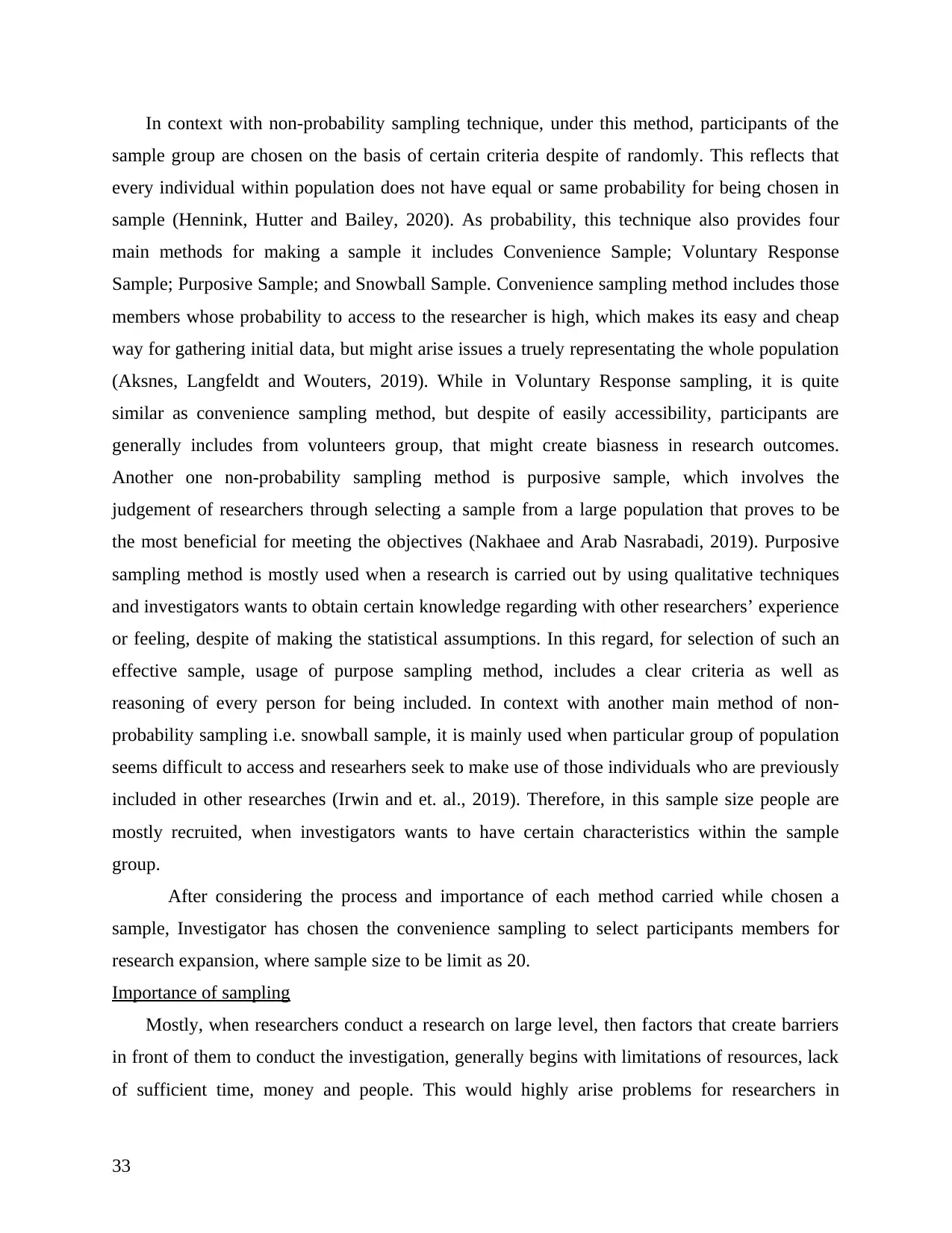
In context with non-probability sampling technique, under this method, participants of the
sample group are chosen on the basis of certain criteria despite of randomly. This reflects that
every individual within population does not have equal or same probability for being chosen in
sample (Hennink, Hutter and Bailey, 2020). As probability, this technique also provides four
main methods for making a sample it includes Convenience Sample; Voluntary Response
Sample; Purposive Sample; and Snowball Sample. Convenience sampling method includes those
members whose probability to access to the researcher is high, which makes its easy and cheap
way for gathering initial data, but might arise issues a truely representating the whole population
(Aksnes, Langfeldt and Wouters, 2019). While in Voluntary Response sampling, it is quite
similar as convenience sampling method, but despite of easily accessibility, participants are
generally includes from volunteers group, that might create biasness in research outcomes.
Another one non-probability sampling method is purposive sample, which involves the
judgement of researchers through selecting a sample from a large population that proves to be
the most beneficial for meeting the objectives (Nakhaee and Arab Nasrabadi, 2019). Purposive
sampling method is mostly used when a research is carried out by using qualitative techniques
and investigators wants to obtain certain knowledge regarding with other researchers’ experience
or feeling, despite of making the statistical assumptions. In this regard, for selection of such an
effective sample, usage of purpose sampling method, includes a clear criteria as well as
reasoning of every person for being included. In context with another main method of non-
probability sampling i.e. snowball sample, it is mainly used when particular group of population
seems difficult to access and researhers seek to make use of those individuals who are previously
included in other researches (Irwin and et. al., 2019). Therefore, in this sample size people are
mostly recruited, when investigators wants to have certain characteristics within the sample
group.
After considering the process and importance of each method carried while chosen a
sample, Investigator has chosen the convenience sampling to select participants members for
research expansion, where sample size to be limit as 20.
Importance of sampling
Mostly, when researchers conduct a research on large level, then factors that create barriers
in front of them to conduct the investigation, generally begins with limitations of resources, lack
of sufficient time, money and people. This would highly arise problems for researchers in
33
sample group are chosen on the basis of certain criteria despite of randomly. This reflects that
every individual within population does not have equal or same probability for being chosen in
sample (Hennink, Hutter and Bailey, 2020). As probability, this technique also provides four
main methods for making a sample it includes Convenience Sample; Voluntary Response
Sample; Purposive Sample; and Snowball Sample. Convenience sampling method includes those
members whose probability to access to the researcher is high, which makes its easy and cheap
way for gathering initial data, but might arise issues a truely representating the whole population
(Aksnes, Langfeldt and Wouters, 2019). While in Voluntary Response sampling, it is quite
similar as convenience sampling method, but despite of easily accessibility, participants are
generally includes from volunteers group, that might create biasness in research outcomes.
Another one non-probability sampling method is purposive sample, which involves the
judgement of researchers through selecting a sample from a large population that proves to be
the most beneficial for meeting the objectives (Nakhaee and Arab Nasrabadi, 2019). Purposive
sampling method is mostly used when a research is carried out by using qualitative techniques
and investigators wants to obtain certain knowledge regarding with other researchers’ experience
or feeling, despite of making the statistical assumptions. In this regard, for selection of such an
effective sample, usage of purpose sampling method, includes a clear criteria as well as
reasoning of every person for being included. In context with another main method of non-
probability sampling i.e. snowball sample, it is mainly used when particular group of population
seems difficult to access and researhers seek to make use of those individuals who are previously
included in other researches (Irwin and et. al., 2019). Therefore, in this sample size people are
mostly recruited, when investigators wants to have certain characteristics within the sample
group.
After considering the process and importance of each method carried while chosen a
sample, Investigator has chosen the convenience sampling to select participants members for
research expansion, where sample size to be limit as 20.
Importance of sampling
Mostly, when researchers conduct a research on large level, then factors that create barriers
in front of them to conduct the investigation, generally begins with limitations of resources, lack
of sufficient time, money and people. This would highly arise problems for researchers in
33
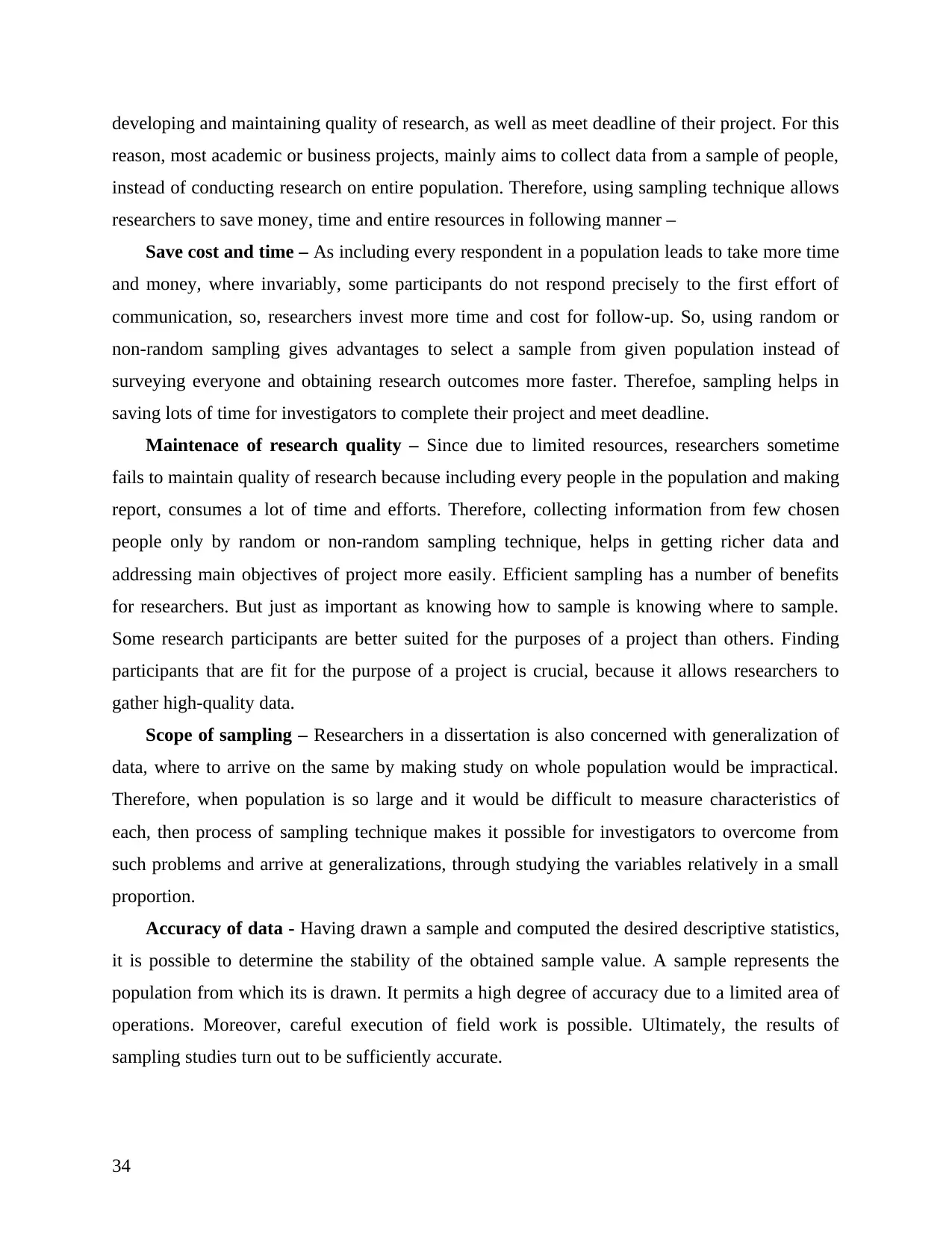
developing and maintaining quality of research, as well as meet deadline of their project. For this
reason, most academic or business projects, mainly aims to collect data from a sample of people,
instead of conducting research on entire population. Therefore, using sampling technique allows
researchers to save money, time and entire resources in following manner –
Save cost and time – As including every respondent in a population leads to take more time
and money, where invariably, some participants do not respond precisely to the first effort of
communication, so, researchers invest more time and cost for follow-up. So, using random or
non-random sampling gives advantages to select a sample from given population instead of
surveying everyone and obtaining research outcomes more faster. Therefoe, sampling helps in
saving lots of time for investigators to complete their project and meet deadline.
Maintenace of research quality – Since due to limited resources, researchers sometime
fails to maintain quality of research because including every people in the population and making
report, consumes a lot of time and efforts. Therefore, collecting information from few chosen
people only by random or non-random sampling technique, helps in getting richer data and
addressing main objectives of project more easily. Efficient sampling has a number of benefits
for researchers. But just as important as knowing how to sample is knowing where to sample.
Some research participants are better suited for the purposes of a project than others. Finding
participants that are fit for the purpose of a project is crucial, because it allows researchers to
gather high-quality data.
Scope of sampling – Researchers in a dissertation is also concerned with generalization of
data, where to arrive on the same by making study on whole population would be impractical.
Therefore, when population is so large and it would be difficult to measure characteristics of
each, then process of sampling technique makes it possible for investigators to overcome from
such problems and arrive at generalizations, through studying the variables relatively in a small
proportion.
Accuracy of data - Having drawn a sample and computed the desired descriptive statistics,
it is possible to determine the stability of the obtained sample value. A sample represents the
population from which its is drawn. It permits a high degree of accuracy due to a limited area of
operations. Moreover, careful execution of field work is possible. Ultimately, the results of
sampling studies turn out to be sufficiently accurate.
34
reason, most academic or business projects, mainly aims to collect data from a sample of people,
instead of conducting research on entire population. Therefore, using sampling technique allows
researchers to save money, time and entire resources in following manner –
Save cost and time – As including every respondent in a population leads to take more time
and money, where invariably, some participants do not respond precisely to the first effort of
communication, so, researchers invest more time and cost for follow-up. So, using random or
non-random sampling gives advantages to select a sample from given population instead of
surveying everyone and obtaining research outcomes more faster. Therefoe, sampling helps in
saving lots of time for investigators to complete their project and meet deadline.
Maintenace of research quality – Since due to limited resources, researchers sometime
fails to maintain quality of research because including every people in the population and making
report, consumes a lot of time and efforts. Therefore, collecting information from few chosen
people only by random or non-random sampling technique, helps in getting richer data and
addressing main objectives of project more easily. Efficient sampling has a number of benefits
for researchers. But just as important as knowing how to sample is knowing where to sample.
Some research participants are better suited for the purposes of a project than others. Finding
participants that are fit for the purpose of a project is crucial, because it allows researchers to
gather high-quality data.
Scope of sampling – Researchers in a dissertation is also concerned with generalization of
data, where to arrive on the same by making study on whole population would be impractical.
Therefore, when population is so large and it would be difficult to measure characteristics of
each, then process of sampling technique makes it possible for investigators to overcome from
such problems and arrive at generalizations, through studying the variables relatively in a small
proportion.
Accuracy of data - Having drawn a sample and computed the desired descriptive statistics,
it is possible to determine the stability of the obtained sample value. A sample represents the
population from which its is drawn. It permits a high degree of accuracy due to a limited area of
operations. Moreover, careful execution of field work is possible. Ultimately, the results of
sampling studies turn out to be sufficiently accurate.
34
Secure Best Marks with AI Grader
Need help grading? Try our AI Grader for instant feedback on your assignments.
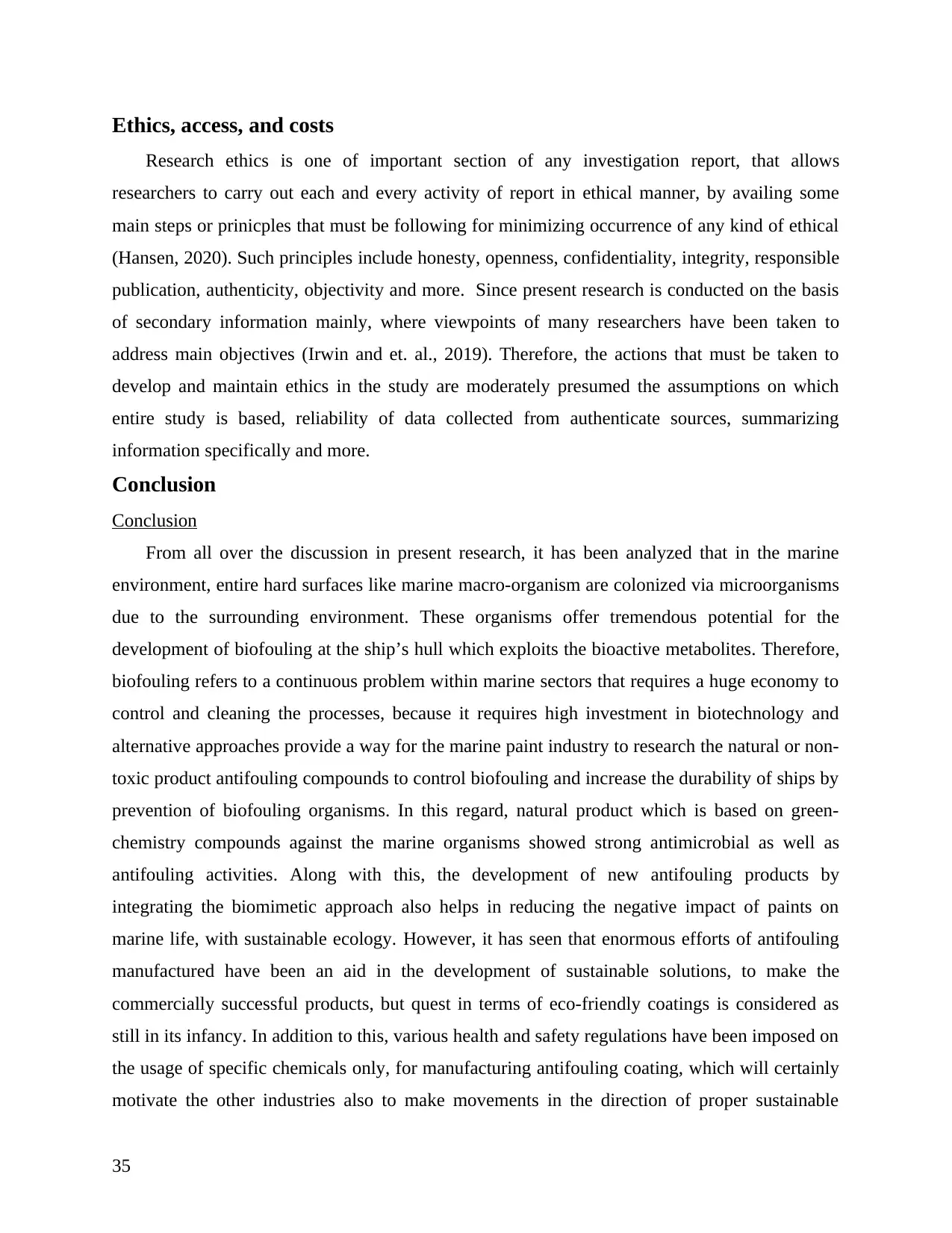
Ethics, access, and costs
Research ethics is one of important section of any investigation report, that allows
researchers to carry out each and every activity of report in ethical manner, by availing some
main steps or prinicples that must be following for minimizing occurrence of any kind of ethical
(Hansen, 2020). Such principles include honesty, openness, confidentiality, integrity, responsible
publication, authenticity, objectivity and more. Since present research is conducted on the basis
of secondary information mainly, where viewpoints of many researchers have been taken to
address main objectives (Irwin and et. al., 2019). Therefore, the actions that must be taken to
develop and maintain ethics in the study are moderately presumed the assumptions on which
entire study is based, reliability of data collected from authenticate sources, summarizing
information specifically and more.
Conclusion
Conclusion
From all over the discussion in present research, it has been analyzed that in the marine
environment, entire hard surfaces like marine macro-organism are colonized via microorganisms
due to the surrounding environment. These organisms offer tremendous potential for the
development of biofouling at the ship’s hull which exploits the bioactive metabolites. Therefore,
biofouling refers to a continuous problem within marine sectors that requires a huge economy to
control and cleaning the processes, because it requires high investment in biotechnology and
alternative approaches provide a way for the marine paint industry to research the natural or non-
toxic product antifouling compounds to control biofouling and increase the durability of ships by
prevention of biofouling organisms. In this regard, natural product which is based on green-
chemistry compounds against the marine organisms showed strong antimicrobial as well as
antifouling activities. Along with this, the development of new antifouling products by
integrating the biomimetic approach also helps in reducing the negative impact of paints on
marine life, with sustainable ecology. However, it has seen that enormous efforts of antifouling
manufactured have been an aid in the development of sustainable solutions, to make the
commercially successful products, but quest in terms of eco-friendly coatings is considered as
still in its infancy. In addition to this, various health and safety regulations have been imposed on
the usage of specific chemicals only, for manufacturing antifouling coating, which will certainly
motivate the other industries also to make movements in the direction of proper sustainable
35
Research ethics is one of important section of any investigation report, that allows
researchers to carry out each and every activity of report in ethical manner, by availing some
main steps or prinicples that must be following for minimizing occurrence of any kind of ethical
(Hansen, 2020). Such principles include honesty, openness, confidentiality, integrity, responsible
publication, authenticity, objectivity and more. Since present research is conducted on the basis
of secondary information mainly, where viewpoints of many researchers have been taken to
address main objectives (Irwin and et. al., 2019). Therefore, the actions that must be taken to
develop and maintain ethics in the study are moderately presumed the assumptions on which
entire study is based, reliability of data collected from authenticate sources, summarizing
information specifically and more.
Conclusion
Conclusion
From all over the discussion in present research, it has been analyzed that in the marine
environment, entire hard surfaces like marine macro-organism are colonized via microorganisms
due to the surrounding environment. These organisms offer tremendous potential for the
development of biofouling at the ship’s hull which exploits the bioactive metabolites. Therefore,
biofouling refers to a continuous problem within marine sectors that requires a huge economy to
control and cleaning the processes, because it requires high investment in biotechnology and
alternative approaches provide a way for the marine paint industry to research the natural or non-
toxic product antifouling compounds to control biofouling and increase the durability of ships by
prevention of biofouling organisms. In this regard, natural product which is based on green-
chemistry compounds against the marine organisms showed strong antimicrobial as well as
antifouling activities. Along with this, the development of new antifouling products by
integrating the biomimetic approach also helps in reducing the negative impact of paints on
marine life, with sustainable ecology. However, it has seen that enormous efforts of antifouling
manufactured have been an aid in the development of sustainable solutions, to make the
commercially successful products, but quest in terms of eco-friendly coatings is considered as
still in its infancy. In addition to this, various health and safety regulations have been imposed on
the usage of specific chemicals only, for manufacturing antifouling coating, which will certainly
motivate the other industries also to make movements in the direction of proper sustainable
35
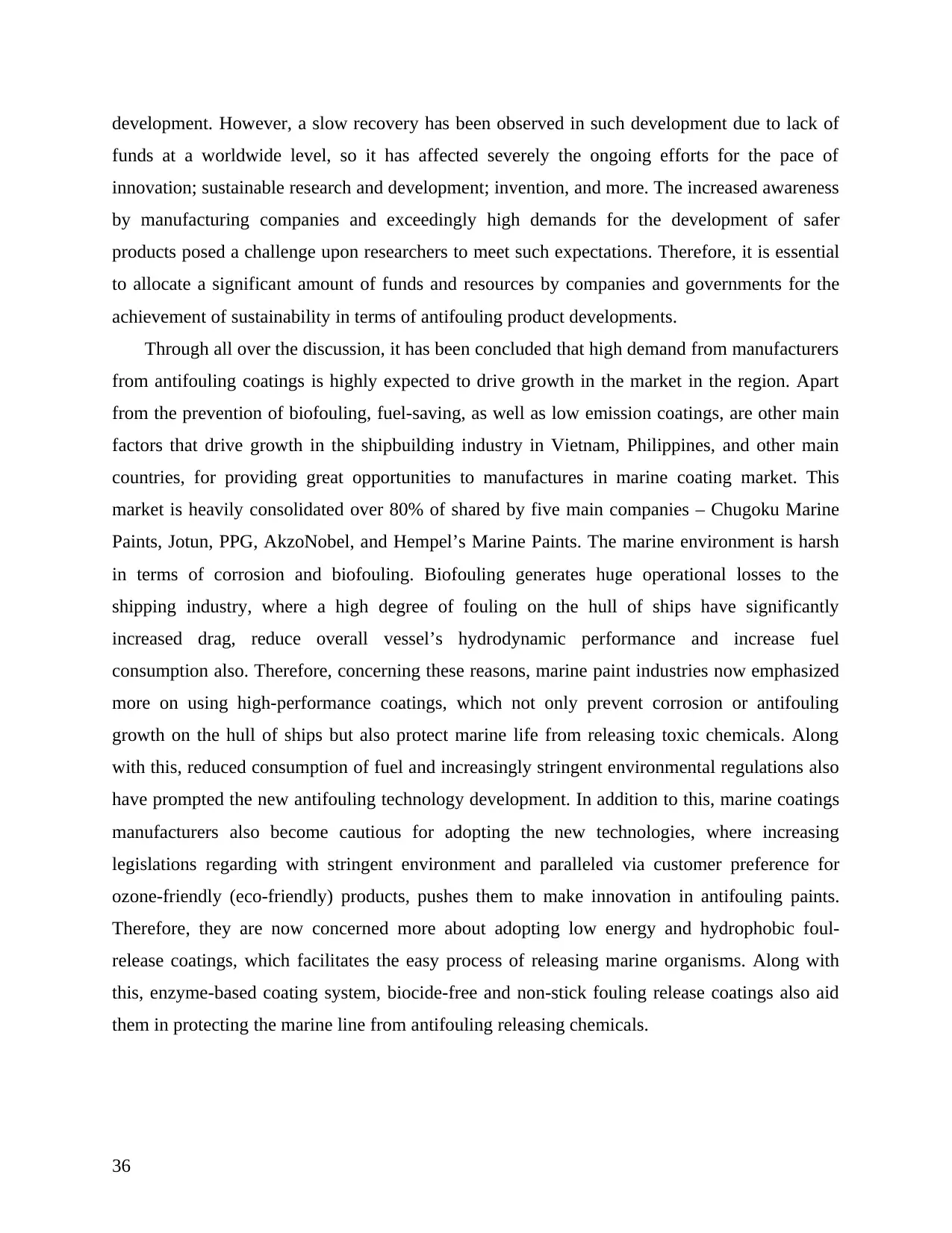
development. However, a slow recovery has been observed in such development due to lack of
funds at a worldwide level, so it has affected severely the ongoing efforts for the pace of
innovation; sustainable research and development; invention, and more. The increased awareness
by manufacturing companies and exceedingly high demands for the development of safer
products posed a challenge upon researchers to meet such expectations. Therefore, it is essential
to allocate a significant amount of funds and resources by companies and governments for the
achievement of sustainability in terms of antifouling product developments.
Through all over the discussion, it has been concluded that high demand from manufacturers
from antifouling coatings is highly expected to drive growth in the market in the region. Apart
from the prevention of biofouling, fuel-saving, as well as low emission coatings, are other main
factors that drive growth in the shipbuilding industry in Vietnam, Philippines, and other main
countries, for providing great opportunities to manufactures in marine coating market. This
market is heavily consolidated over 80% of shared by five main companies – Chugoku Marine
Paints, Jotun, PPG, AkzoNobel, and Hempel’s Marine Paints. The marine environment is harsh
in terms of corrosion and biofouling. Biofouling generates huge operational losses to the
shipping industry, where a high degree of fouling on the hull of ships have significantly
increased drag, reduce overall vessel’s hydrodynamic performance and increase fuel
consumption also. Therefore, concerning these reasons, marine paint industries now emphasized
more on using high-performance coatings, which not only prevent corrosion or antifouling
growth on the hull of ships but also protect marine life from releasing toxic chemicals. Along
with this, reduced consumption of fuel and increasingly stringent environmental regulations also
have prompted the new antifouling technology development. In addition to this, marine coatings
manufacturers also become cautious for adopting the new technologies, where increasing
legislations regarding with stringent environment and paralleled via customer preference for
ozone-friendly (eco-friendly) products, pushes them to make innovation in antifouling paints.
Therefore, they are now concerned more about adopting low energy and hydrophobic foul-
release coatings, which facilitates the easy process of releasing marine organisms. Along with
this, enzyme-based coating system, biocide-free and non-stick fouling release coatings also aid
them in protecting the marine line from antifouling releasing chemicals.
36
funds at a worldwide level, so it has affected severely the ongoing efforts for the pace of
innovation; sustainable research and development; invention, and more. The increased awareness
by manufacturing companies and exceedingly high demands for the development of safer
products posed a challenge upon researchers to meet such expectations. Therefore, it is essential
to allocate a significant amount of funds and resources by companies and governments for the
achievement of sustainability in terms of antifouling product developments.
Through all over the discussion, it has been concluded that high demand from manufacturers
from antifouling coatings is highly expected to drive growth in the market in the region. Apart
from the prevention of biofouling, fuel-saving, as well as low emission coatings, are other main
factors that drive growth in the shipbuilding industry in Vietnam, Philippines, and other main
countries, for providing great opportunities to manufactures in marine coating market. This
market is heavily consolidated over 80% of shared by five main companies – Chugoku Marine
Paints, Jotun, PPG, AkzoNobel, and Hempel’s Marine Paints. The marine environment is harsh
in terms of corrosion and biofouling. Biofouling generates huge operational losses to the
shipping industry, where a high degree of fouling on the hull of ships have significantly
increased drag, reduce overall vessel’s hydrodynamic performance and increase fuel
consumption also. Therefore, concerning these reasons, marine paint industries now emphasized
more on using high-performance coatings, which not only prevent corrosion or antifouling
growth on the hull of ships but also protect marine life from releasing toxic chemicals. Along
with this, reduced consumption of fuel and increasingly stringent environmental regulations also
have prompted the new antifouling technology development. In addition to this, marine coatings
manufacturers also become cautious for adopting the new technologies, where increasing
legislations regarding with stringent environment and paralleled via customer preference for
ozone-friendly (eco-friendly) products, pushes them to make innovation in antifouling paints.
Therefore, they are now concerned more about adopting low energy and hydrophobic foul-
release coatings, which facilitates the easy process of releasing marine organisms. Along with
this, enzyme-based coating system, biocide-free and non-stick fouling release coatings also aid
them in protecting the marine line from antifouling releasing chemicals.
36
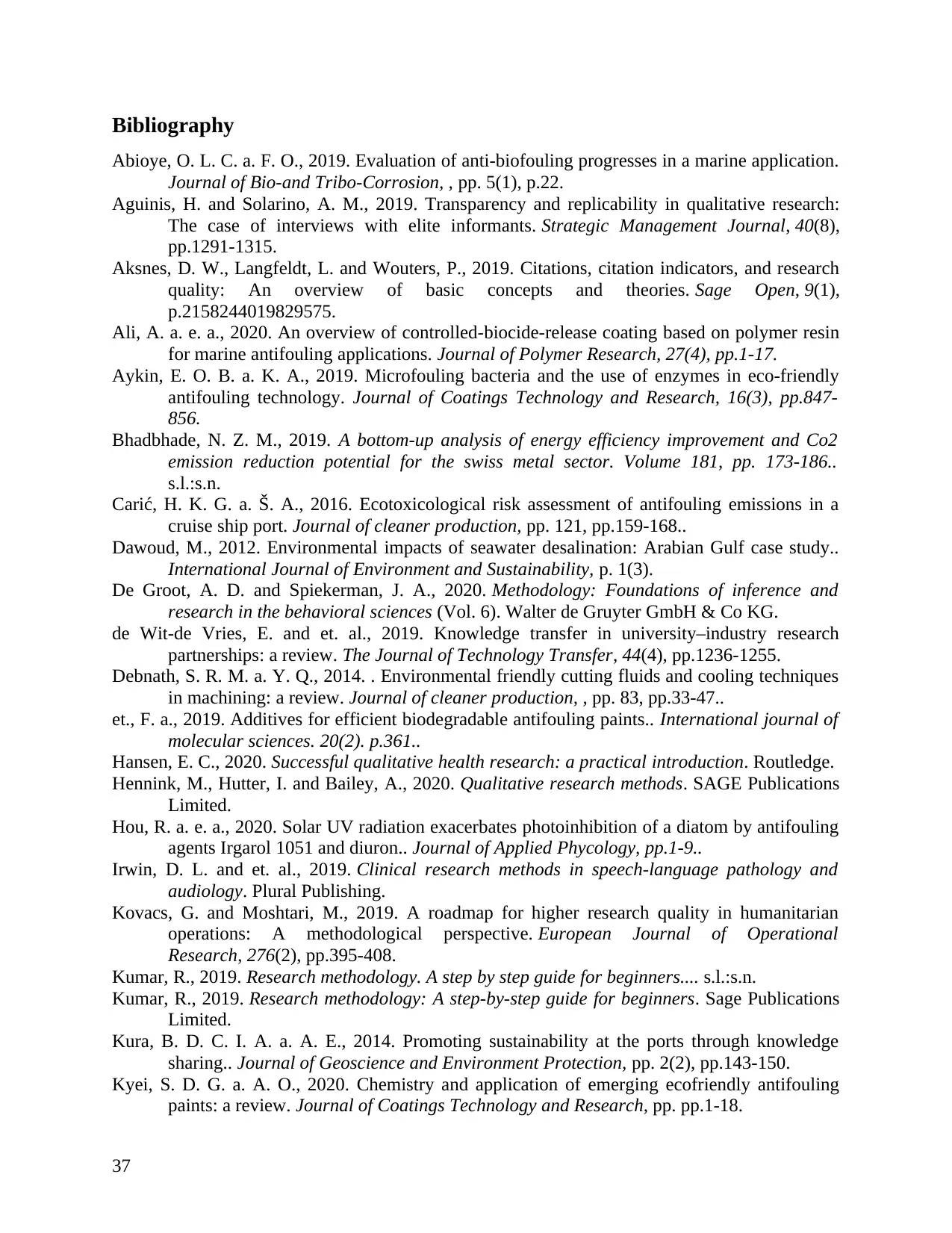
Bibliography
Abioye, O. L. C. a. F. O., 2019. Evaluation of anti-biofouling progresses in a marine application.
Journal of Bio-and Tribo-Corrosion, , pp. 5(1), p.22.
Aguinis, H. and Solarino, A. M., 2019. Transparency and replicability in qualitative research:
The case of interviews with elite informants. Strategic Management Journal, 40(8),
pp.1291-1315.
Aksnes, D. W., Langfeldt, L. and Wouters, P., 2019. Citations, citation indicators, and research
quality: An overview of basic concepts and theories. Sage Open, 9(1),
p.2158244019829575.
Ali, A. a. e. a., 2020. An overview of controlled-biocide-release coating based on polymer resin
for marine antifouling applications. Journal of Polymer Research, 27(4), pp.1-17.
Aykin, E. O. B. a. K. A., 2019. Microfouling bacteria and the use of enzymes in eco-friendly
antifouling technology. Journal of Coatings Technology and Research, 16(3), pp.847-
856.
Bhadbhade, N. Z. M., 2019. A bottom-up analysis of energy efficiency improvement and Co2
emission reduction potential for the swiss metal sector. Volume 181, pp. 173-186..
s.l.:s.n.
Carić, H. K. G. a. Š. A., 2016. Ecotoxicological risk assessment of antifouling emissions in a
cruise ship port. Journal of cleaner production, pp. 121, pp.159-168..
Dawoud, M., 2012. Environmental impacts of seawater desalination: Arabian Gulf case study..
International Journal of Environment and Sustainability, p. 1(3).
De Groot, A. D. and Spiekerman, J. A., 2020. Methodology: Foundations of inference and
research in the behavioral sciences (Vol. 6). Walter de Gruyter GmbH & Co KG.
de Wit-de Vries, E. and et. al., 2019. Knowledge transfer in university–industry research
partnerships: a review. The Journal of Technology Transfer, 44(4), pp.1236-1255.
Debnath, S. R. M. a. Y. Q., 2014. . Environmental friendly cutting fluids and cooling techniques
in machining: a review. Journal of cleaner production, , pp. 83, pp.33-47..
et., F. a., 2019. Additives for efficient biodegradable antifouling paints.. International journal of
molecular sciences. 20(2). p.361..
Hansen, E. C., 2020. Successful qualitative health research: a practical introduction. Routledge.
Hennink, M., Hutter, I. and Bailey, A., 2020. Qualitative research methods. SAGE Publications
Limited.
Hou, R. a. e. a., 2020. Solar UV radiation exacerbates photoinhibition of a diatom by antifouling
agents Irgarol 1051 and diuron.. Journal of Applied Phycology, pp.1-9..
Irwin, D. L. and et. al., 2019. Clinical research methods in speech-language pathology and
audiology. Plural Publishing.
Kovacs, G. and Moshtari, M., 2019. A roadmap for higher research quality in humanitarian
operations: A methodological perspective. European Journal of Operational
Research, 276(2), pp.395-408.
Kumar, R., 2019. Research methodology. A step by step guide for beginners.... s.l.:s.n.
Kumar, R., 2019. Research methodology: A step-by-step guide for beginners. Sage Publications
Limited.
Kura, B. D. C. I. A. a. A. E., 2014. Promoting sustainability at the ports through knowledge
sharing.. Journal of Geoscience and Environment Protection, pp. 2(2), pp.143-150.
Kyei, S. D. G. a. A. O., 2020. Chemistry and application of emerging ecofriendly antifouling
paints: a review. Journal of Coatings Technology and Research, pp. pp.1-18.
37
Abioye, O. L. C. a. F. O., 2019. Evaluation of anti-biofouling progresses in a marine application.
Journal of Bio-and Tribo-Corrosion, , pp. 5(1), p.22.
Aguinis, H. and Solarino, A. M., 2019. Transparency and replicability in qualitative research:
The case of interviews with elite informants. Strategic Management Journal, 40(8),
pp.1291-1315.
Aksnes, D. W., Langfeldt, L. and Wouters, P., 2019. Citations, citation indicators, and research
quality: An overview of basic concepts and theories. Sage Open, 9(1),
p.2158244019829575.
Ali, A. a. e. a., 2020. An overview of controlled-biocide-release coating based on polymer resin
for marine antifouling applications. Journal of Polymer Research, 27(4), pp.1-17.
Aykin, E. O. B. a. K. A., 2019. Microfouling bacteria and the use of enzymes in eco-friendly
antifouling technology. Journal of Coatings Technology and Research, 16(3), pp.847-
856.
Bhadbhade, N. Z. M., 2019. A bottom-up analysis of energy efficiency improvement and Co2
emission reduction potential for the swiss metal sector. Volume 181, pp. 173-186..
s.l.:s.n.
Carić, H. K. G. a. Š. A., 2016. Ecotoxicological risk assessment of antifouling emissions in a
cruise ship port. Journal of cleaner production, pp. 121, pp.159-168..
Dawoud, M., 2012. Environmental impacts of seawater desalination: Arabian Gulf case study..
International Journal of Environment and Sustainability, p. 1(3).
De Groot, A. D. and Spiekerman, J. A., 2020. Methodology: Foundations of inference and
research in the behavioral sciences (Vol. 6). Walter de Gruyter GmbH & Co KG.
de Wit-de Vries, E. and et. al., 2019. Knowledge transfer in university–industry research
partnerships: a review. The Journal of Technology Transfer, 44(4), pp.1236-1255.
Debnath, S. R. M. a. Y. Q., 2014. . Environmental friendly cutting fluids and cooling techniques
in machining: a review. Journal of cleaner production, , pp. 83, pp.33-47..
et., F. a., 2019. Additives for efficient biodegradable antifouling paints.. International journal of
molecular sciences. 20(2). p.361..
Hansen, E. C., 2020. Successful qualitative health research: a practical introduction. Routledge.
Hennink, M., Hutter, I. and Bailey, A., 2020. Qualitative research methods. SAGE Publications
Limited.
Hou, R. a. e. a., 2020. Solar UV radiation exacerbates photoinhibition of a diatom by antifouling
agents Irgarol 1051 and diuron.. Journal of Applied Phycology, pp.1-9..
Irwin, D. L. and et. al., 2019. Clinical research methods in speech-language pathology and
audiology. Plural Publishing.
Kovacs, G. and Moshtari, M., 2019. A roadmap for higher research quality in humanitarian
operations: A methodological perspective. European Journal of Operational
Research, 276(2), pp.395-408.
Kumar, R., 2019. Research methodology. A step by step guide for beginners.... s.l.:s.n.
Kumar, R., 2019. Research methodology: A step-by-step guide for beginners. Sage Publications
Limited.
Kura, B. D. C. I. A. a. A. E., 2014. Promoting sustainability at the ports through knowledge
sharing.. Journal of Geoscience and Environment Protection, pp. 2(2), pp.143-150.
Kyei, S. D. G. a. A. O., 2020. Chemistry and application of emerging ecofriendly antifouling
paints: a review. Journal of Coatings Technology and Research, pp. pp.1-18.
37
Paraphrase This Document
Need a fresh take? Get an instant paraphrase of this document with our AI Paraphraser
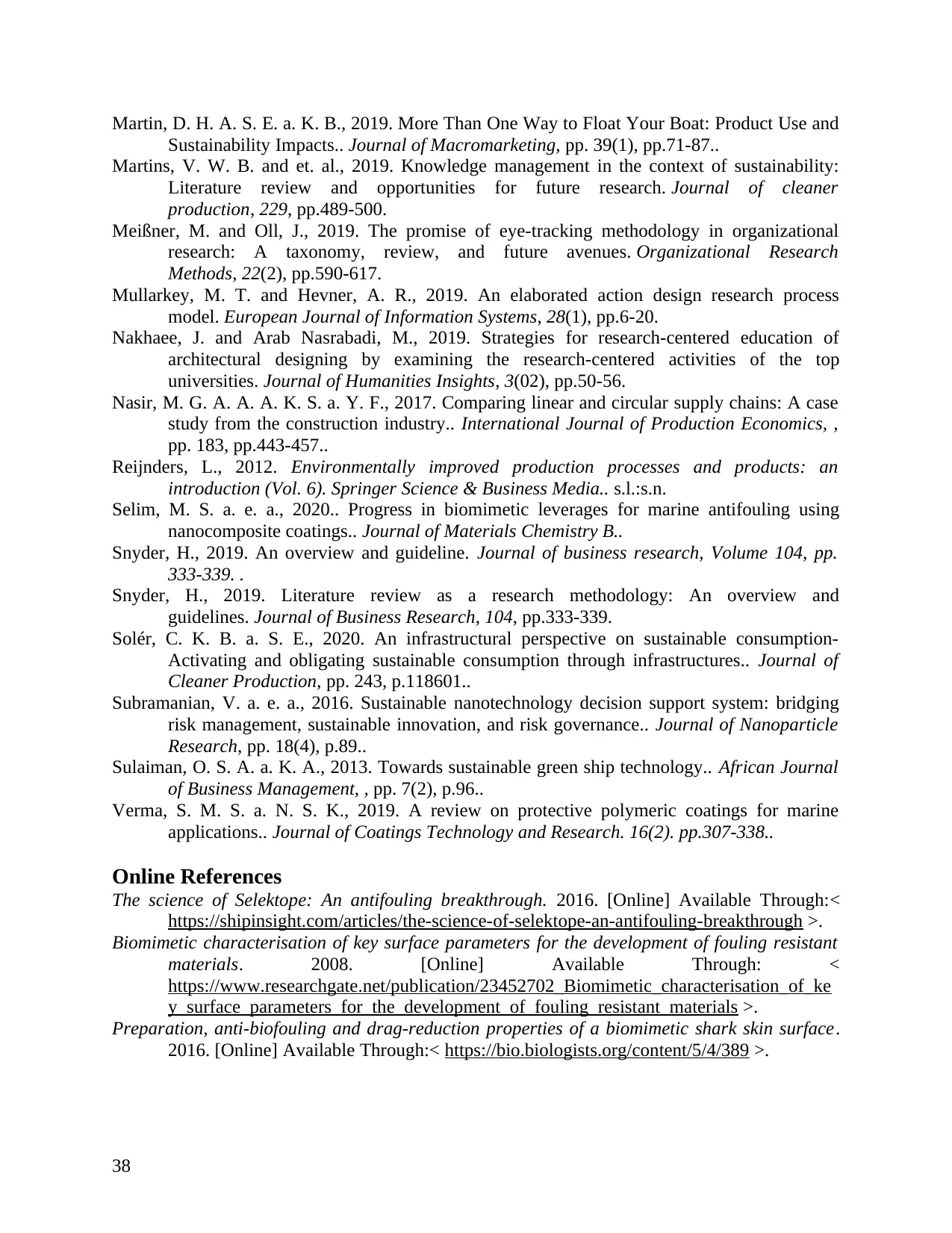
Martin, D. H. A. S. E. a. K. B., 2019. More Than One Way to Float Your Boat: Product Use and
Sustainability Impacts.. Journal of Macromarketing, pp. 39(1), pp.71-87..
Martins, V. W. B. and et. al., 2019. Knowledge management in the context of sustainability:
Literature review and opportunities for future research. Journal of cleaner
production, 229, pp.489-500.
Meißner, M. and Oll, J., 2019. The promise of eye-tracking methodology in organizational
research: A taxonomy, review, and future avenues. Organizational Research
Methods, 22(2), pp.590-617.
Mullarkey, M. T. and Hevner, A. R., 2019. An elaborated action design research process
model. European Journal of Information Systems, 28(1), pp.6-20.
Nakhaee, J. and Arab Nasrabadi, M., 2019. Strategies for research-centered education of
architectural designing by examining the research-centered activities of the top
universities. Journal of Humanities Insights, 3(02), pp.50-56.
Nasir, M. G. A. A. A. K. S. a. Y. F., 2017. Comparing linear and circular supply chains: A case
study from the construction industry.. International Journal of Production Economics, ,
pp. 183, pp.443-457..
Reijnders, L., 2012. Environmentally improved production processes and products: an
introduction (Vol. 6). Springer Science & Business Media.. s.l.:s.n.
Selim, M. S. a. e. a., 2020.. Progress in biomimetic leverages for marine antifouling using
nanocomposite coatings.. Journal of Materials Chemistry B..
Snyder, H., 2019. An overview and guideline. Journal of business research, Volume 104, pp.
333-339. .
Snyder, H., 2019. Literature review as a research methodology: An overview and
guidelines. Journal of Business Research, 104, pp.333-339.
Solér, C. K. B. a. S. E., 2020. An infrastructural perspective on sustainable consumption-
Activating and obligating sustainable consumption through infrastructures.. Journal of
Cleaner Production, pp. 243, p.118601..
Subramanian, V. a. e. a., 2016. Sustainable nanotechnology decision support system: bridging
risk management, sustainable innovation, and risk governance.. Journal of Nanoparticle
Research, pp. 18(4), p.89..
Sulaiman, O. S. A. a. K. A., 2013. Towards sustainable green ship technology.. African Journal
of Business Management, , pp. 7(2), p.96..
Verma, S. M. S. a. N. S. K., 2019. A review on protective polymeric coatings for marine
applications.. Journal of Coatings Technology and Research. 16(2). pp.307-338..
Online References
The science of Selektope: An antifouling breakthrough. 2016. [Online] Available Through:<
https://shipinsight.com/articles/the-science-of-selektope-an-antifouling-breakthrough >.
Biomimetic characterisation of key surface parameters for the development of fouling resistant
materials. 2008. [Online] Available Through: <
https://www.researchgate.net/publication/23452702_Biomimetic_characterisation_of_ke
y_surface_parameters_for_the_development_of_fouling_resistant_materials >.
Preparation, anti-biofouling and drag-reduction properties of a biomimetic shark skin surface.
2016. [Online] Available Through:< https://bio.biologists.org/content/5/4/389 >.
38
Sustainability Impacts.. Journal of Macromarketing, pp. 39(1), pp.71-87..
Martins, V. W. B. and et. al., 2019. Knowledge management in the context of sustainability:
Literature review and opportunities for future research. Journal of cleaner
production, 229, pp.489-500.
Meißner, M. and Oll, J., 2019. The promise of eye-tracking methodology in organizational
research: A taxonomy, review, and future avenues. Organizational Research
Methods, 22(2), pp.590-617.
Mullarkey, M. T. and Hevner, A. R., 2019. An elaborated action design research process
model. European Journal of Information Systems, 28(1), pp.6-20.
Nakhaee, J. and Arab Nasrabadi, M., 2019. Strategies for research-centered education of
architectural designing by examining the research-centered activities of the top
universities. Journal of Humanities Insights, 3(02), pp.50-56.
Nasir, M. G. A. A. A. K. S. a. Y. F., 2017. Comparing linear and circular supply chains: A case
study from the construction industry.. International Journal of Production Economics, ,
pp. 183, pp.443-457..
Reijnders, L., 2012. Environmentally improved production processes and products: an
introduction (Vol. 6). Springer Science & Business Media.. s.l.:s.n.
Selim, M. S. a. e. a., 2020.. Progress in biomimetic leverages for marine antifouling using
nanocomposite coatings.. Journal of Materials Chemistry B..
Snyder, H., 2019. An overview and guideline. Journal of business research, Volume 104, pp.
333-339. .
Snyder, H., 2019. Literature review as a research methodology: An overview and
guidelines. Journal of Business Research, 104, pp.333-339.
Solér, C. K. B. a. S. E., 2020. An infrastructural perspective on sustainable consumption-
Activating and obligating sustainable consumption through infrastructures.. Journal of
Cleaner Production, pp. 243, p.118601..
Subramanian, V. a. e. a., 2016. Sustainable nanotechnology decision support system: bridging
risk management, sustainable innovation, and risk governance.. Journal of Nanoparticle
Research, pp. 18(4), p.89..
Sulaiman, O. S. A. a. K. A., 2013. Towards sustainable green ship technology.. African Journal
of Business Management, , pp. 7(2), p.96..
Verma, S. M. S. a. N. S. K., 2019. A review on protective polymeric coatings for marine
applications.. Journal of Coatings Technology and Research. 16(2). pp.307-338..
Online References
The science of Selektope: An antifouling breakthrough. 2016. [Online] Available Through:<
https://shipinsight.com/articles/the-science-of-selektope-an-antifouling-breakthrough >.
Biomimetic characterisation of key surface parameters for the development of fouling resistant
materials. 2008. [Online] Available Through: <
https://www.researchgate.net/publication/23452702_Biomimetic_characterisation_of_ke
y_surface_parameters_for_the_development_of_fouling_resistant_materials >.
Preparation, anti-biofouling and drag-reduction properties of a biomimetic shark skin surface.
2016. [Online] Available Through:< https://bio.biologists.org/content/5/4/389 >.
38
1 out of 38
Your All-in-One AI-Powered Toolkit for Academic Success.
+13062052269
info@desklib.com
Available 24*7 on WhatsApp / Email
![[object Object]](/_next/static/media/star-bottom.7253800d.svg)
Unlock your academic potential
© 2024 | Zucol Services PVT LTD | All rights reserved.

